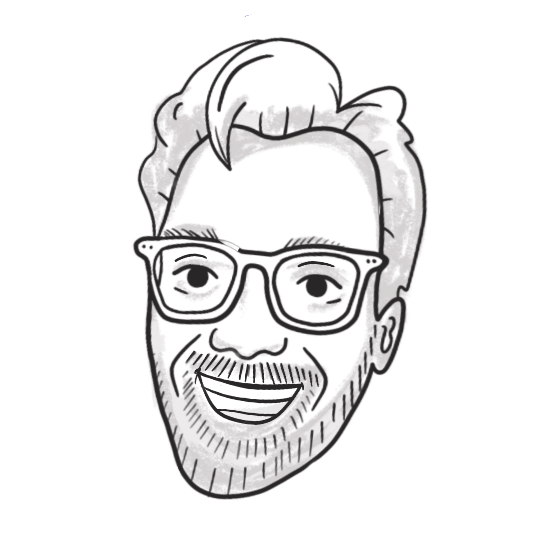My walk across Spain on the Camino Frances
The walk up to O Cebreiro, famously the steepest part of the Camino de Santiago, might be the coldest I have ever been.
My feet were completely soaked through, to the point that I could hear an audible squelch with every step. Rain dripped down my arm through the openings in my sleeves and my shorts were as wet as my shoes.
My glasses were covered in a thin layer of water drops, and the misty rain was so thick I could barely see 20 feet in front of me. The wind came in massive gusts, chilling me to the bone.
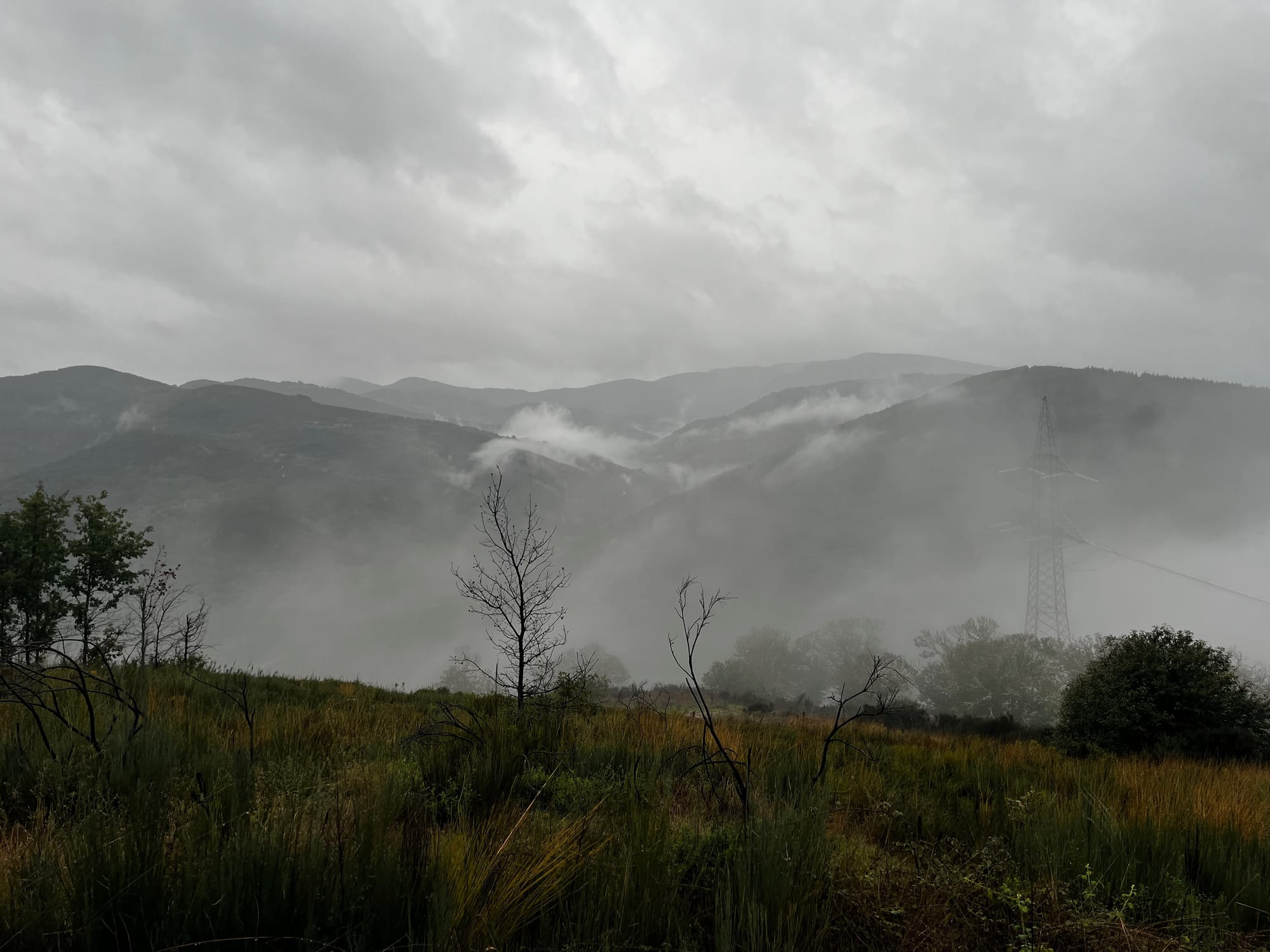
The hot days of the Meseta, surrounded by my friends singing pop songs at the top of our lungs, were long behind me. I was out on my own again and closing in on Galicia, the last region of my 500-mile trek across Spain. I told myself I would power through to O Cebreiro, and then I could stop to warm up.
But first I had to get over these mountains, and through this chill, relentless rain. Pole, step. Pole, step.
Slowly a small town came into view through the rain, and I approached a couple of fellow pilgrims coming out of a building. “Excuse me, which town is this?”
“O Cebreiro.”
Overjoyed, I stumbled into the bar behind them. I pulled off my pack and my wet jacket, and slunk into a seat. I didn't care at all that it was only 11am. I ordered a beer and started mentally preparing myself for the additional 10 miles I needed to walk today.
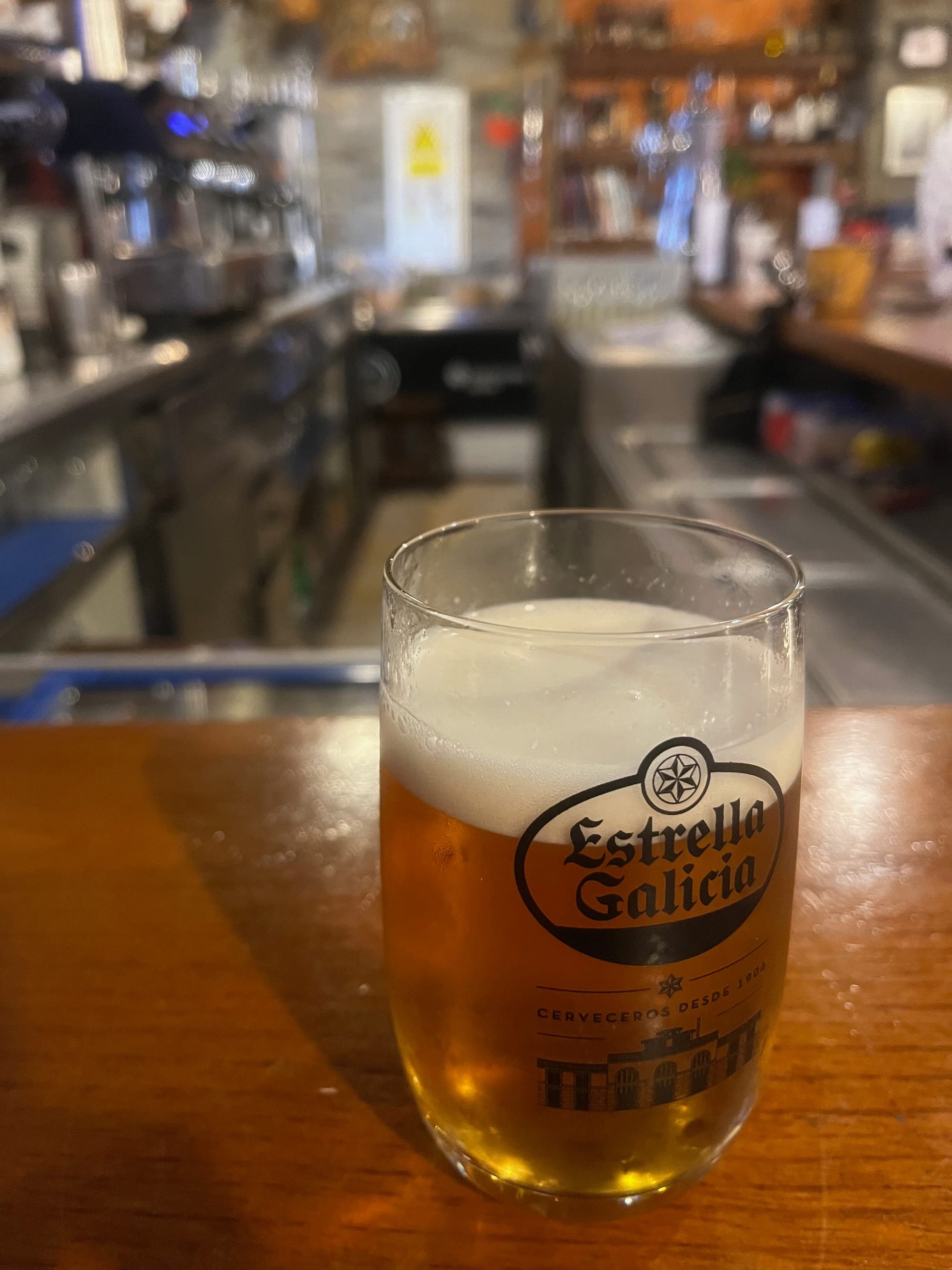
Suddenly the door is pulled open again, and I hear the wind howling and the rain falling in sheets. In the doorway is one of the massive Italians I had hung out with the night before, in shorts, a poncho, a hat, and neon, reflective racing glasses.
In an Italian accent he belts out, “HERE COMES THE SUN! DOO-D-DOO-DOO!”
Unbelievably, the bar full of tired pilgrims started cracking up, and before long we were all singing with him. The bar seemed to warm up as we sang. The cold and the rain didn’t feel so daunting. The miles ahead felt more approachable.
I’m not religious, and I don’t believe in magic. But the Camino provides. It doesn’t matter if you’re miles from town, in the middle of the Meseta. Or soaked to the bone in a bar on top of a mountain. The Camino provides.
On my Camino, I got blisters and a terrible cold. My feet were so sore I worried I had broken something, and I got wrecked by bed bugs. There were times like the walk up O Cebreiro where I was freezing cold, and others where I could feel my skin burning in the hot sun. And I absolutely loved it.
In this post, I will break down the trip, my major takeaways from the experience, and advice I have for other first-time pilgrims.
Here is some quick info from my trip:
- Route walked: Camino Frances
- Starting location: St. Jean Pied-de-Port
- Finish location: Negreira (I walked one day past Santiago before deciding I was done with the Galician rain and renting a car to go to Finisterre)
- Kilometers walked: 789km (490 miles)
- Days on the trail: 42
- Bed bug bites: 60+
- Weight lost: More than expected
- New friends: More than I can count
- Beers consumed: Way more than I can count
- Best things I ate: Pulpo (octopus), sweetbreads, and sopa de ajo (garlic soup)
- Favorite town: Castrojeriz
- Favorite city: Leon
If you want to learn more about the Camino de Santiago and what I did to prepare, check out my first post here. This is going to be a long one, so buckle up.
Starting alone
Getting to the starting point in St. Jean was my first hurdle.
I flew into Barcelona and took a train to Pamplona, but by the time I got there the only bus to St. Jean had left Pamplona for the day, and I had a reservation that night in St. Jean.
My plan was to take an expensive taxi and hope I found a kind pilgrim willing to share the fare with me.
As luck would have it, the very first pilgrim I met said yes. Maria was waiting in line for our train in the Barcelona train station. She was dressed in hiking apparel with a backpack, but no obvious Camino symbol.
I nervously worked up the courage to say something. Finally, I tapped her shoulder and said, “Disculpe. ¿Vas al Camino?” That is, “Excuse me. Are you going to the Camino.”
Not only was she a pilgrim, she was hoping to start in St. Jean, but wasn’t sure how she was going to get there. She excitedly agreed to share a cab.
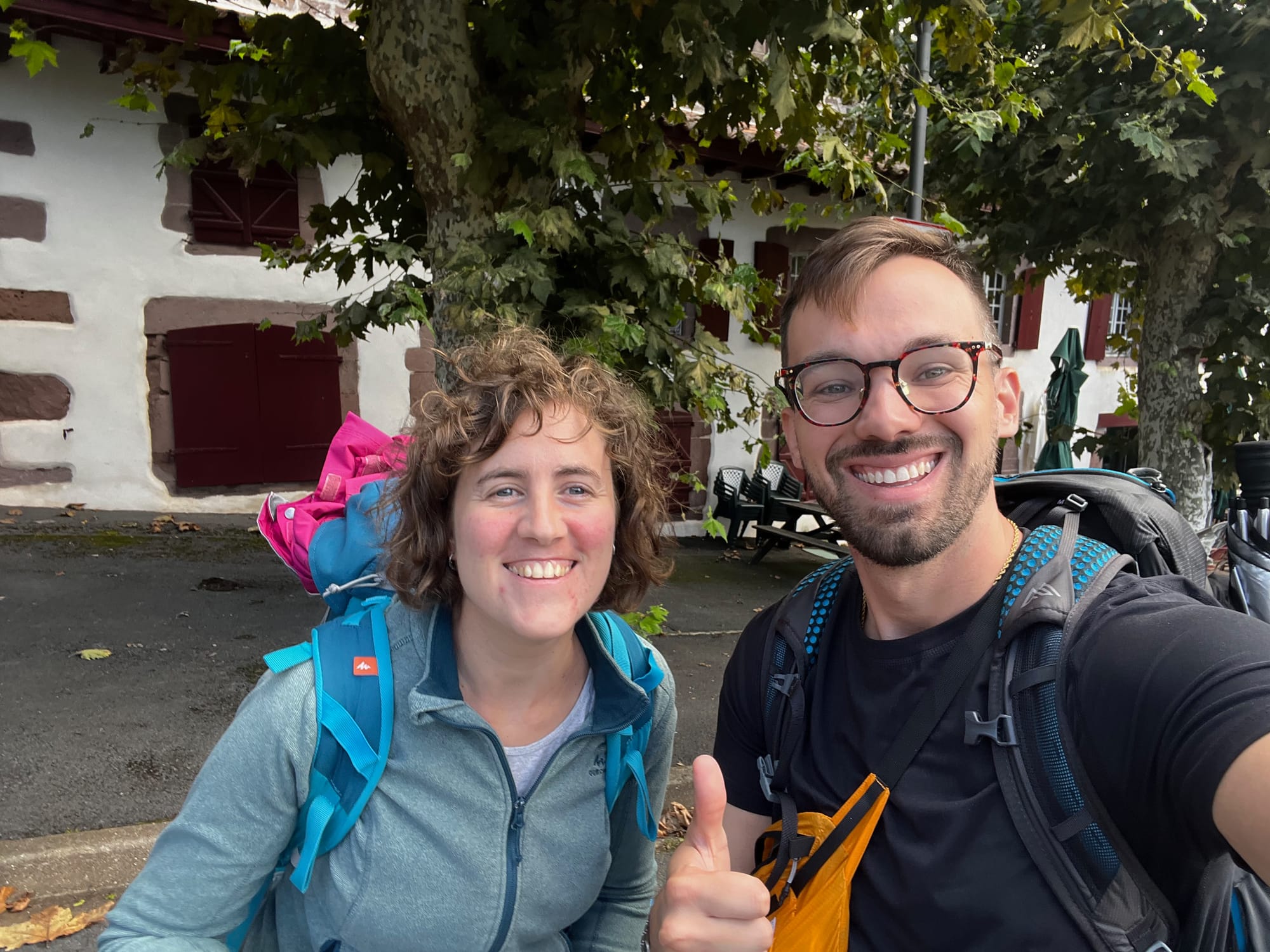
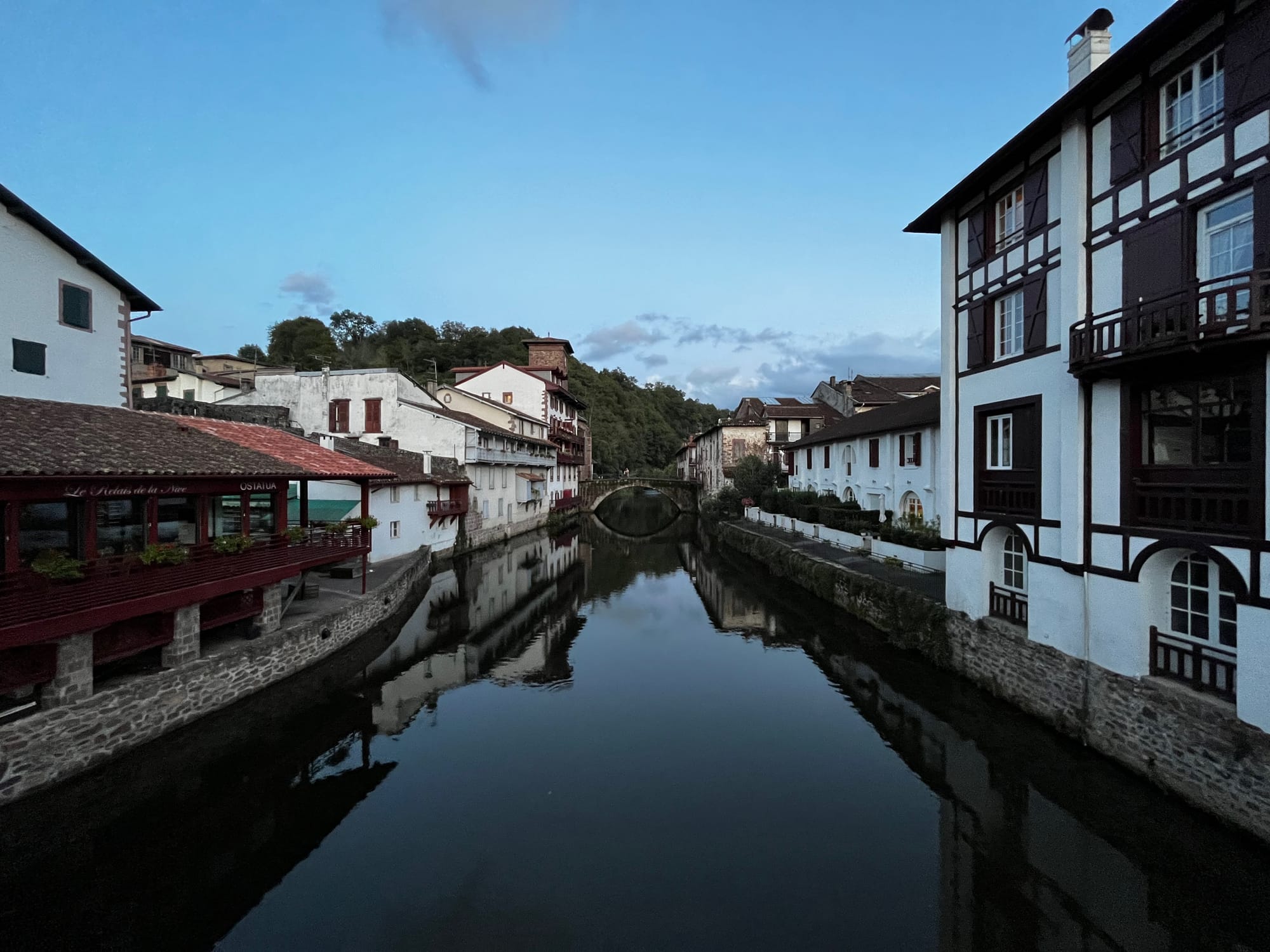
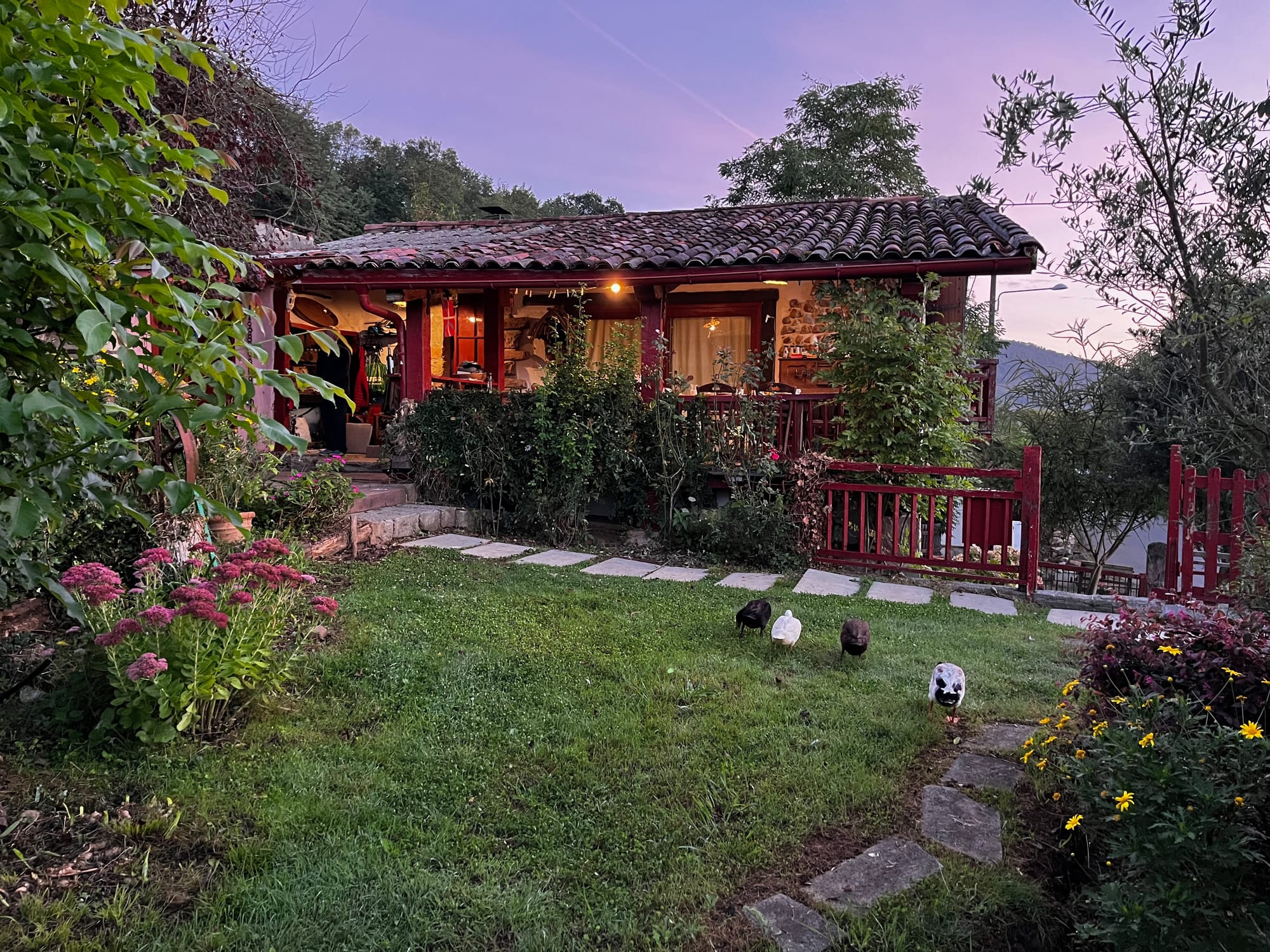
Left to right: Maria, the center of St. Jean, my first albergue on the Camino
This was my first time experiencing the Camino provide, and a second truth I would quickly learn. It’s easier to make friends on the Camino than it is to be alone.
The start of the Camino turned out to be the most beautiful section of the entire route. The walk through the Pyrenees was incredible. I had perfect weather, and each turn in the trail amazed me even more.
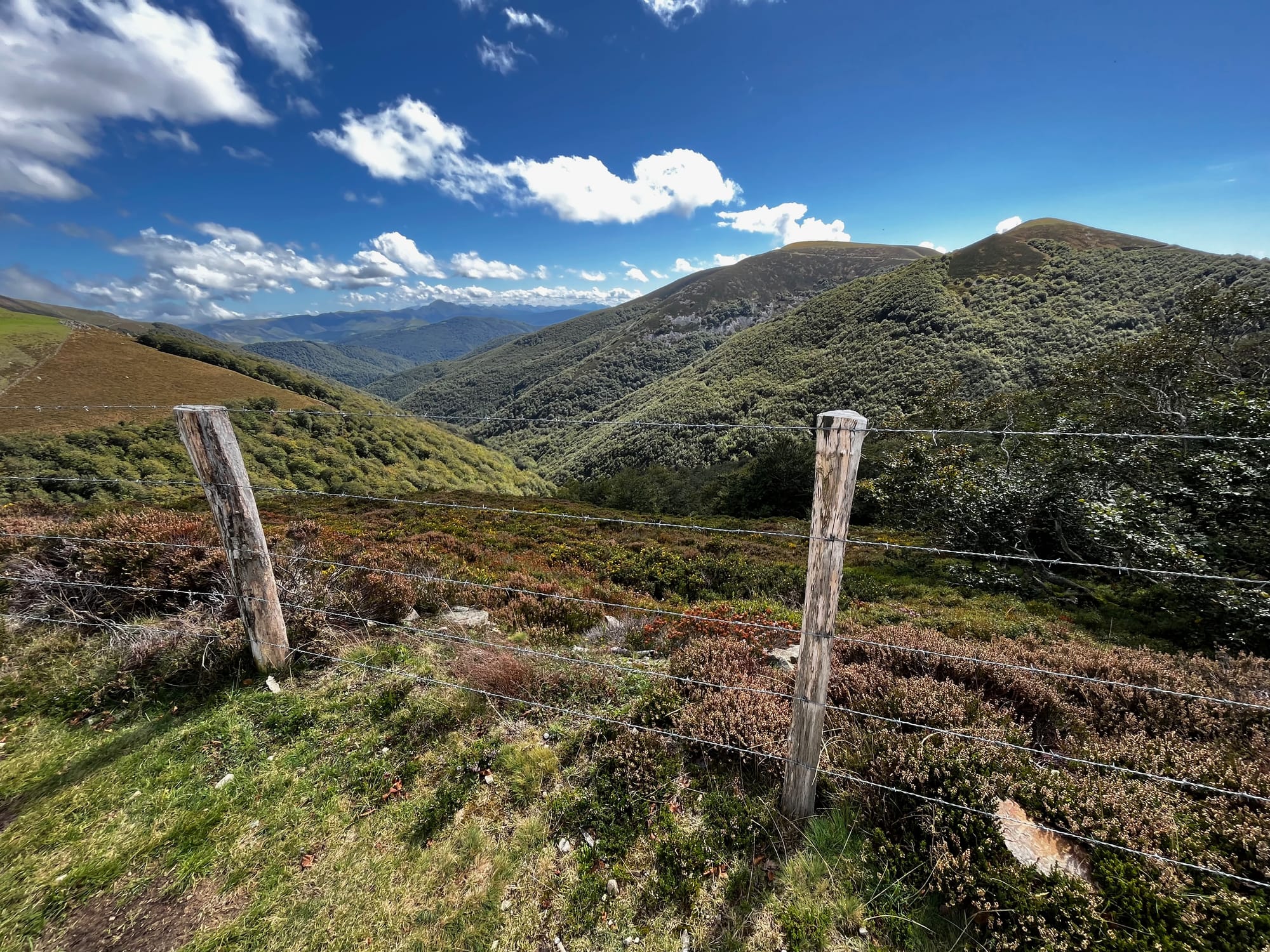
I walked my first few days alone, mostly staying in smaller, private albergues. I made new friends each night, and then each day along the trail. I walked several times with a German mom and teacher, met a professor from Arkansas who now lives in Taiwan teaching law, and spent a night organizing a big communal dinner and drinking wine on a stone bridge under the stars.
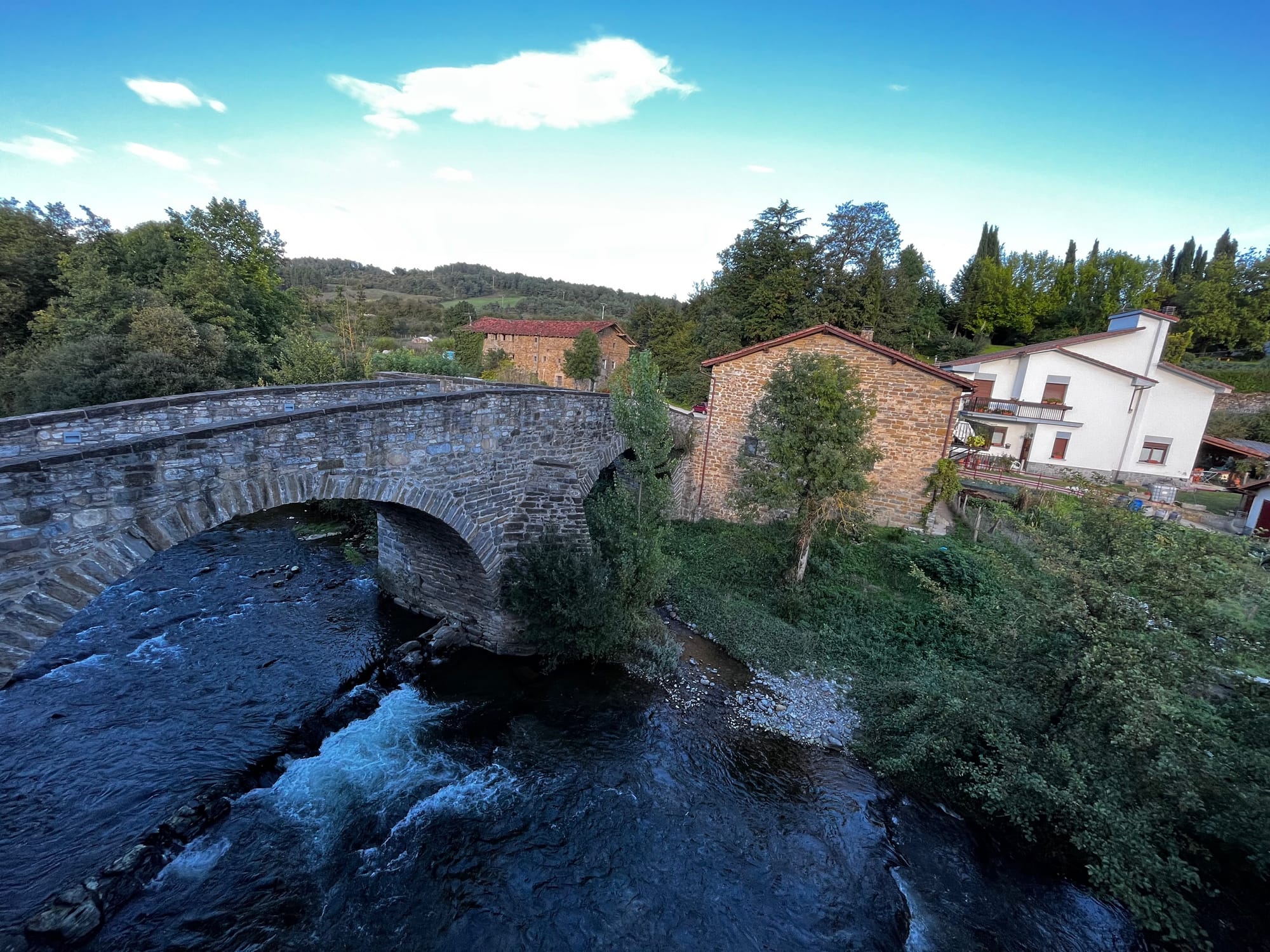
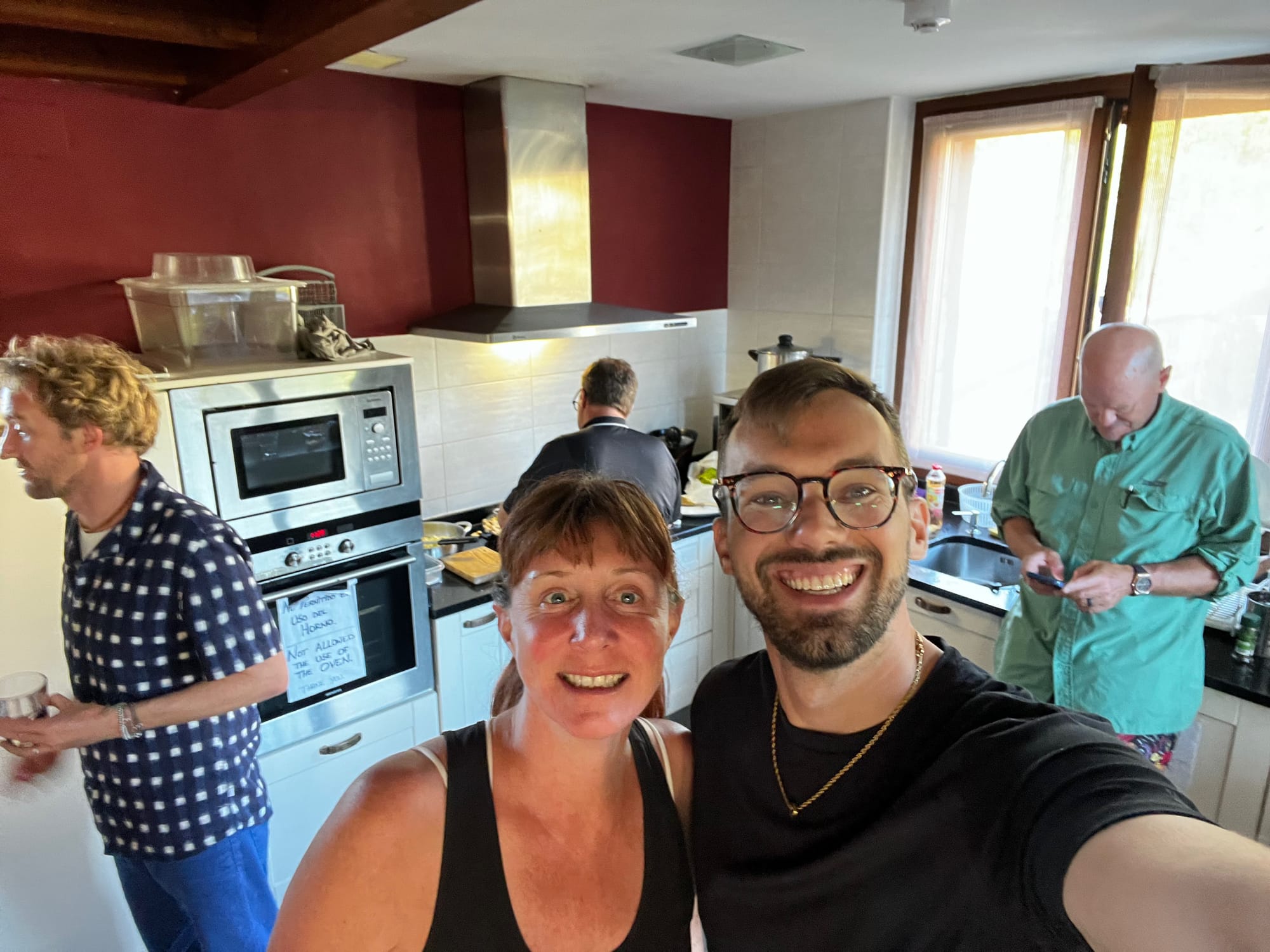
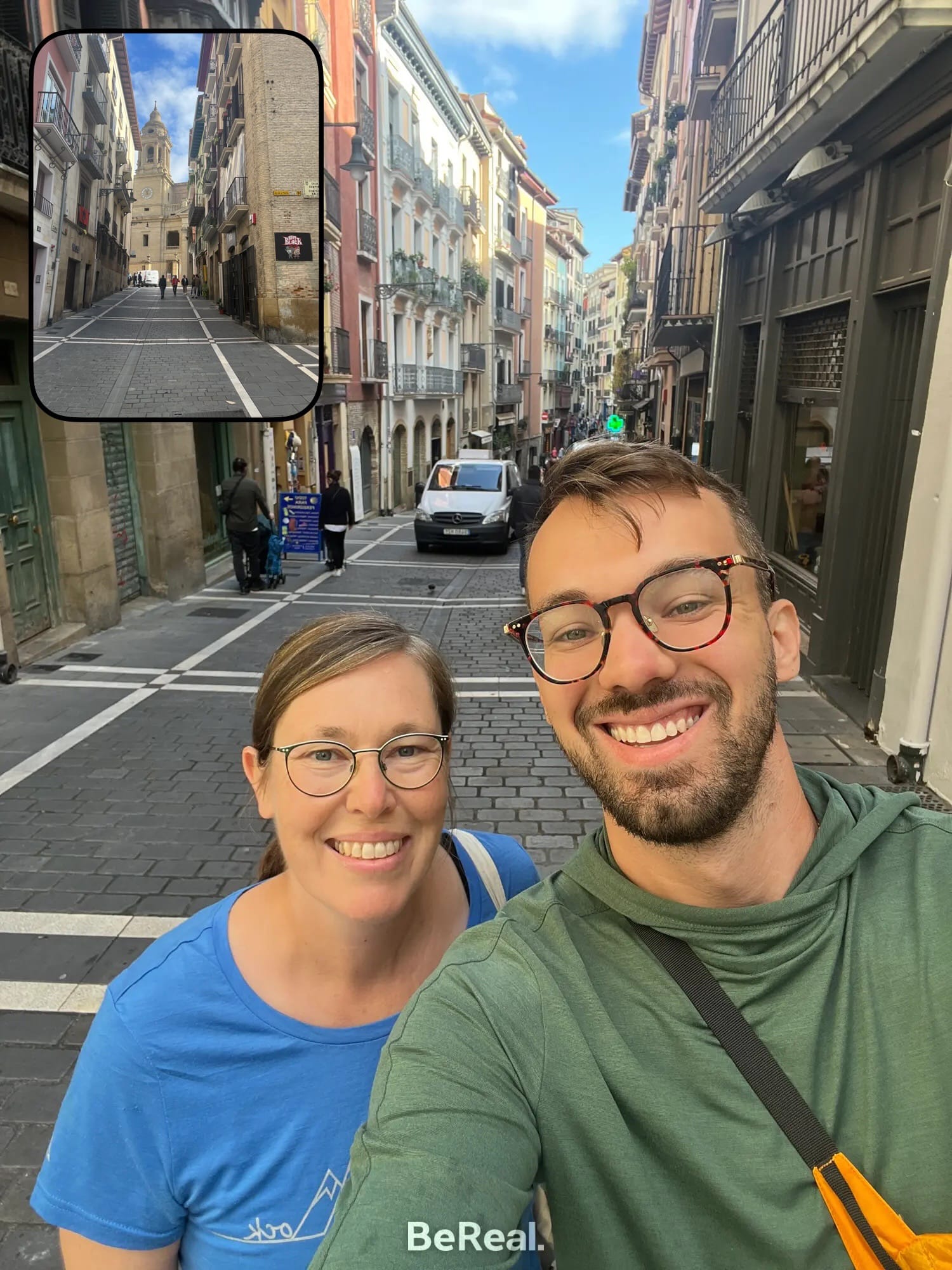
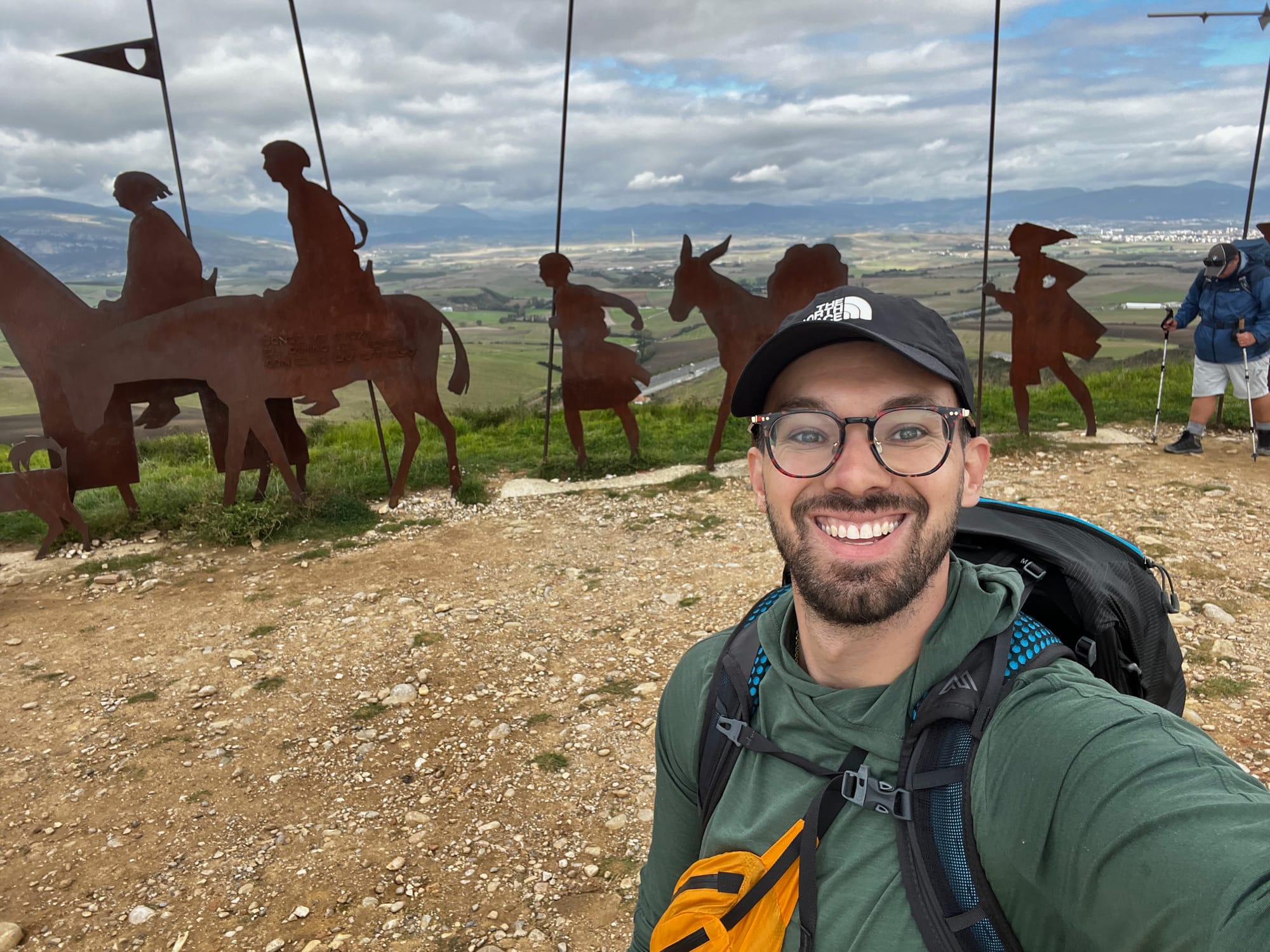
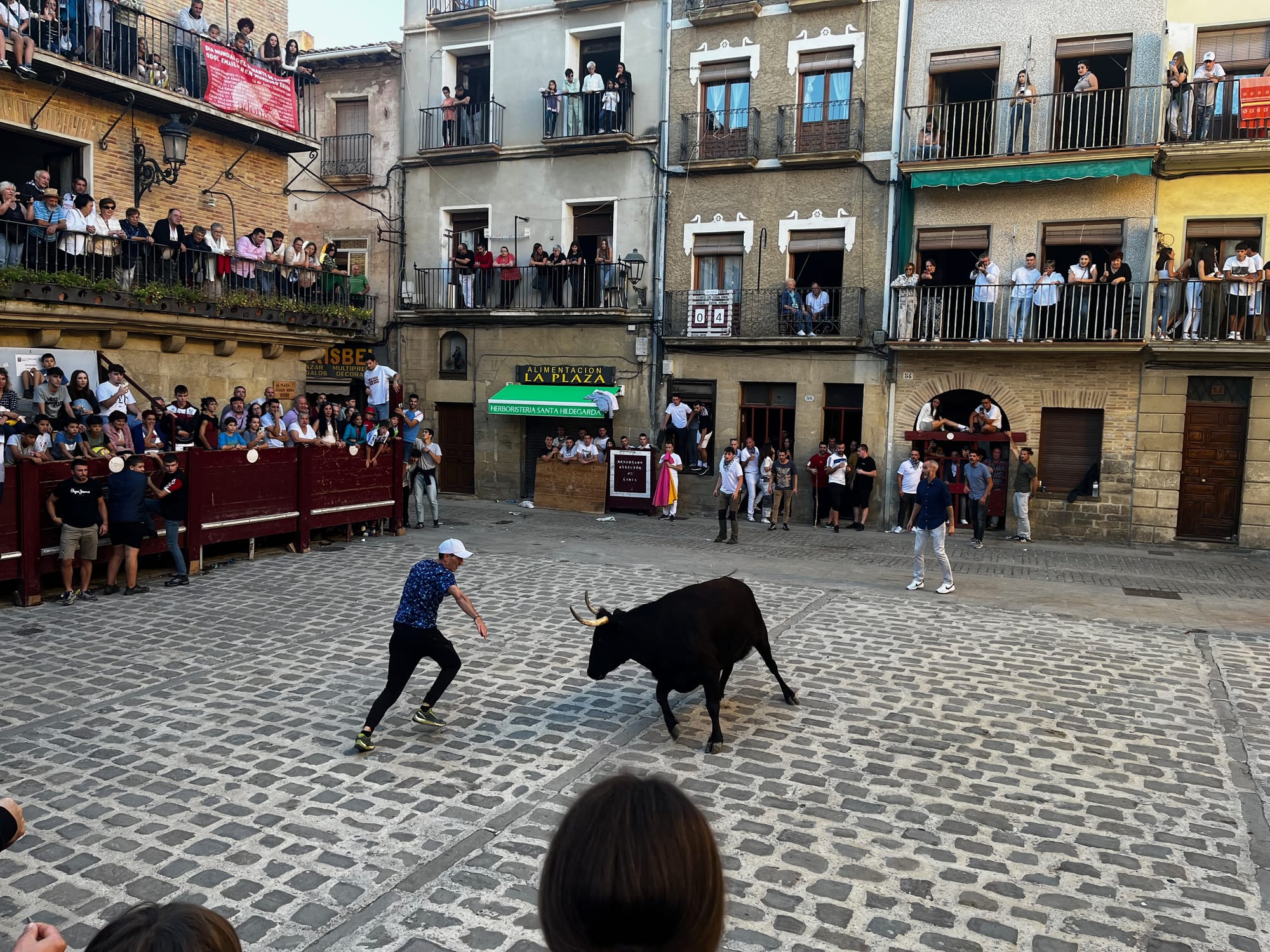
Clockwise: Zubiri, a communal dinner in Zubiri, Steffi - my German teacher friend, a running of the bulls festival, a famous sculpture on just past Pamplona
Finding my Camino family
I walked the majority of my Camino with my Camino family - a group of 8 ranging in age from 24-33. Three from the US, two from Poland, one from the UK, one from the Netherlands, and one from Italy.
I met Jay first. Jay is a 24-year-old primatologist from the UK, an amateur boxer, an avid chess player, and post-Camino was heading to the Democratic Republic of Congo to study Bonobos for 9 months. Jay is maybe the only person I met who never seemed to get tired. He would sleep for 2 hours, then happily walk past me the next morning as if it was nothing.
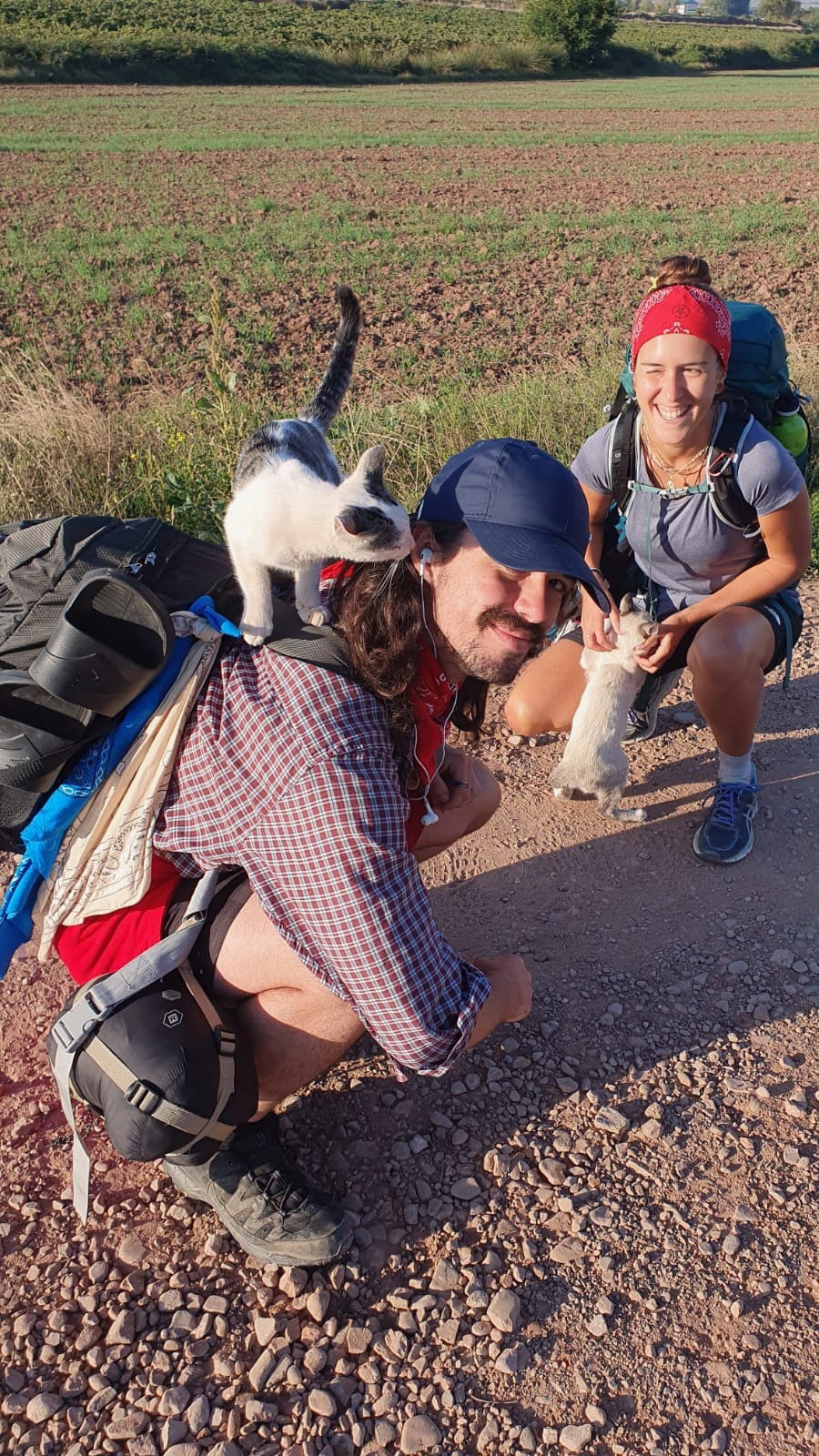
Jay and I added Femke to our little group after bumping into each other a couple of days in a row.
Femke is Dutch, but was born in Mexico and had lived in Peru and the Virgin Islands. She spoke fluent Spanish, Dutch, and English. Femke was adventurous, but thoughtful, always watching out for everyone else in the group. Her solution to getting massive blisters was to walk faster until she couldn’t feel the pain.
Next, Jay introduced us to Kuba. Kuba is Polish and a proud socialist. We spent countless hours annoying everyone with our political debates, but always came out liking each other even more. At first Kuba gave off the vibe that he wanted to walk his own walk, but he quickly fell in with us and became part of the family. He spoke fluent Spanish and Portuguese, and had a quiet confidence that was fascinating.
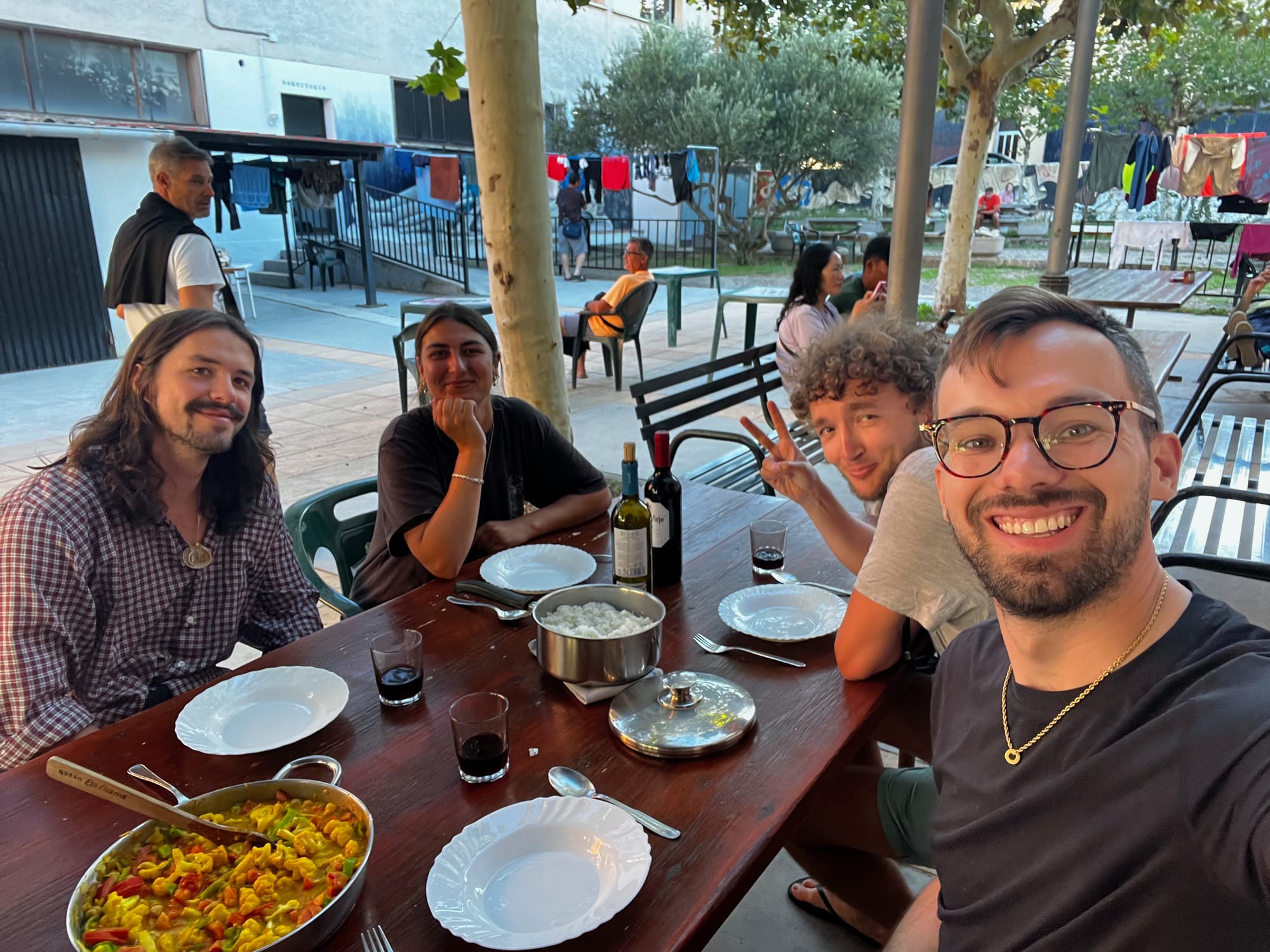
After Kuba, we pulled in Luis and Arianna with a card game in the albergue.
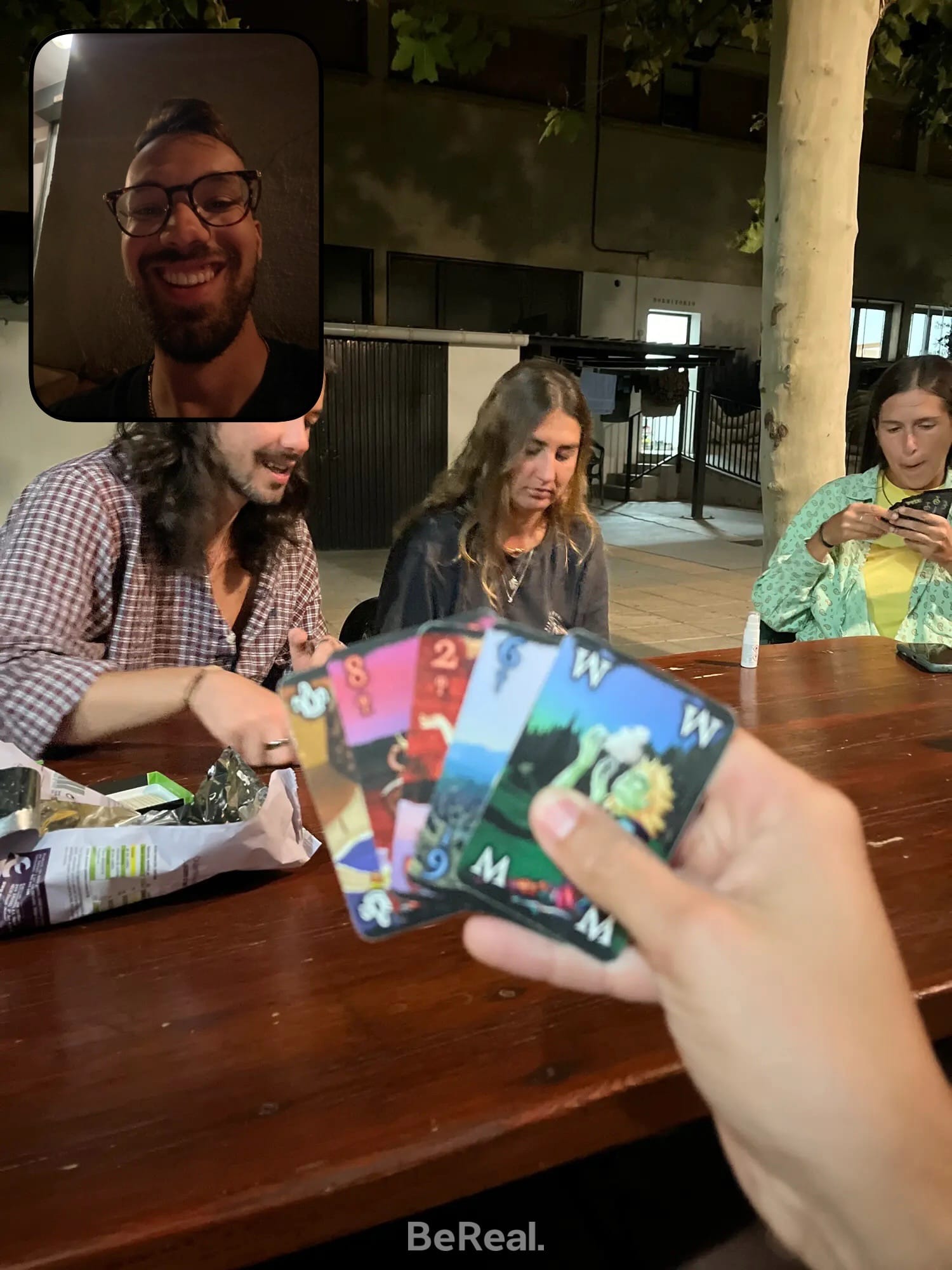
Luis is American but grew up in Mexico, Sri Lanka, and Switzerland. He was a former data scientist for Amazon. He spoke fluent English, Spanish, French, and a little bit of Tagalog, and quickly became our default translator. Luis and I cracked jokes and bonded over our love of food. Halfway through the Camino we shaved our scruffy beards and rocked matching mustaches the rest of the way.
Arianna, an aspiring jewelry designer from Italy, had limited English but always got her point across (often with lots of hand gestures and a pointed look). She was almost always at the front of the pack, no matter how much pain she was in. She loved to party, and roasted me constantly.
After Luis and Arianna, Olga and Sarah joined us last.
Kuba met Olga when they were bunkmates in a small town. They bonded quickly because they were both from Poland, and Kuba invited Olga to hang out with us. She became a core part of the group almost instantly. Olga has an incredible singing voice, is quick to laugh, and I expect she'll end up in a high-ranking position in the UN eventually.
Sarah, another American, is deeply passionate about helping those in need and is an avid birder who brought a heavy pair of binoculars with her on the trip. She walked the entire Camino in her Tevas after her hiking shoes gave her brutal blisters, but that didn’t stop her from happily walking as far as anyone was willing to go.
The public albergues most of us stayed in would almost always close their doors at 10. The first night that we all hung out together as a group we went to a local bar and stayed out drinking with the owner until 10:01.
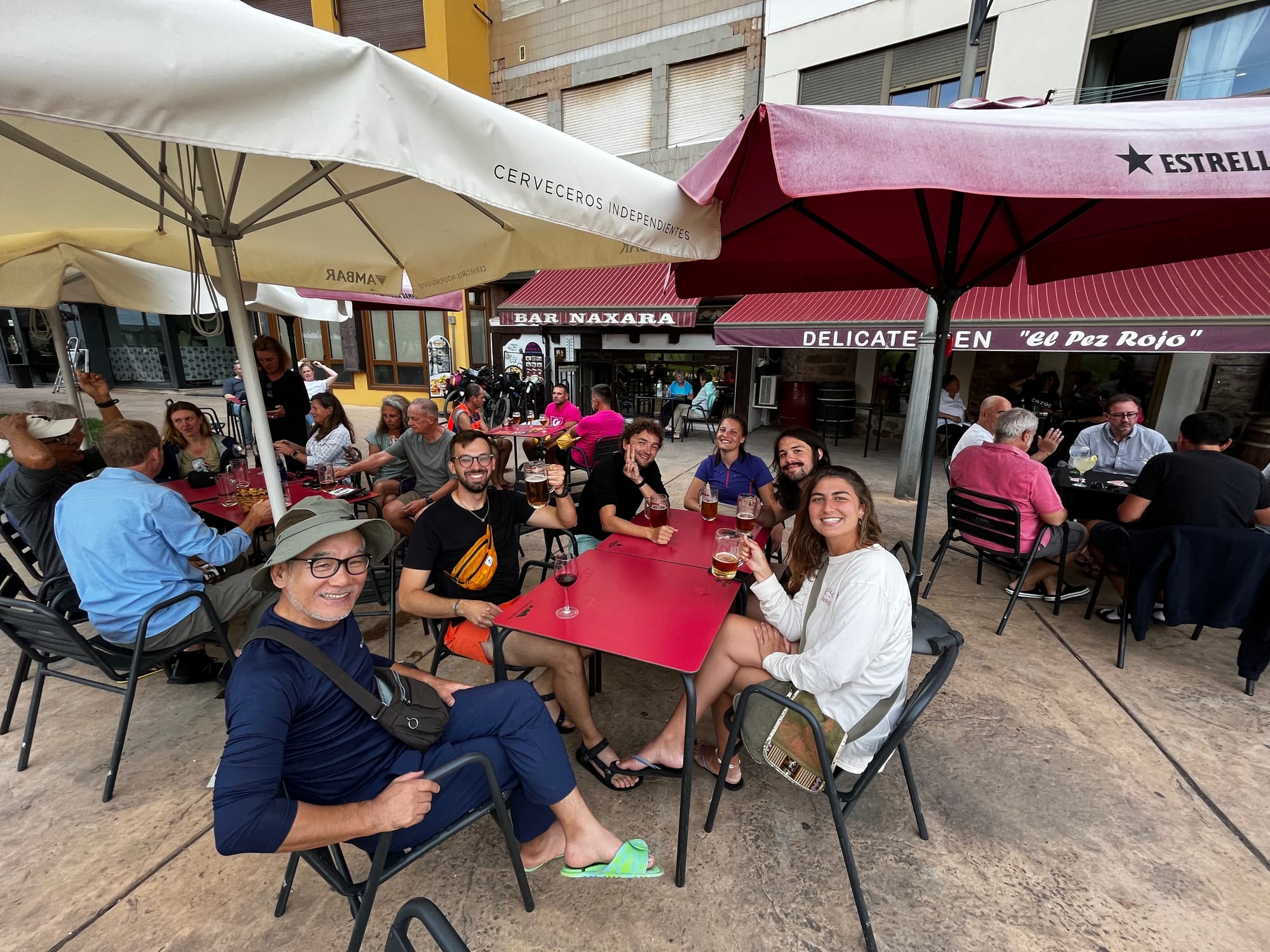
From then on, we were a crew.
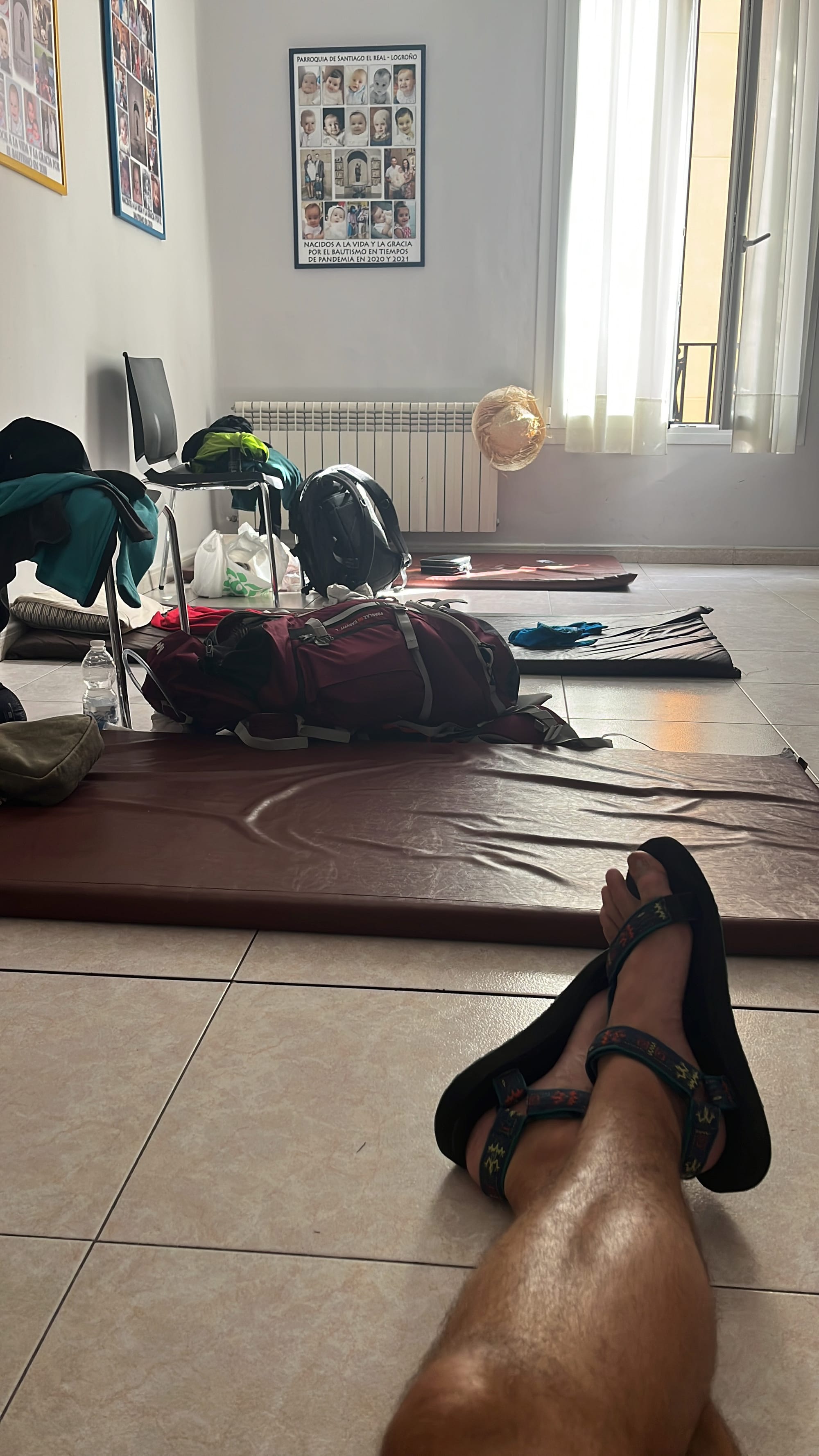
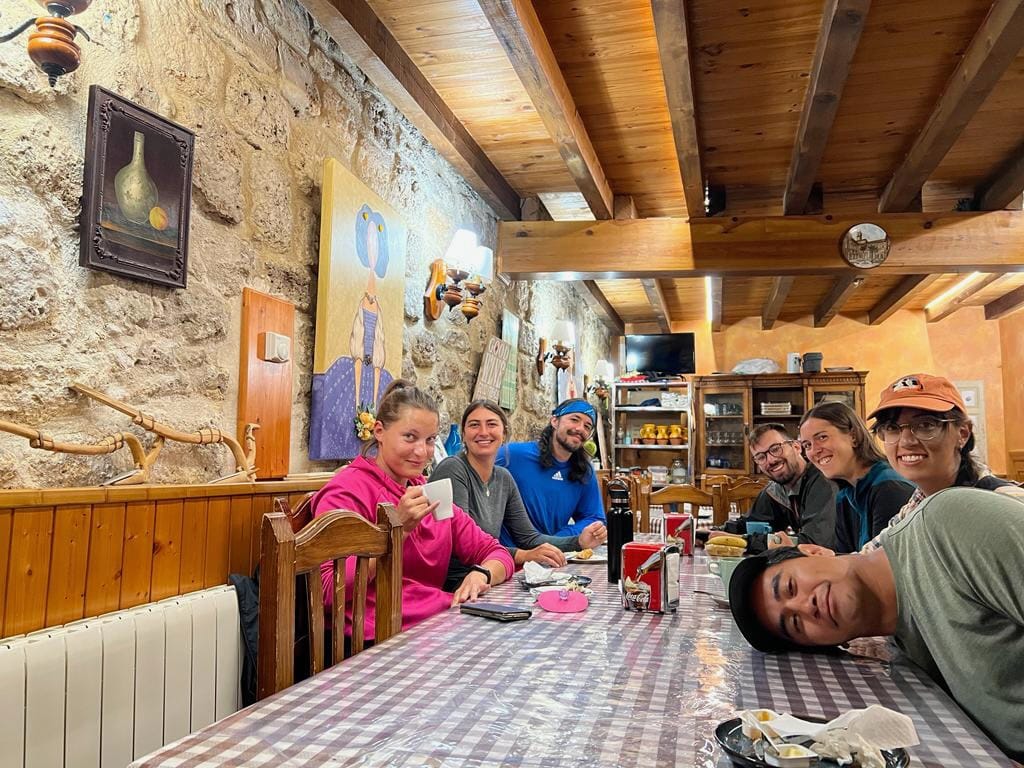
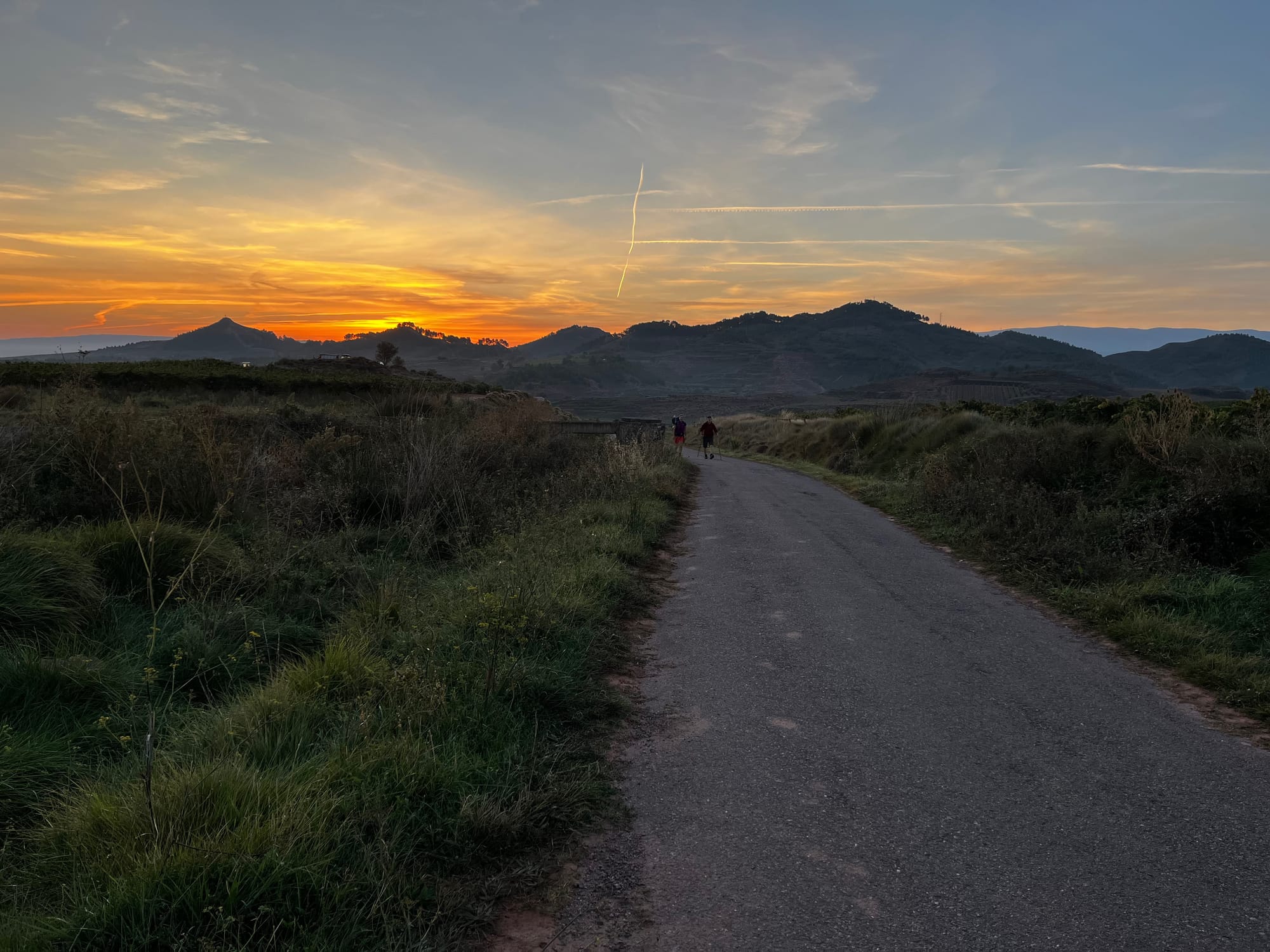
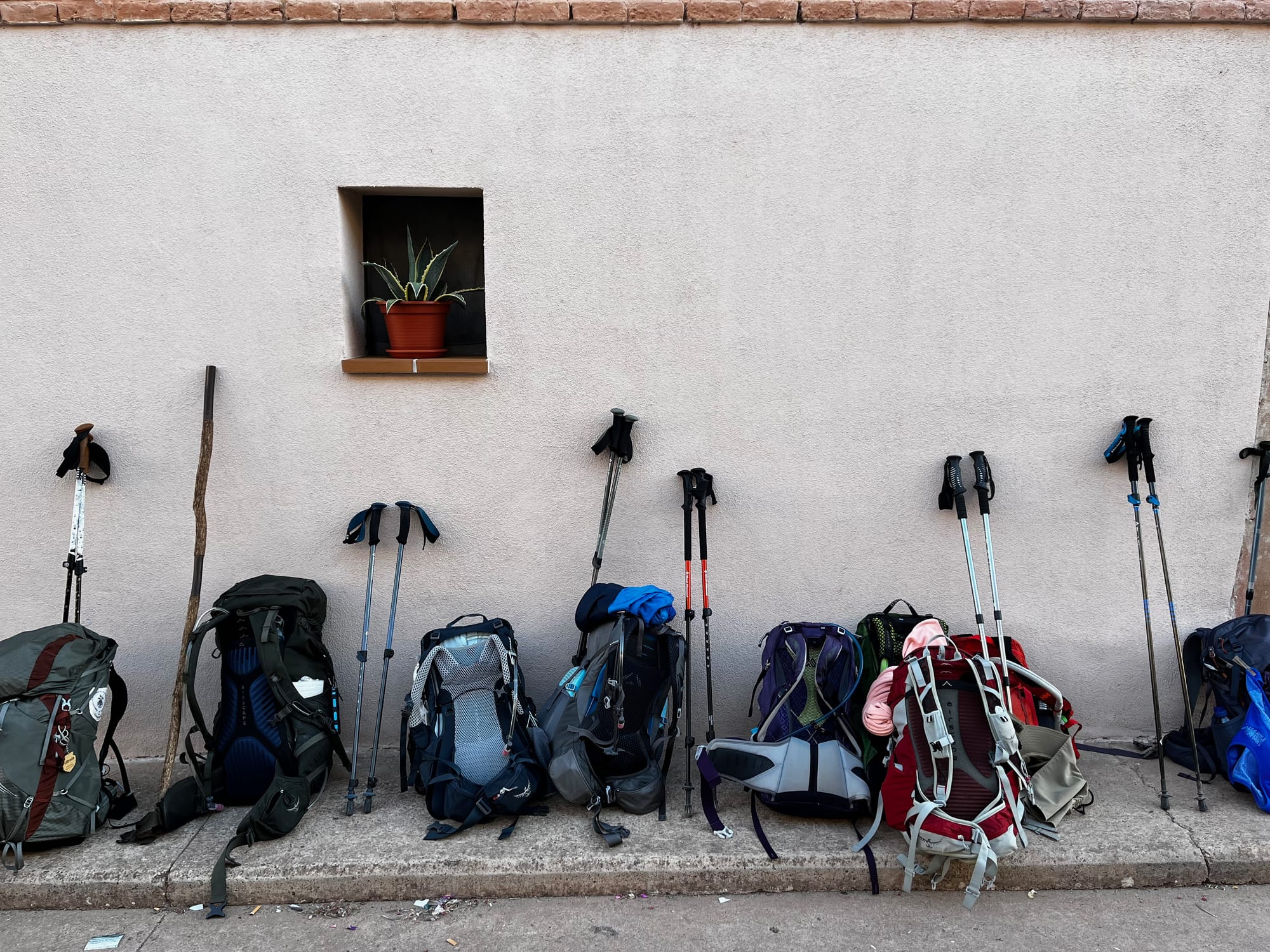
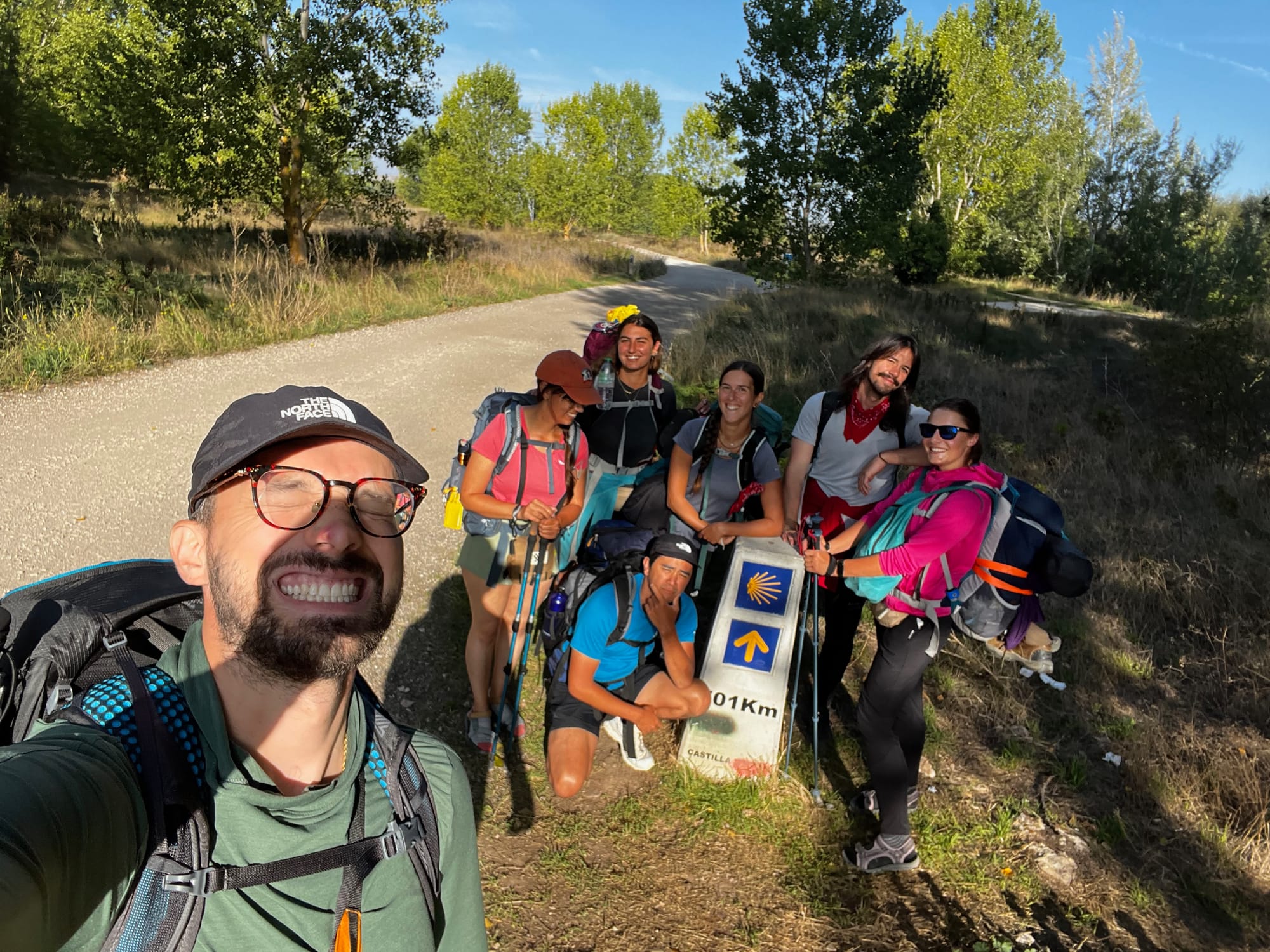
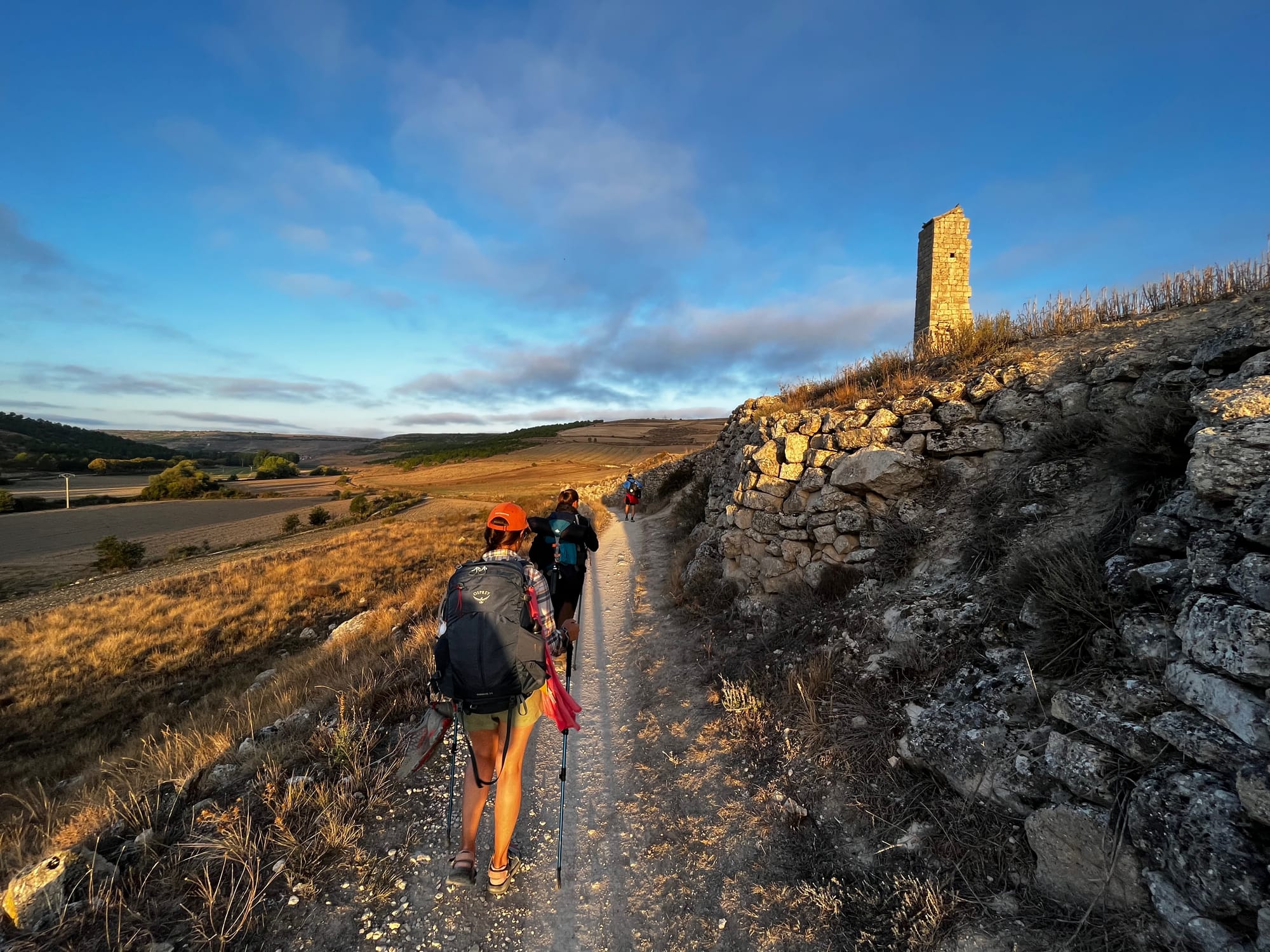
Clockwise: a donativo in Logroño, an early morning breakfast in Hontanas, a beautiful sunrise on the Meseta, an early morning on the Meseta, crossing the 500km mark, our packs outside a cafe
Our group liked to walk fast and far despite my frequent protests. I figured I would max out at 15-20km going into my Camino. The group wasn’t typically happy unless we had done at least 25km, and the longest day I pulled was 34km.
I couldn’t sustain that pace because I had a lot of time to kill before meeting my sister in Sarria and I didn’t want to get there too fast. Then I got sick as we were pulling some of our longest days. Despite my complaining, I couldn’t bring myself to leave my new friends, so we walked together for nearly 3 weeks.
Along the way we played ferocious card games, cooked dinner together whenever we could, sang pop songs at the top of our lungs, and stayed up as late as we could get away with cracking jokes and telling stories.
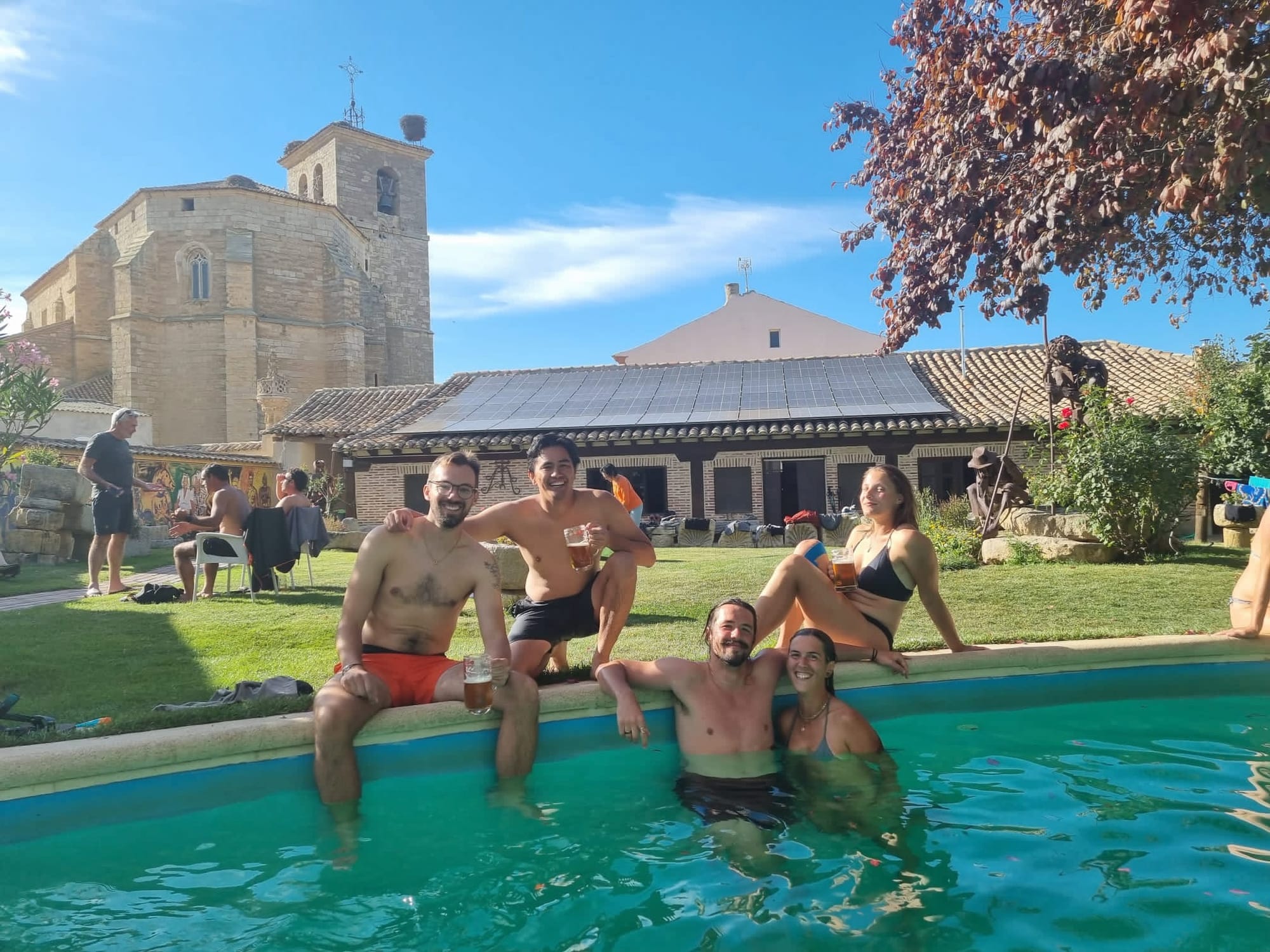
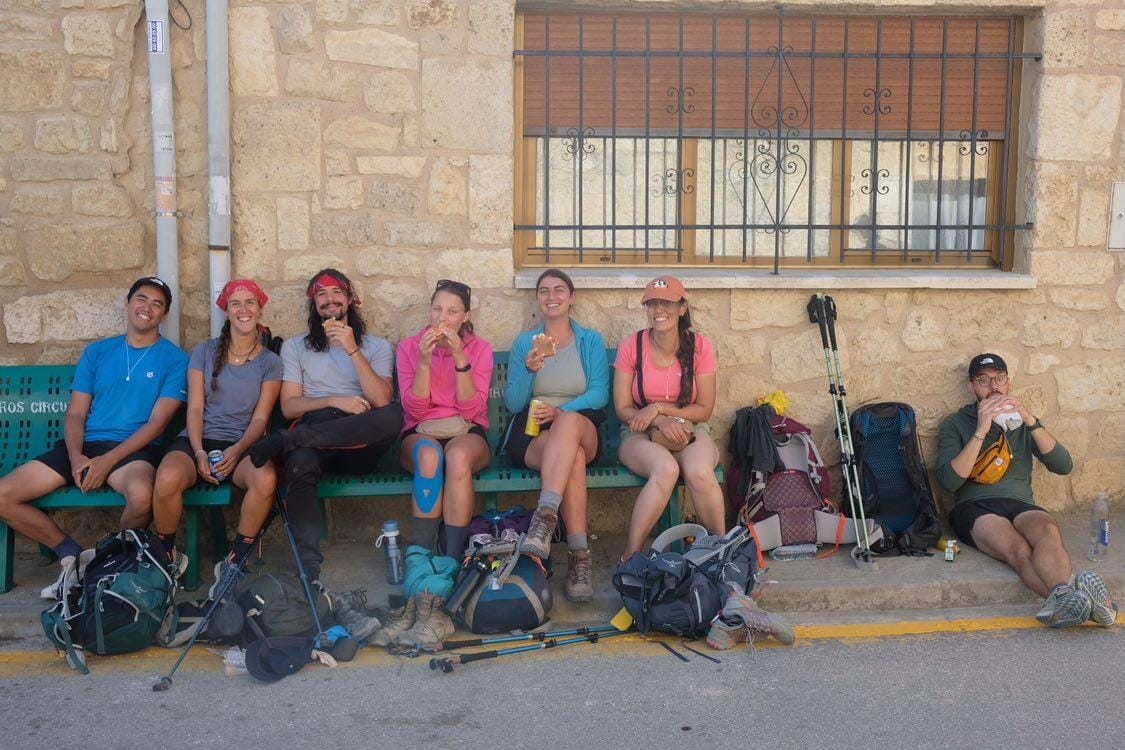
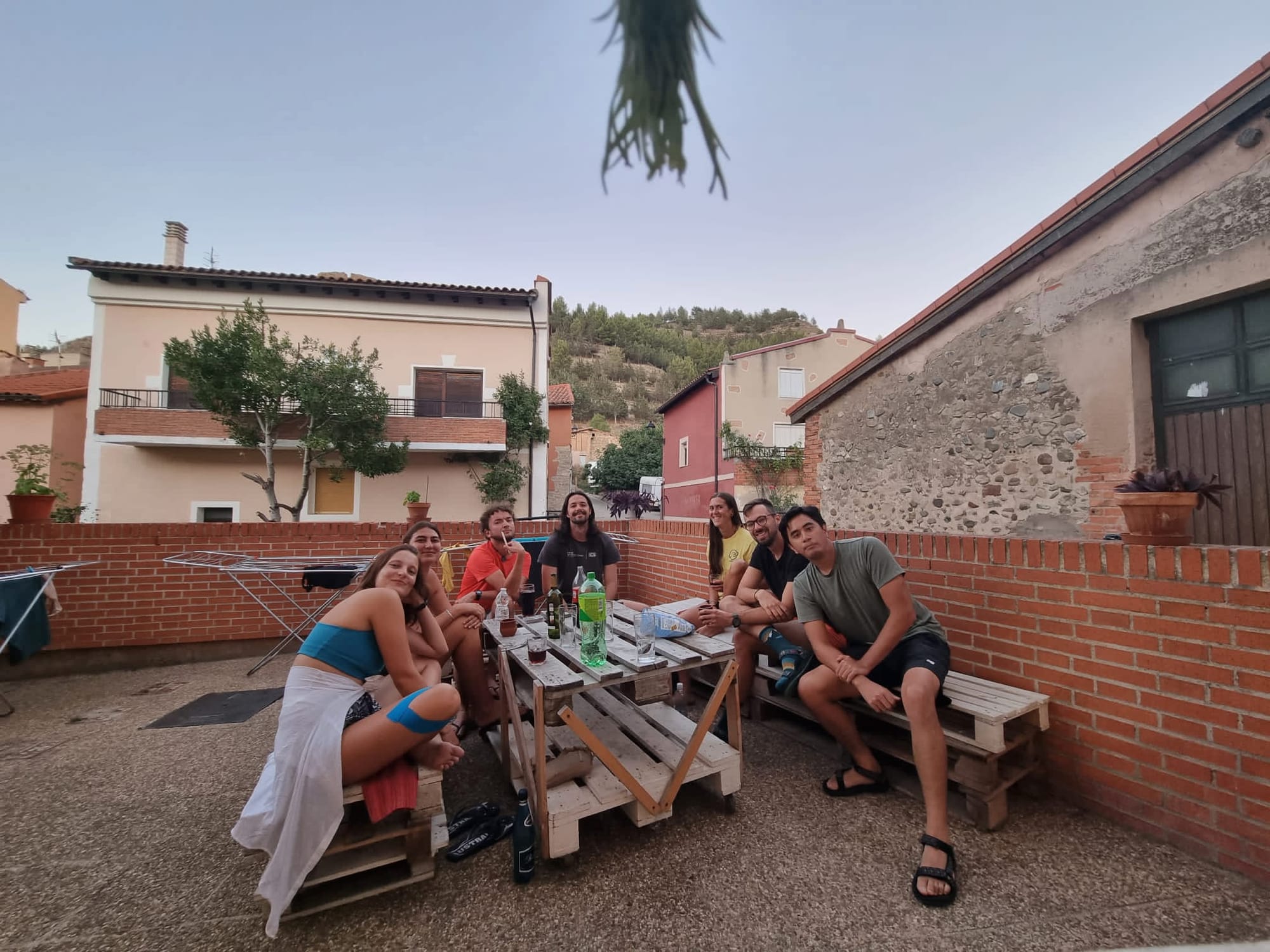
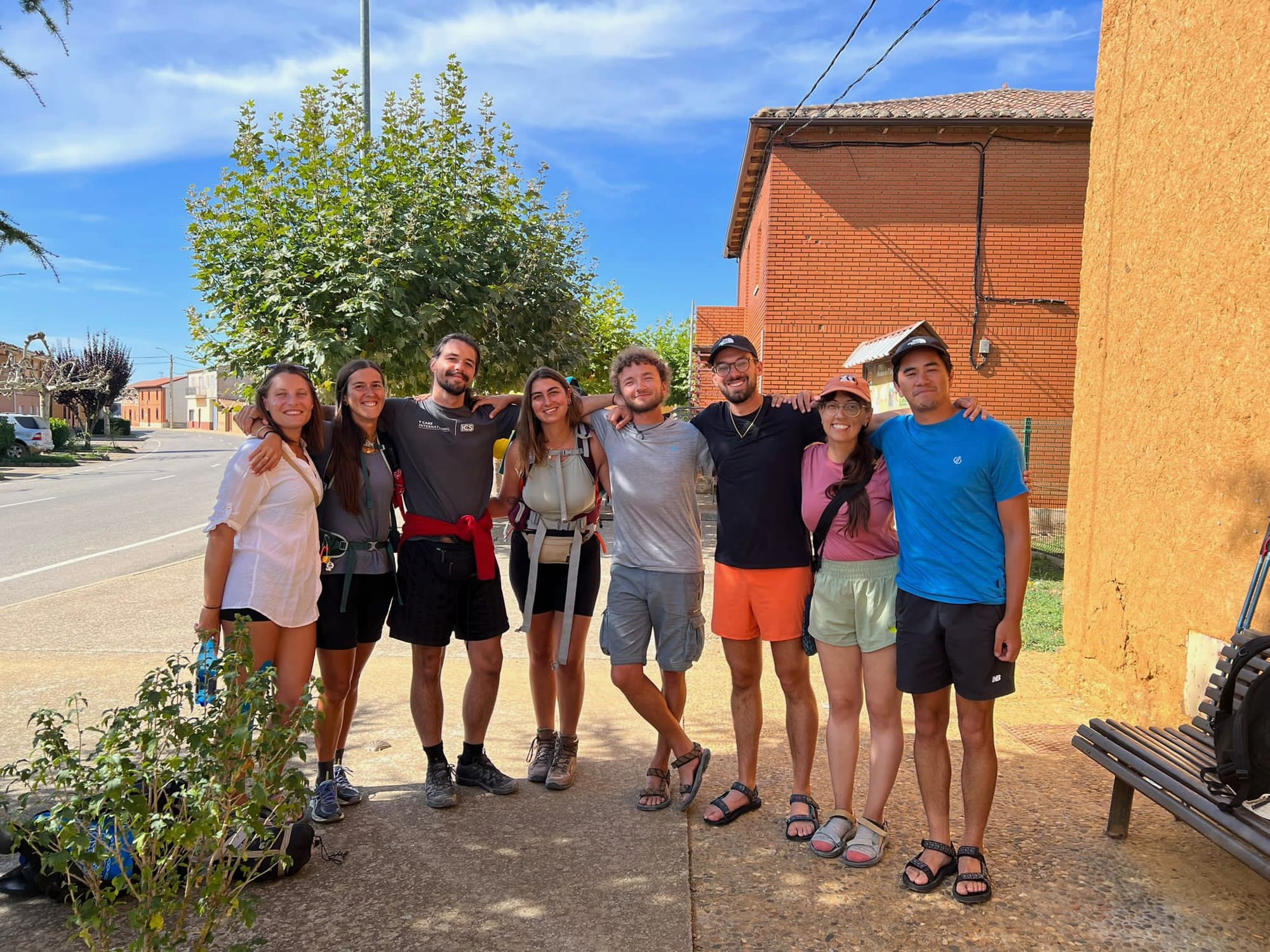
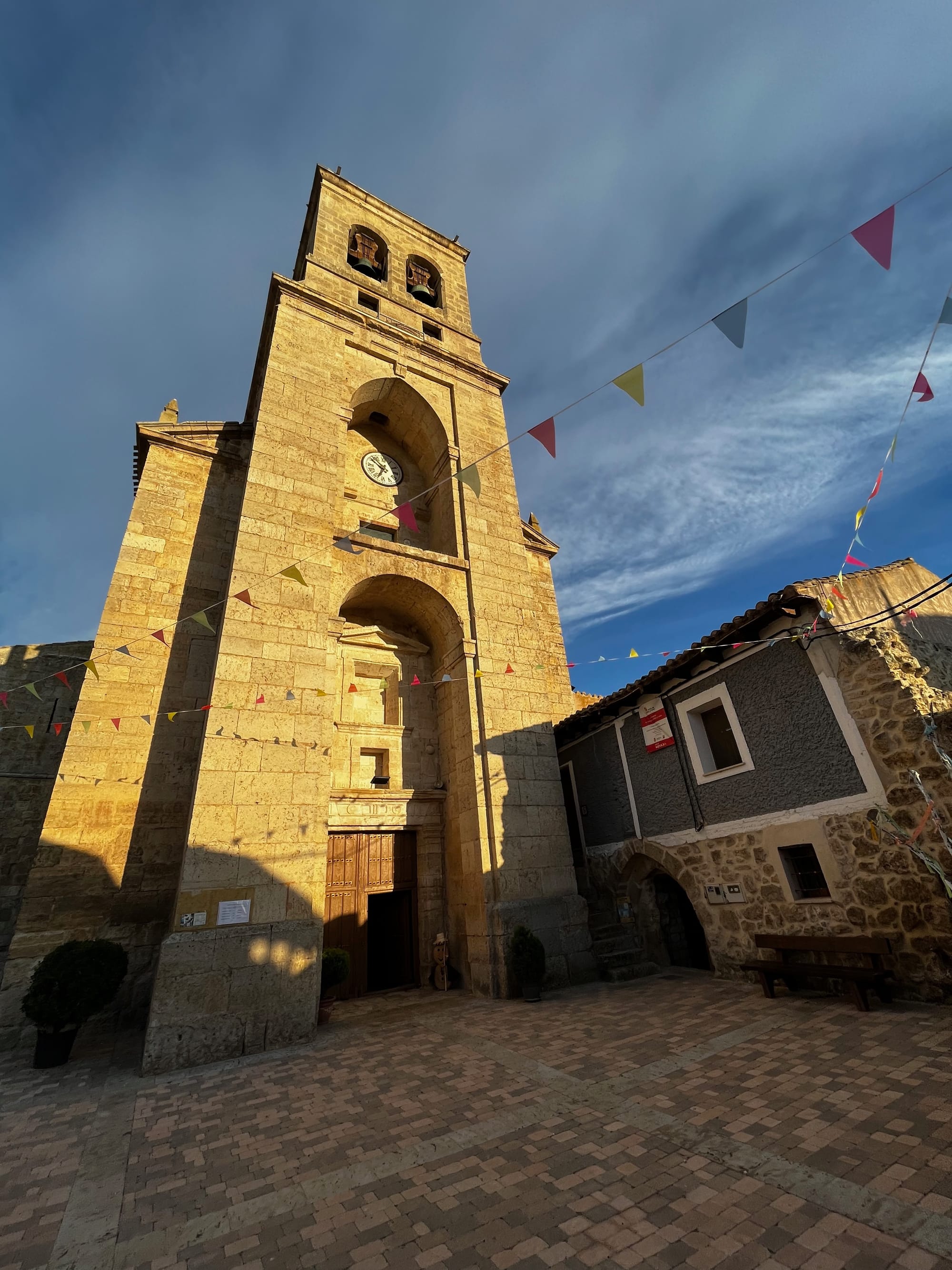
Clockwise: walking up a steep hill on the Meseta, relaxing in a pool with everyone, tiredly grabbing a bite to eat before walking more, the church in Hontanas after our longest day on the trail, our whole crew on our last day together, relaxing with Tinto de Verano and Calimocho
And of course, we made more friends along the way. Sunny from Korea, Akari from Japan (back home she drove around the Japanese countryside selling coffee from a truck she built herself), Chinmay and Lachie from Australia, Maik and Valerie from Germany, Lara from Ireland.
There were too many to list them all here. Everyone had a story to tell, and no one had a job to go back to. Of the 8 of us walking together, only one (Jay) had a job lined up after the Camino. The rest of us were in a period of transition, and this was true for most of our others friends as well.
As we were crossing the Meseta, the long, hot middle section of the Camino where towns and shade become more and more rare, my friend Ramy came down from the UK and joined our crew. He walked with us for three days, and fell in instantly with my friends. It was so much fun to see the Camino through his eyes. I had been researching it for so long, and everything had so quickly became normal, but he knew almost nothing about it before meeting up with me. It gave me a fresh perspective, and a new appreciation for the journey.
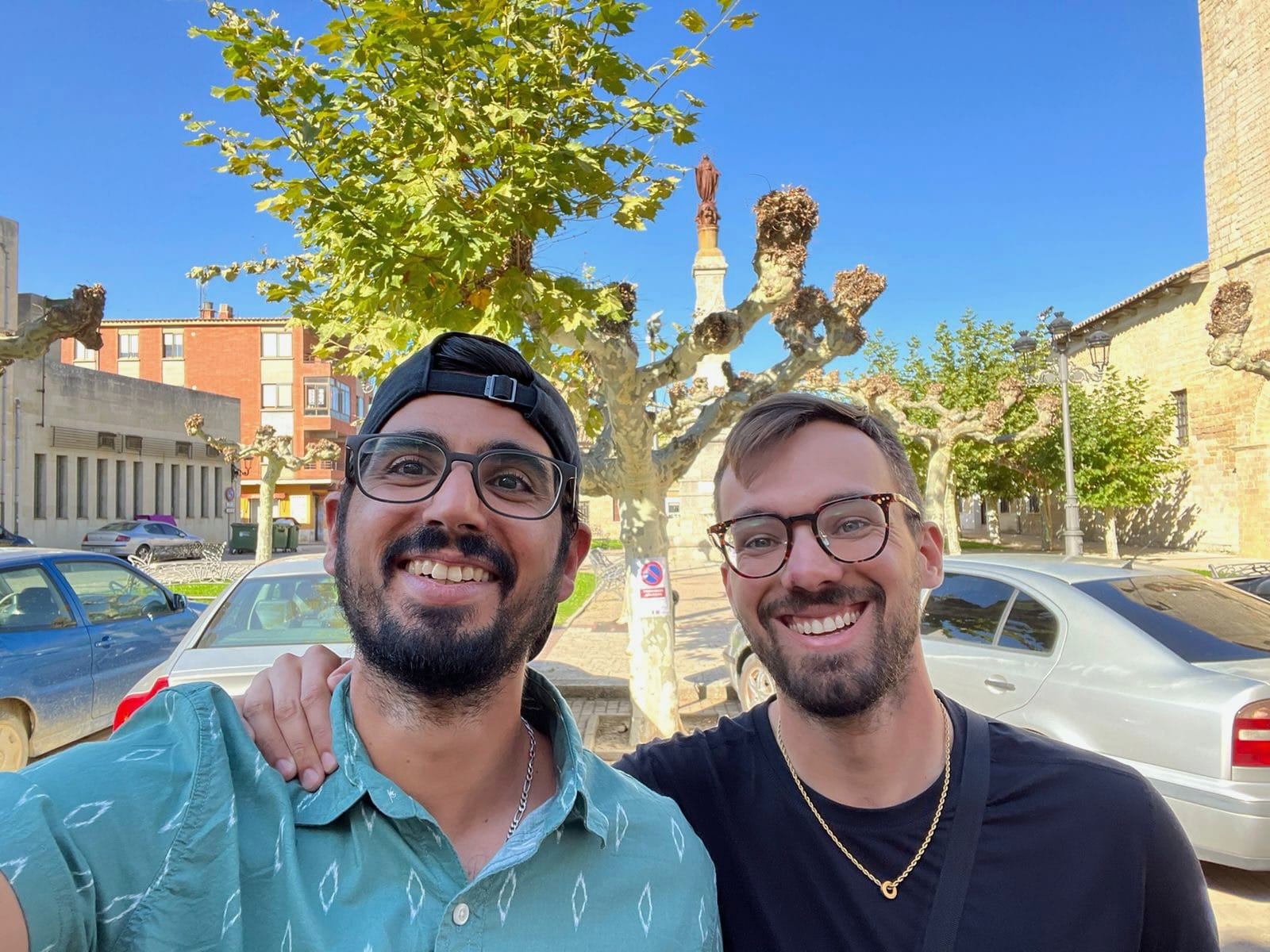
Going out on my own again
Eventually our group began to split up. Half had deadlines they needed to meet, while the rest wanted or needed to walk a slower pace.
First, we split into two groups of four. Jay, Femke, Kuba, and Arianna walked ahead and would end up walking the rest of the way to Santiago together. Luis, Sarah, Olga, and I held back. We walked as far as Leon where we stuffed ourselves full of tapas for two days straight. One night we stayed out until 3am dancing, drinking, and swapping texts with a spammer who messaged me.
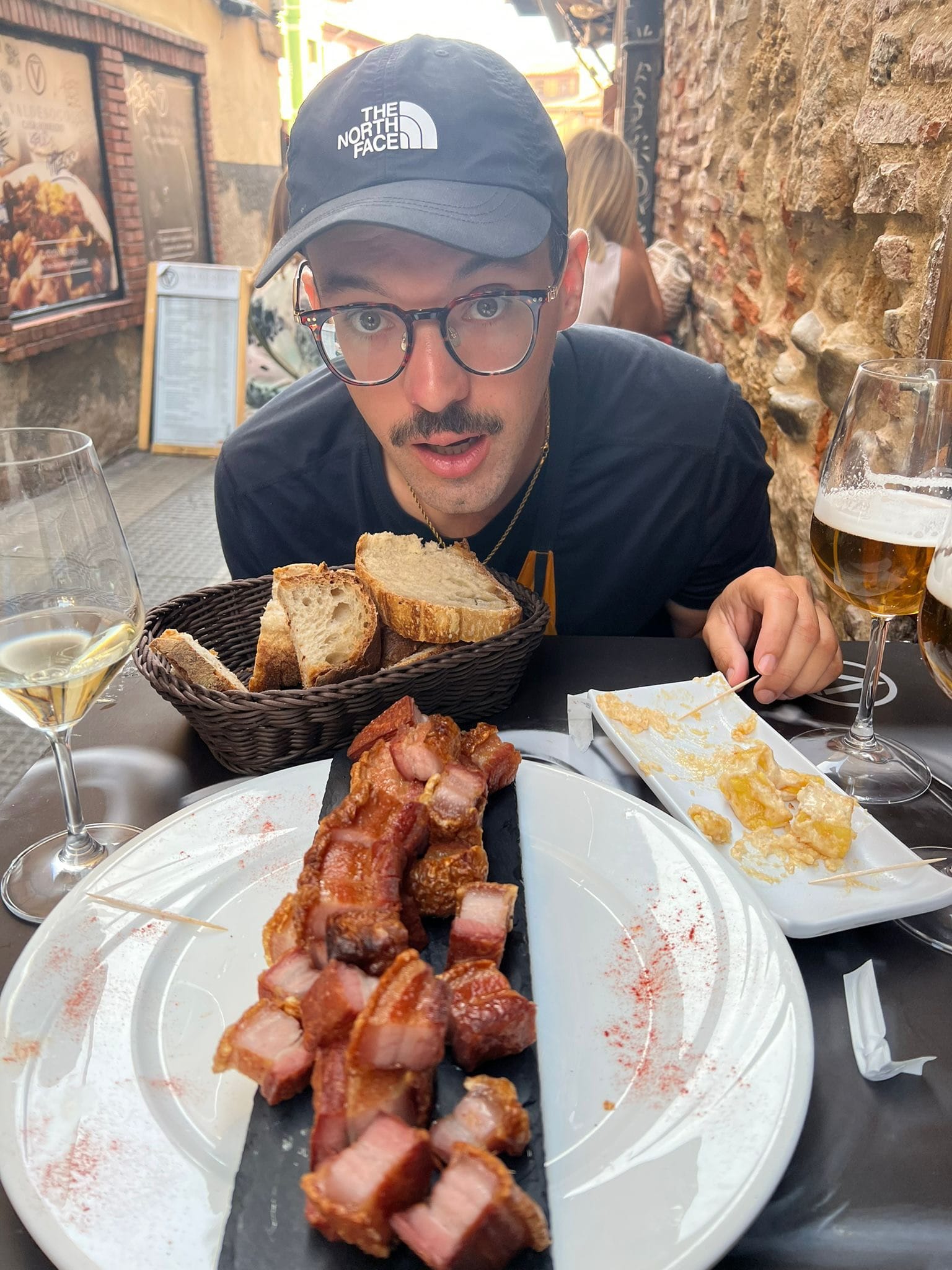
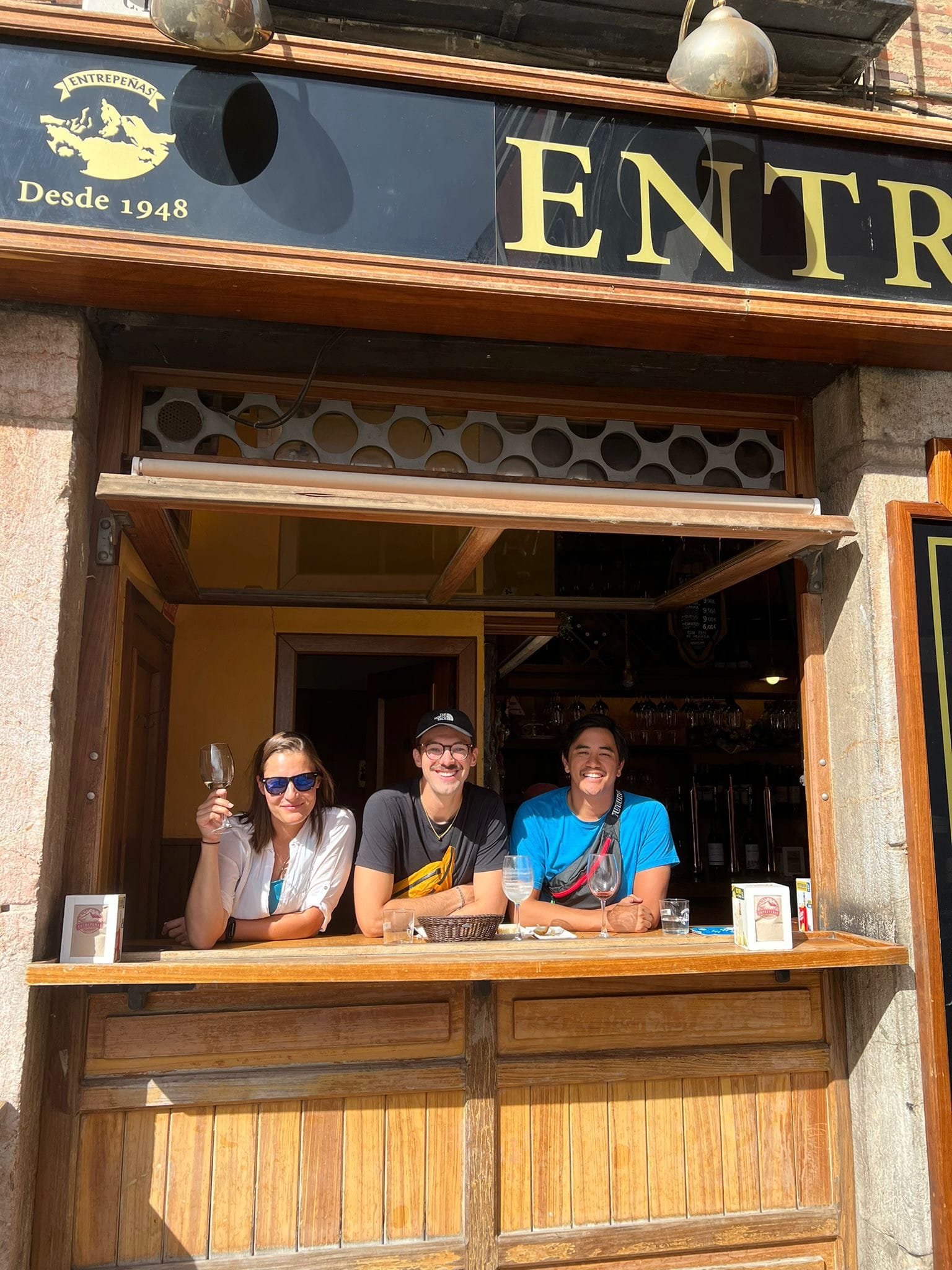
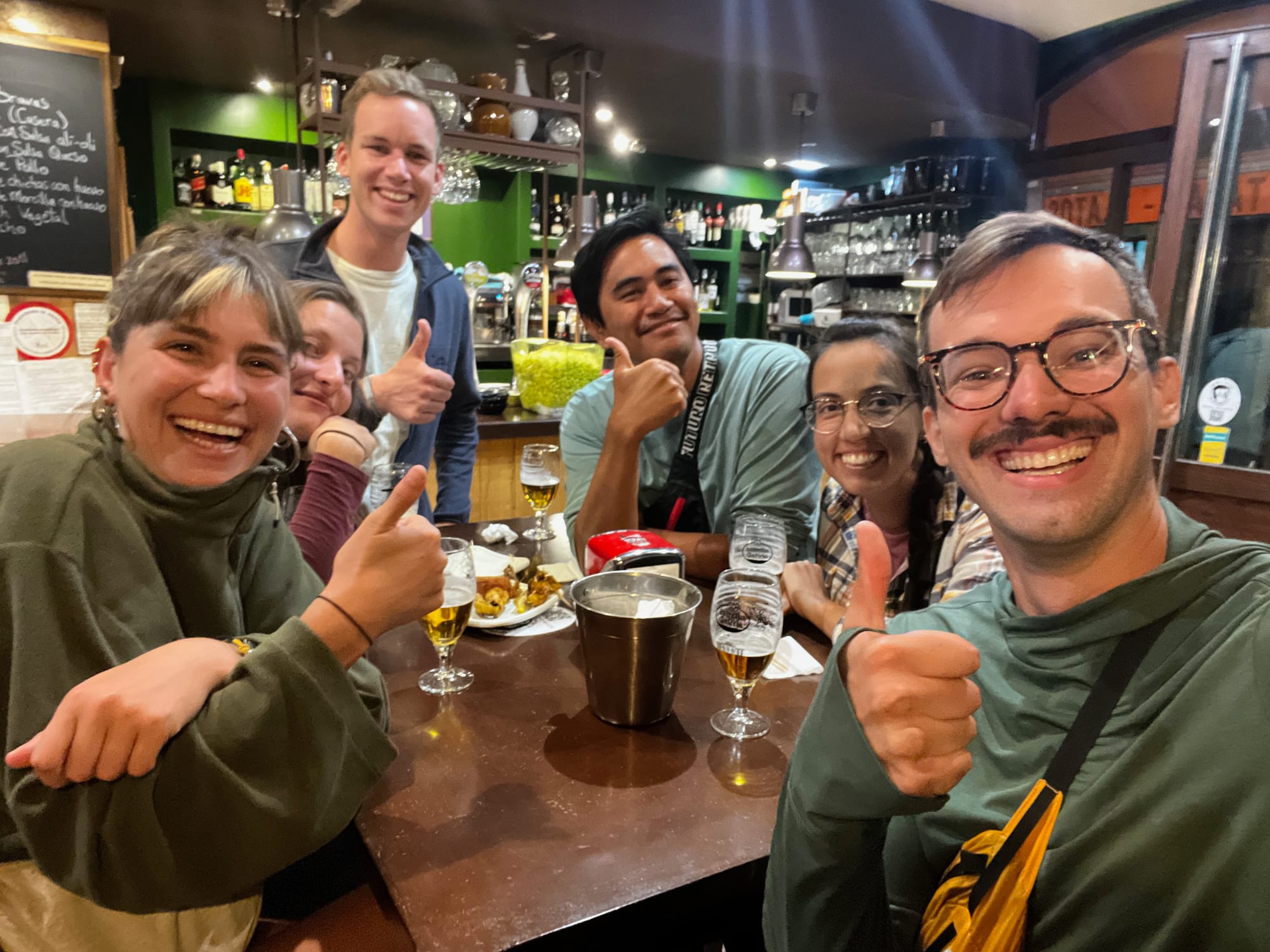
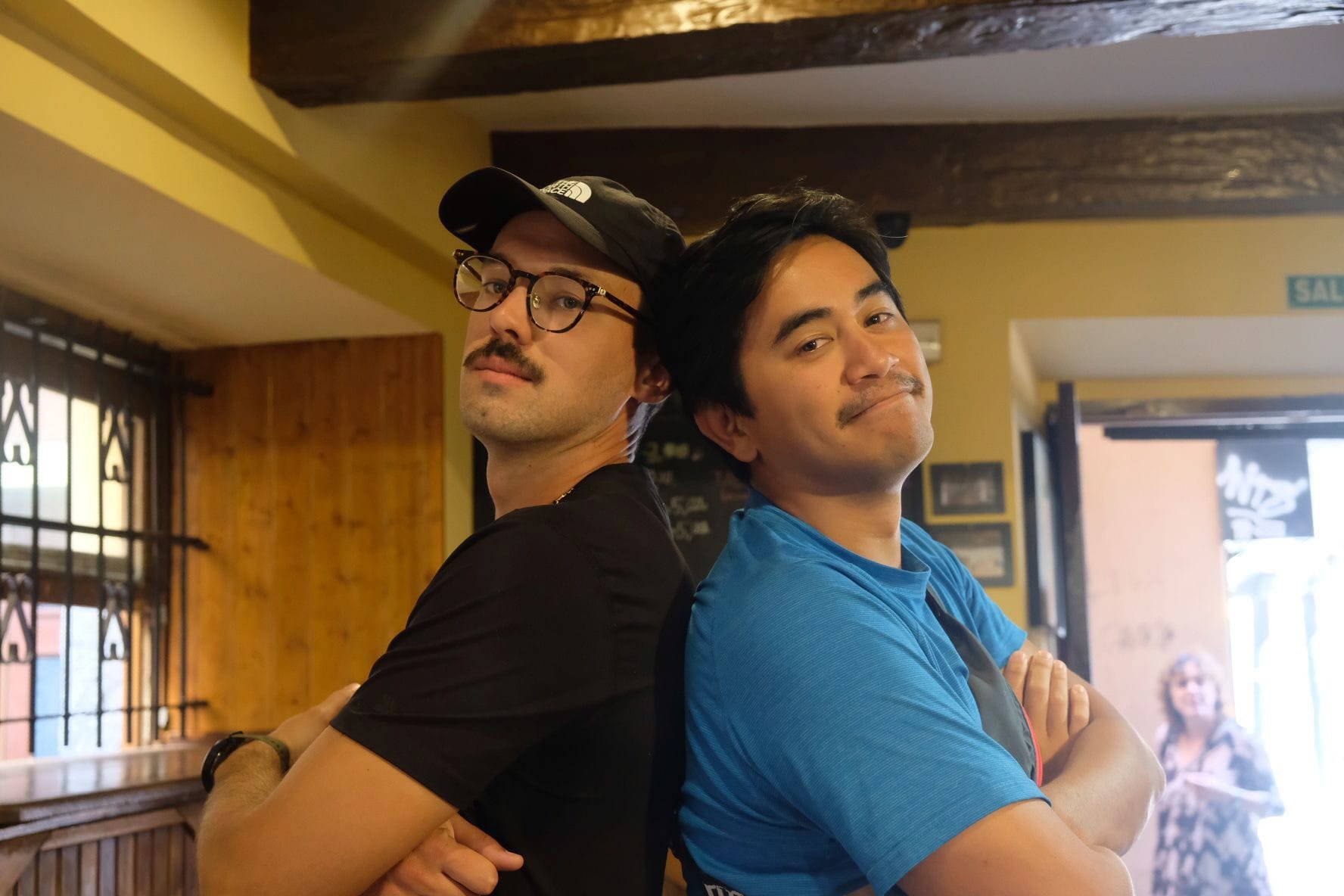
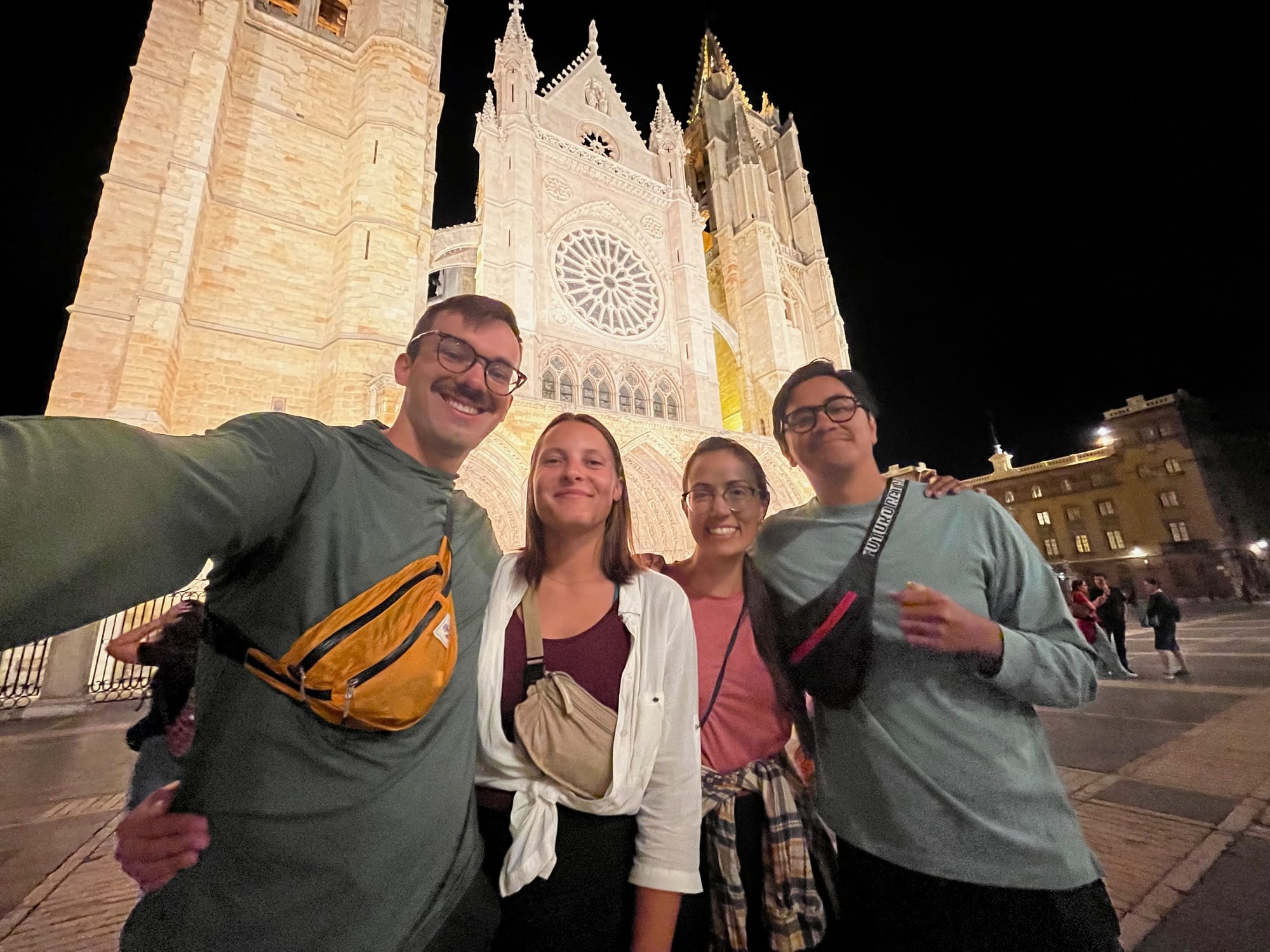
Clockwise: tapas in Leon; Olga, me, and Luis in Leon; Lara, Olga, Maik, Luis, Sarah, and me messing with spammers; Me, Olga, Sarah, and Luis in Leon; me and Luis posing with our new mustaches
But I was feeling the need to walk alone again. Being alone has always been hard for me, so it felt like the right thing to do for my Camino. I let the others go ahead and took a bus to Gijon on the northern coast for a day. I spent a day soaking in another Spanish city and then started walking on my own.
I made some new friends and reconnected with old ones, walking for several days with Sunny and Akari. I learned that they both loved rock climbing as much as I do, Sunny even planned to work in a gym when she got home. And Akari dreamed of one day creating a community for kids in Japan who dropped out of school.
As we got closer to Galicia the weather also started to turn. The region in the northwest of Spain is notorious for rainy, windy weather in the fall. This is where I met my giant Italian friend and shivered my way over the mountains.
I did catch up to Olga for a day or two, who was nursing a sore hip. We had some great conversations about work and life. But once she healed up, she walked ahead and I continued my slow pace to Sarria where I would meet my sister.
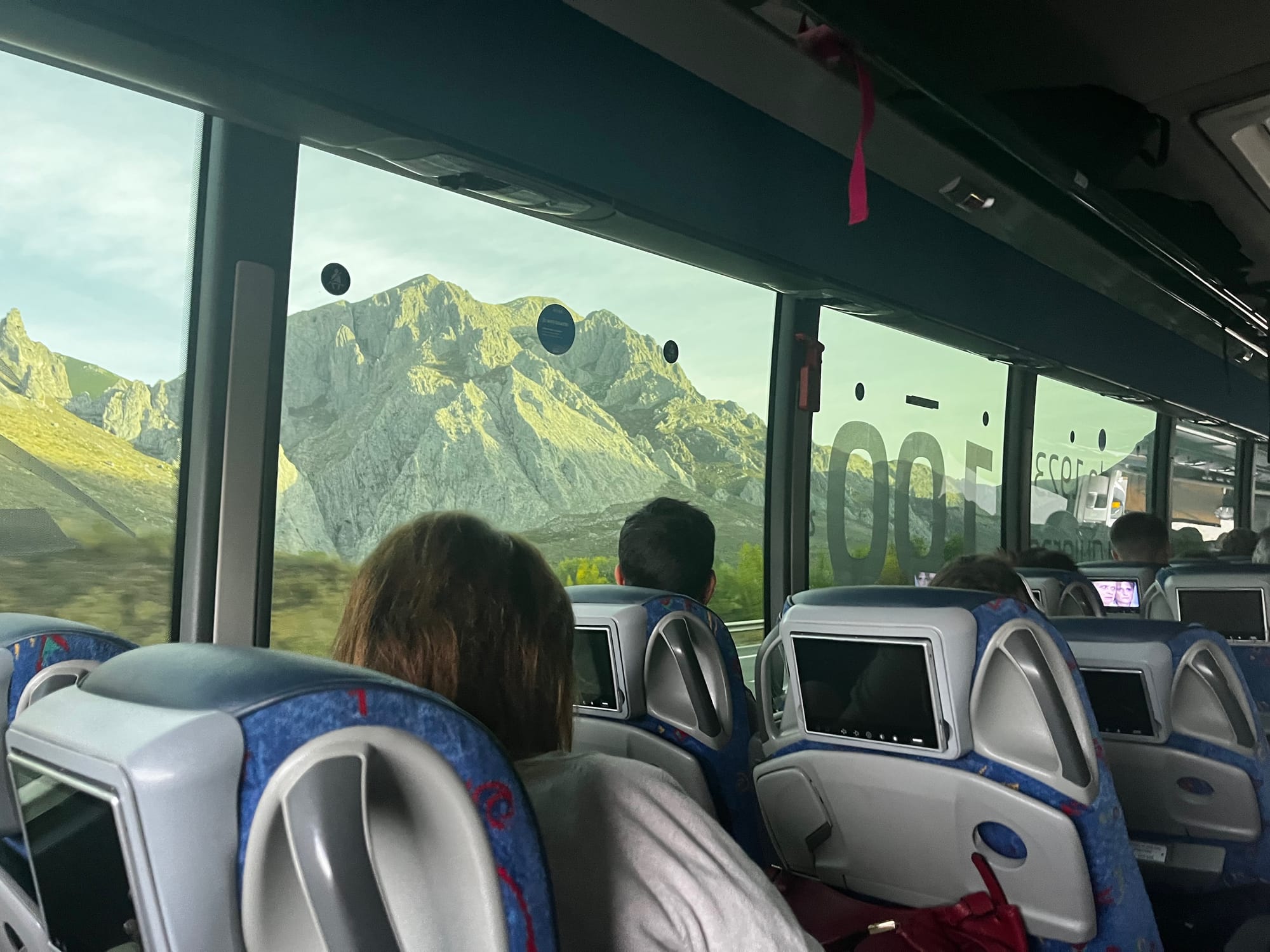
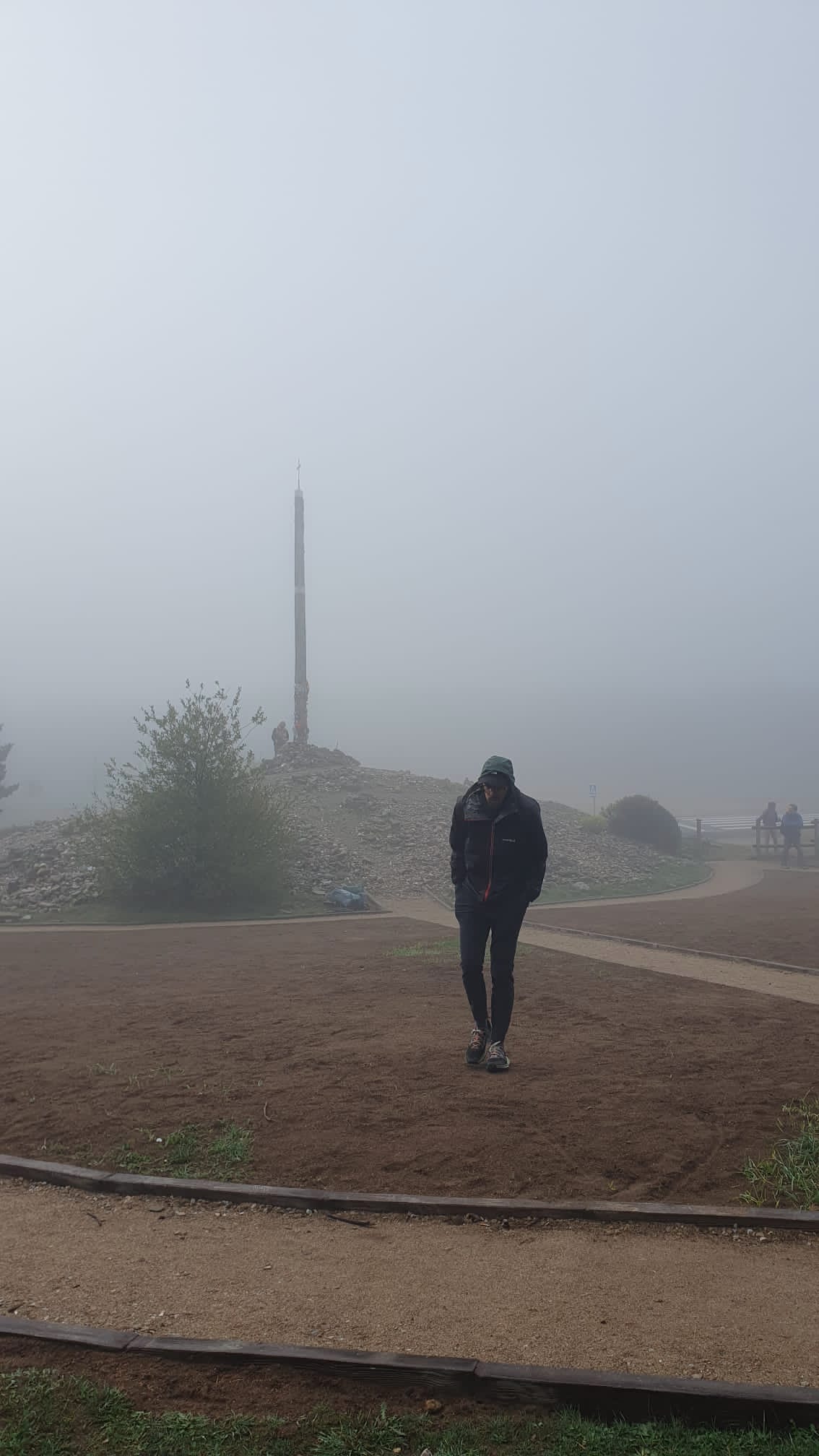
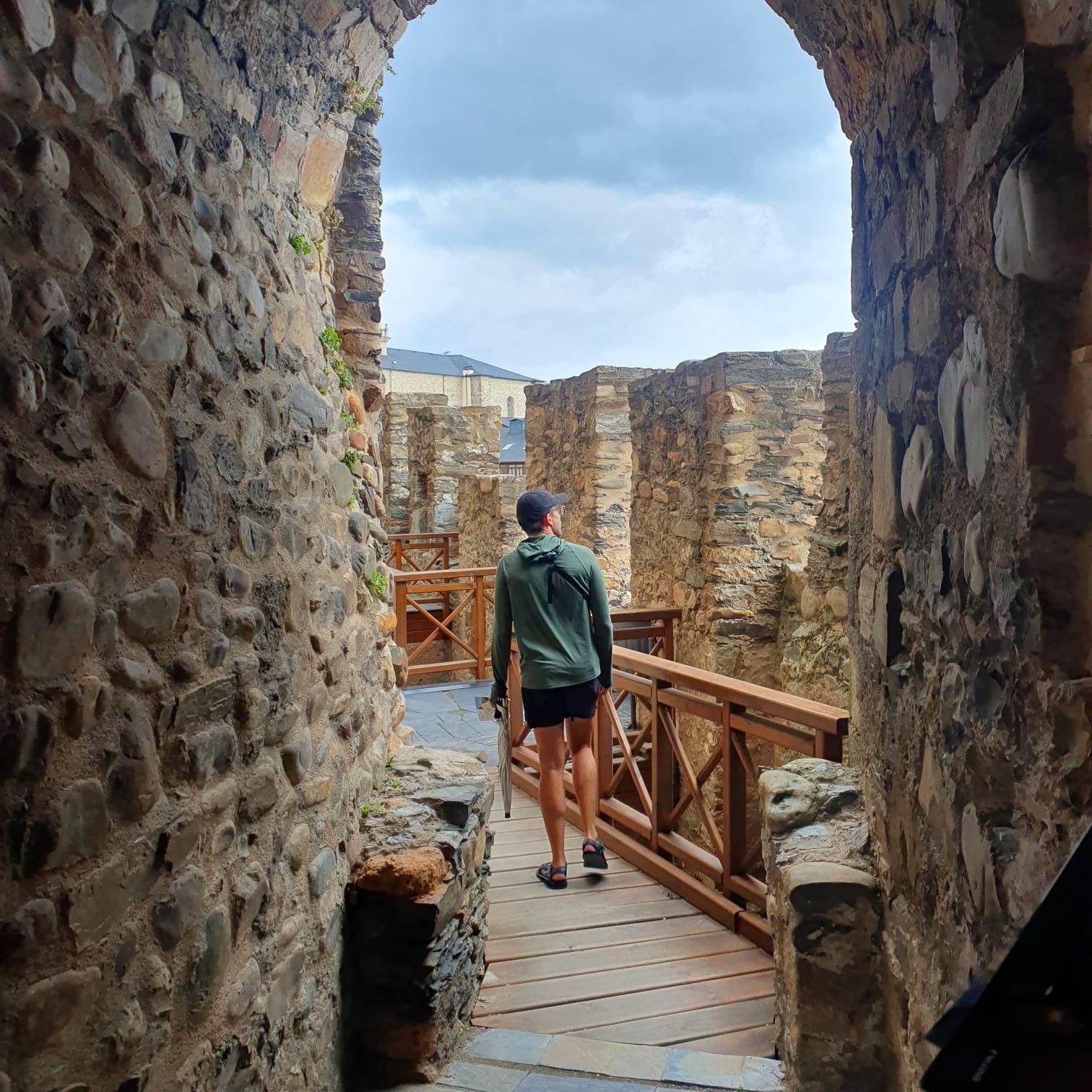
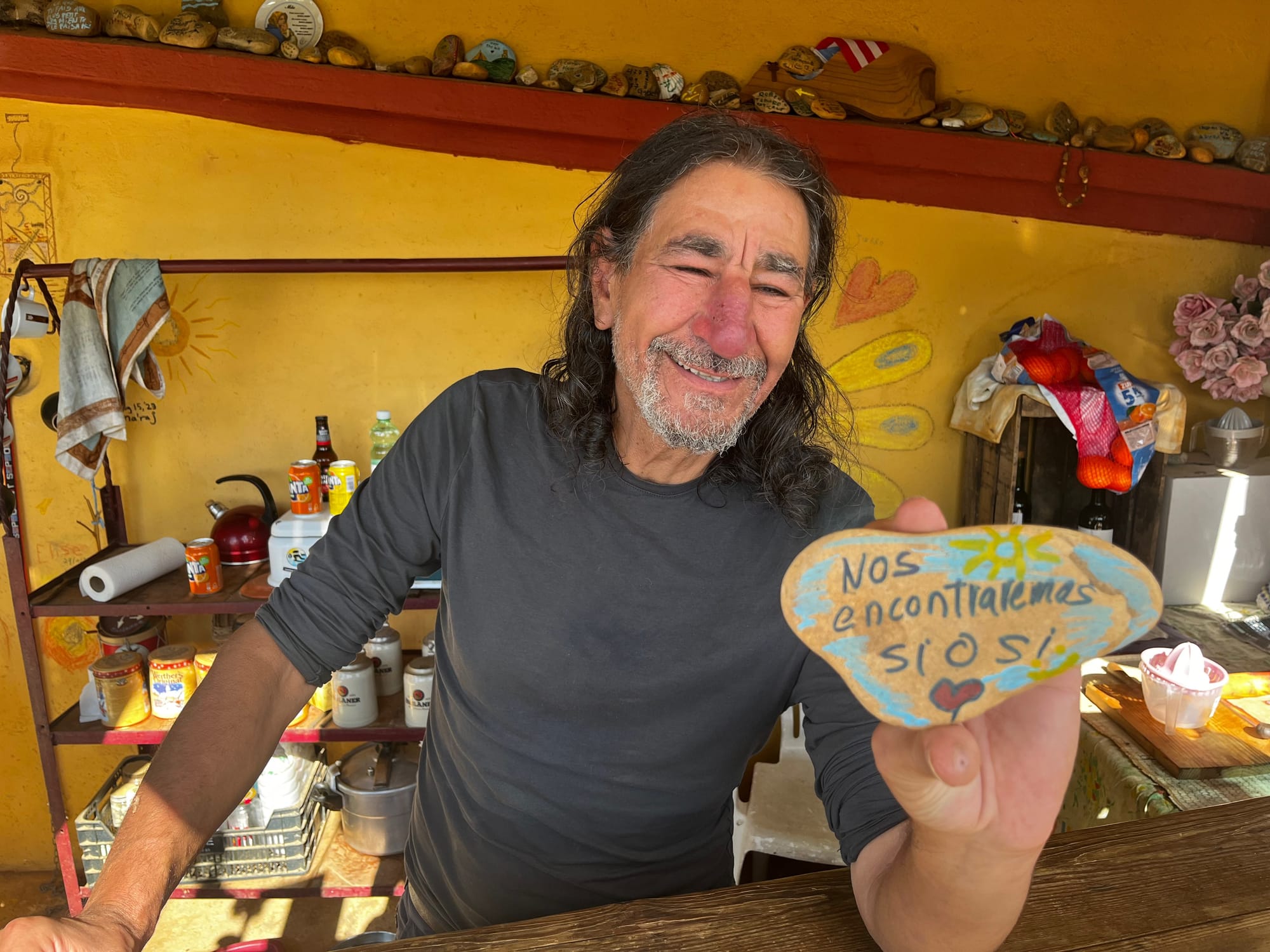
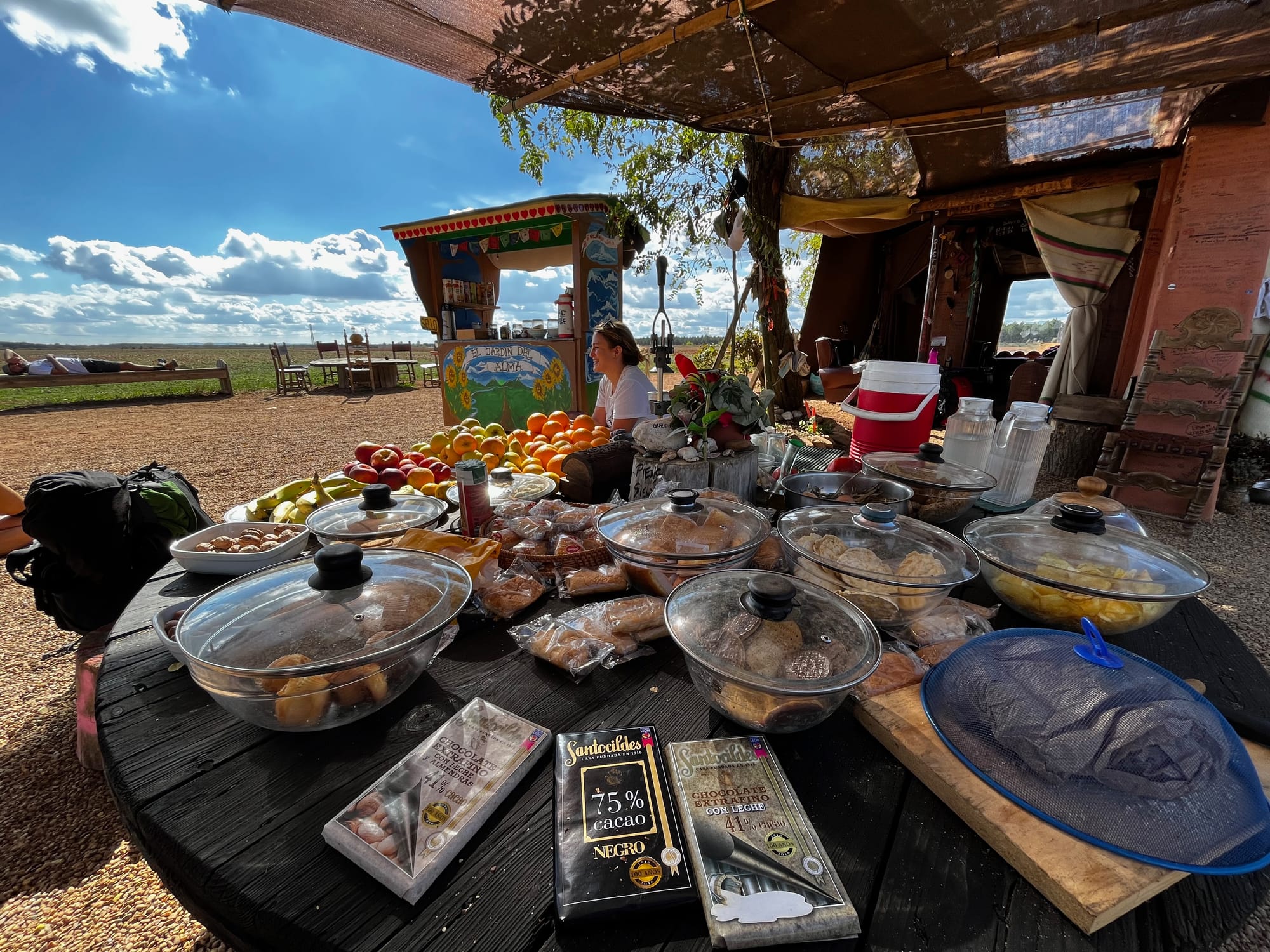
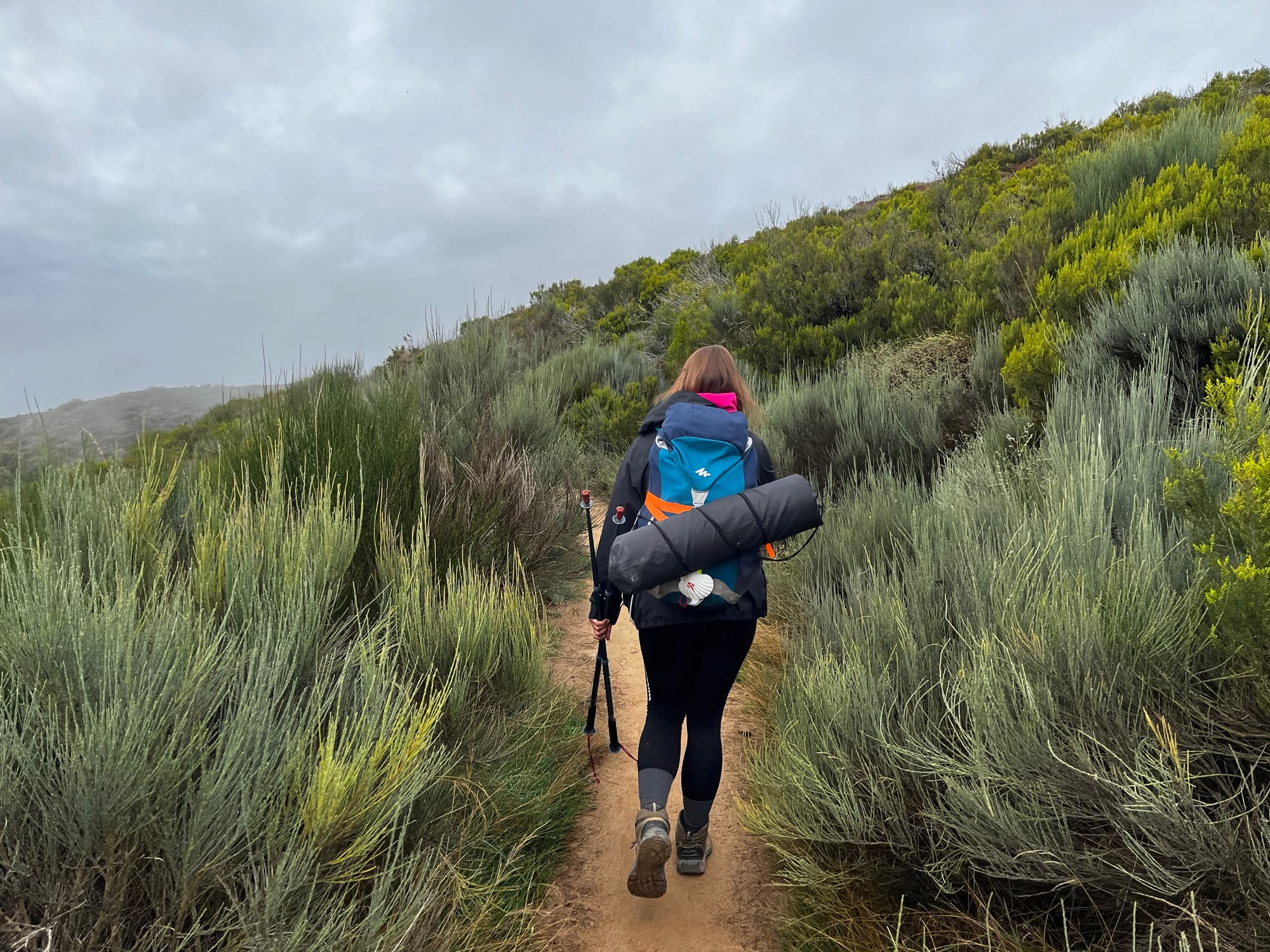
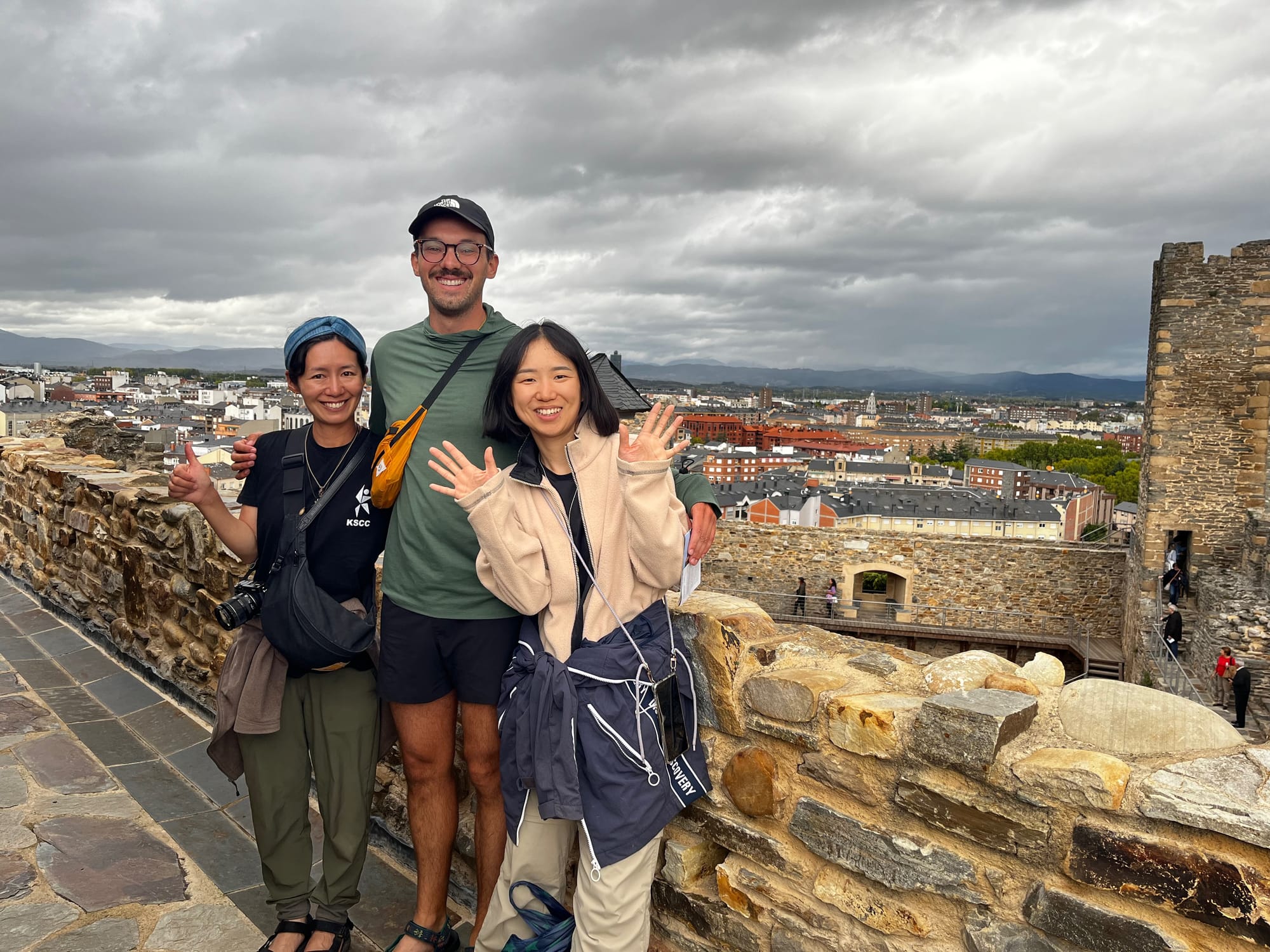
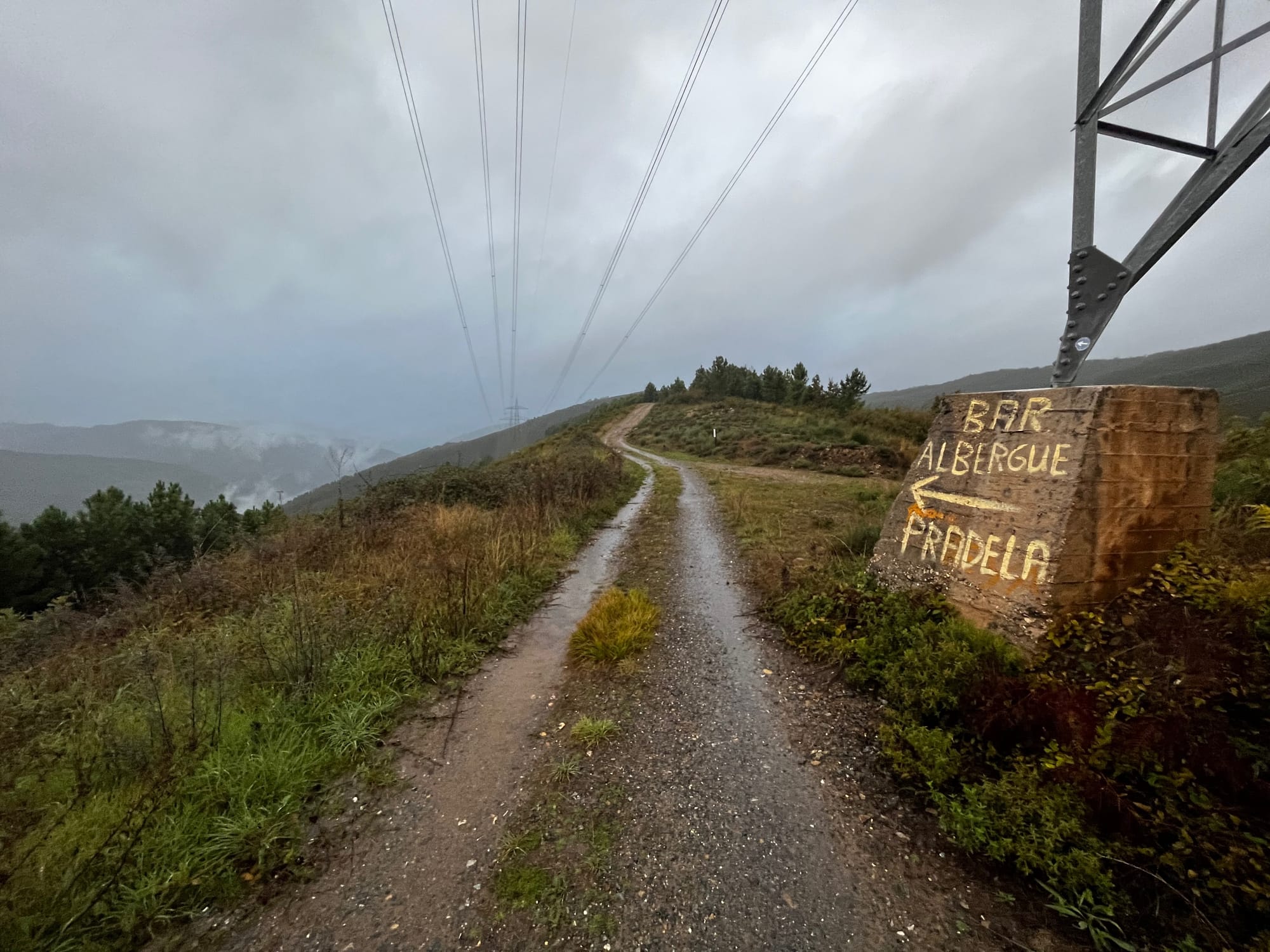
Left to right, starting with the top row: on the bus to Gijon, visiting the famous Cruz de Ferro, exploring a castle in Ponferrada, a friendly shopkeeper we met on the side of the trail, a donation-funded oasis on the trail, catching up with Olga again, Sunny and Akari in Ponferrada, the weather changing as we approach Galicia
Dealing with bed bugs on the Camino Frances
Two days before I was supposed to meet my sister, I woke up with my worst Camino fears realized.
I had bug bites. Not just one or two, I was covered in bites.
There was no doubt about it, I had bed bugs.
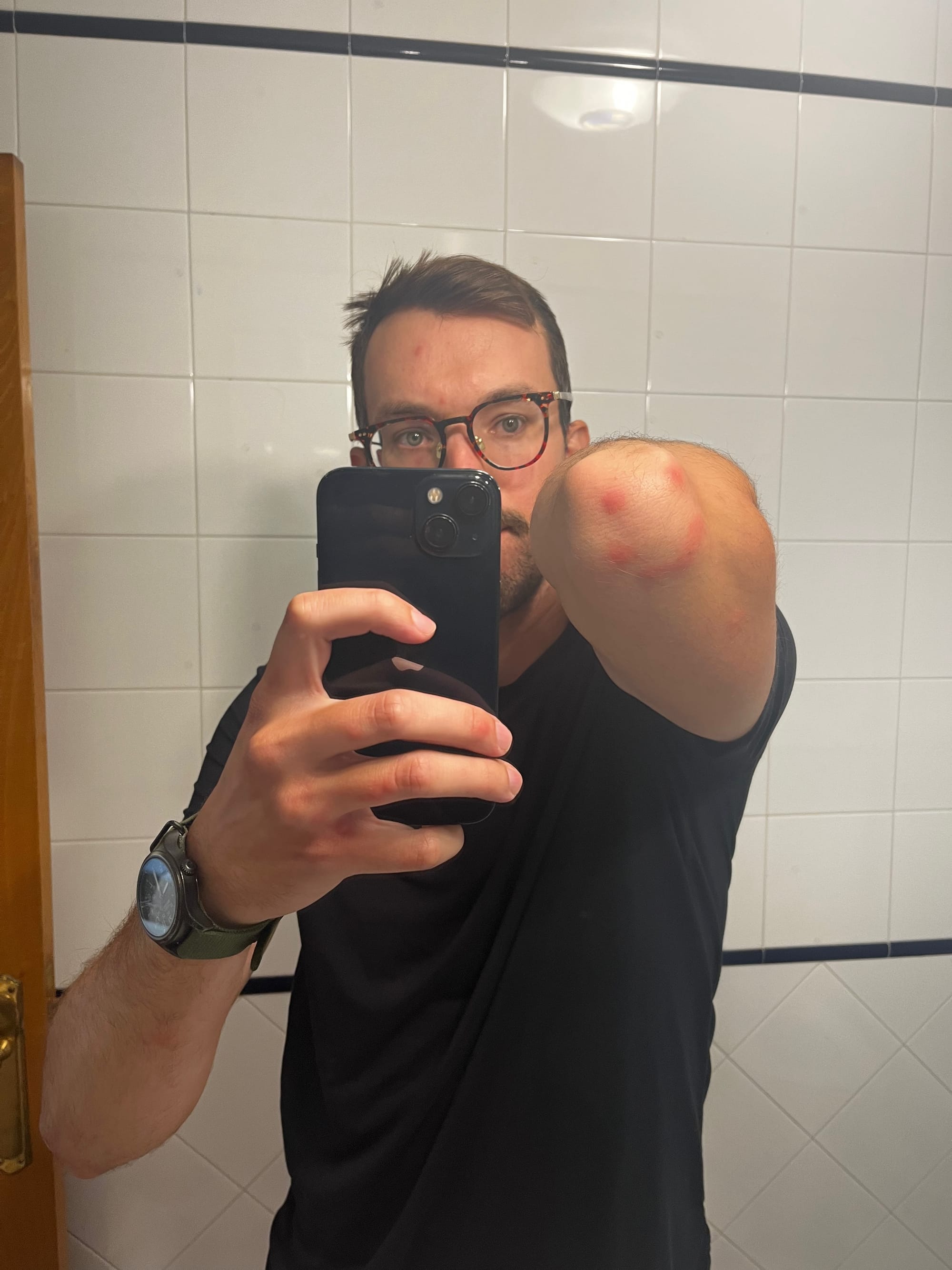
When you get bed bugs on the trail, immediately wash and dry all your things on the highest heat possible. Heat is the most reliable way to kill both adults and eggs.
The ideal temperature is 60 degrees Celsius; at that temperature, you'll kill everything within 30 minutes. At lower temperatures, it can take 90 minutes or more, making it hard to guarantee everything is killed. People advise treating gear with permethrin, but experts are split on its effectiveness. It’s unlikely to hurt, but bed bugs are developing resistance to pesticides in many places.
Bed bug bites can take up to two weeks to appear, and old bites can resurface. In rare cases, people can even develop an allergy to a compound in insect skin after being bitten. Combine that with the fact that bed bugs are very small (visible, but small), good at hiding, and only come out to feed at night and it can be very difficult to tell when you've gotten rid of them.
Laundromats and albergue dryers rarely have temperature readings, so thoroughly wash and dry everything (including your bag) on the highest heat setting until you stop finding new bites.
When I found the bites, I was at a fork in the road where I could choose to take either one or two days to get to Sarria. After finding the bites, I adjusted my reservation in Sarria to arrive a day earlier and booked it into town.
As soon as I got there, I went straight to a laundromat and dried everything on the highest heat setting. Then I checked into my room, changed clothes, and took those back to the laundromat to treat.
When my sister arrived, I had found 60+ bites and kept finding new ones for days. I couldn’t tell if they were showing up on a delay, were new bites from bugs I hadn’t killed, or were from new bugs in the albergues. My sister never got a single bite, and I only met one other pilgrim with as many bites as me, although I had several friends who got one or two bites somewhere along the way.
This was one of the hardest parts of my Camino, and it really got to me. I hated not knowing if I was done with the bites and was terrified of being a bad pilgrim and passing them along.
I still managed to enjoy the rest of the trip, but the fear lingered. That said, if you’re reading this and considering doing the Camino, don’t let it dissuade you. As painful and annoying as it was, I'd do it all again. Bed bugs are annoying, but not dangerous or disease-carrying. Few people dealt with as bad a case of them as I did, and most people never dealt with them at all.
Walking with my sister
Before the trip, my sister Abby and I planned to meet in Sarria. Sarria is a common starting point for people with limited time off. To get your Compostela (certificate of completion), you have to walk at least 100km. Sarria is the closest midsize town on the Camino Frances to the 100km cutoff, although it’s closer to 120km from the finish point in Santiago de Compostela.
The day after I got to Sarria, Abby arrived. We spent the day eating, resting, and making sure she had everything she needed before we took off.
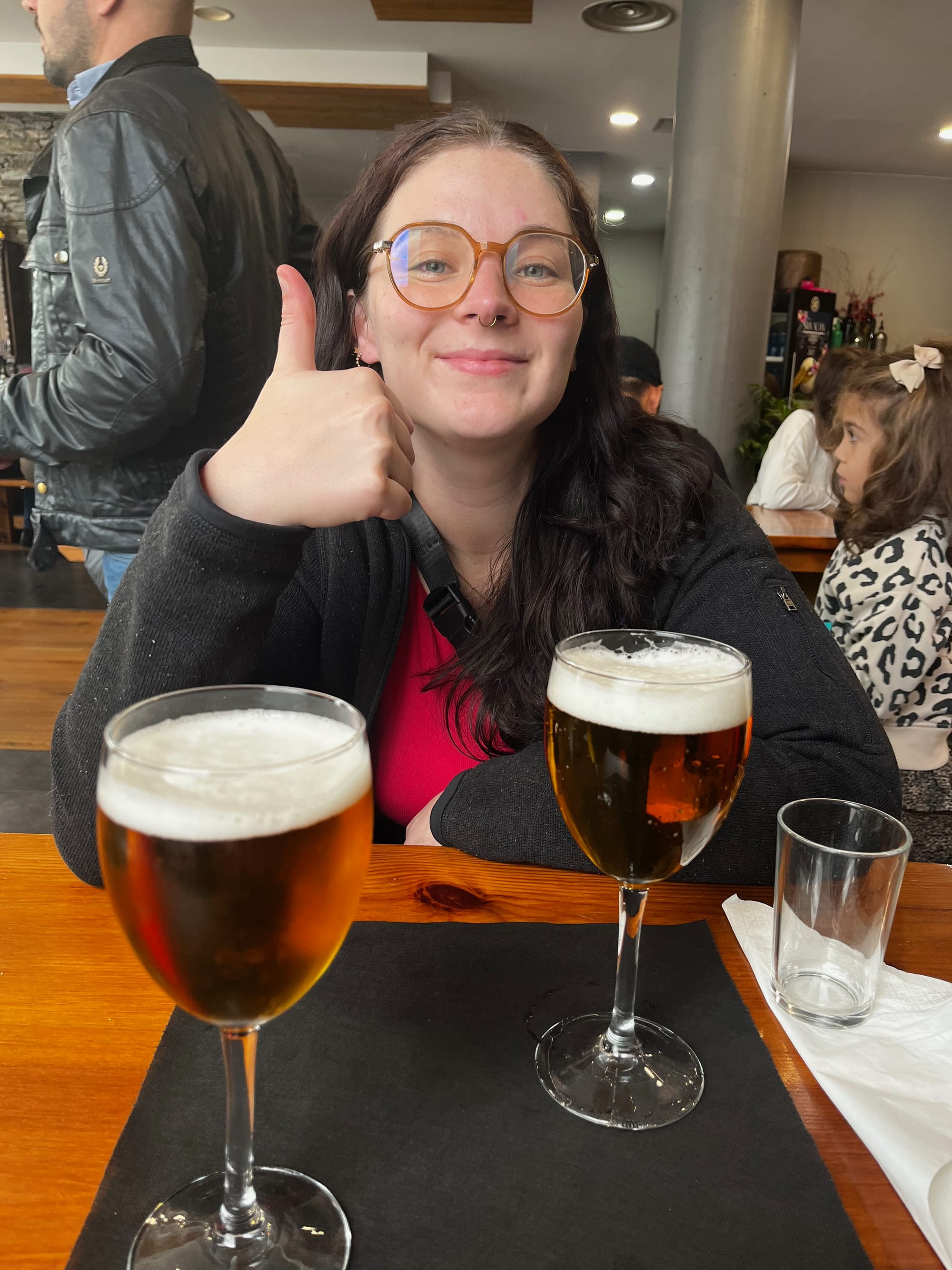
I'd heard horror stories about how commercial and crowded this final section of the Camino was. And it seemed true at first. Every restaurant was packed and we were regularly stuck between large school groups.
But we stopped off-stage that first night, wanting to take it easy and ramp up slowly.
The guidebooks break the walk up into stages, so most pilgrims stay in the same towns every night. But between the bigger towns are small towns that usually have one or two albergues.
As soon as we got off stage, the experience totally changed. It was super quiet, easy to find beds, and there was almost no one else around.
It rained nonstop as we walked. We tried to dry our socks and shoes at night, but we'd be soaked by midday. Abby got serious blisters and the brutal first-week soreness that so many pilgrims experience. But she never complained and kept trekking.
While walking, we played games, talked about the future, reminisced about our hometown, and created silly rhymes. We argued and made up.
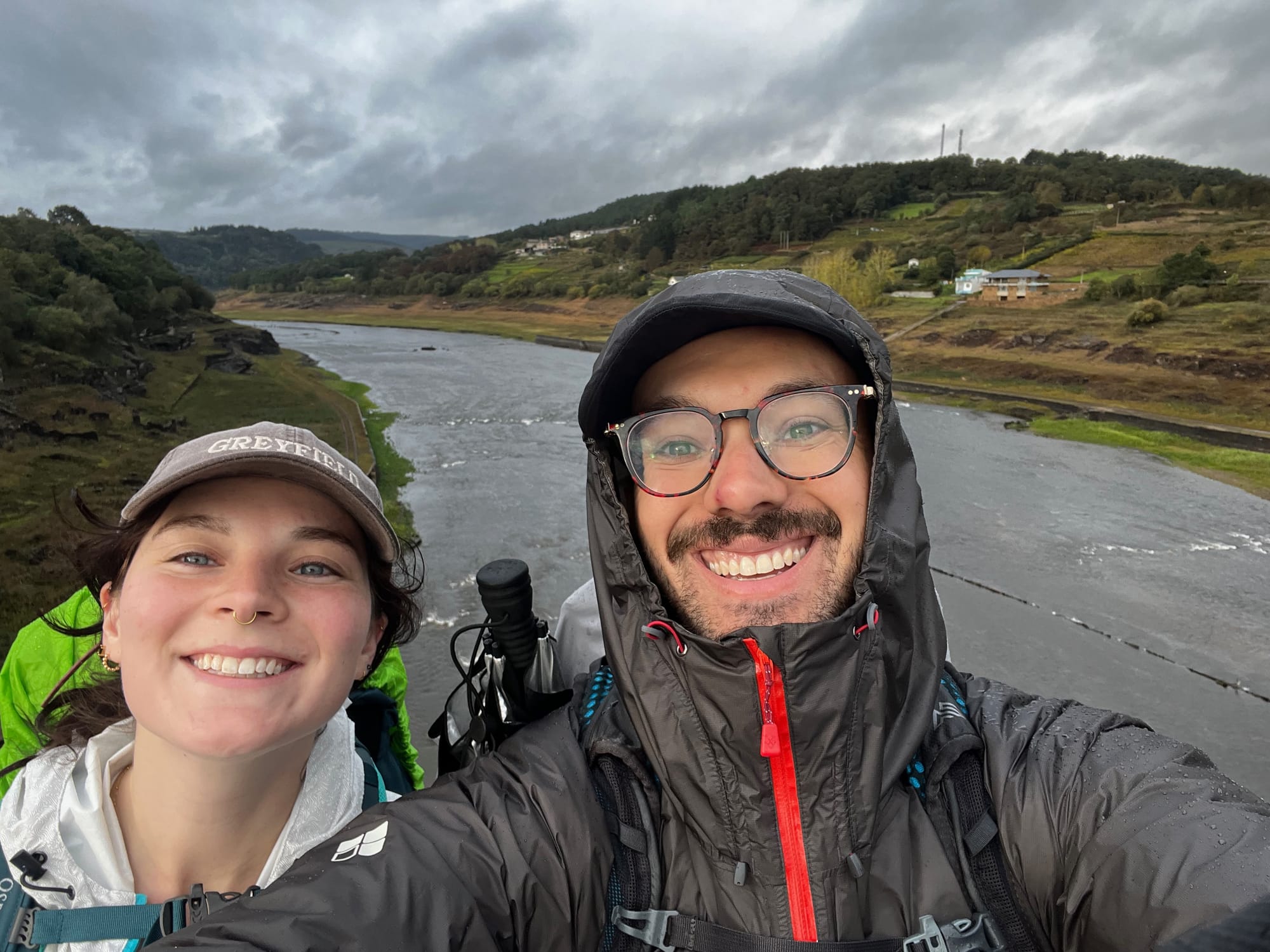
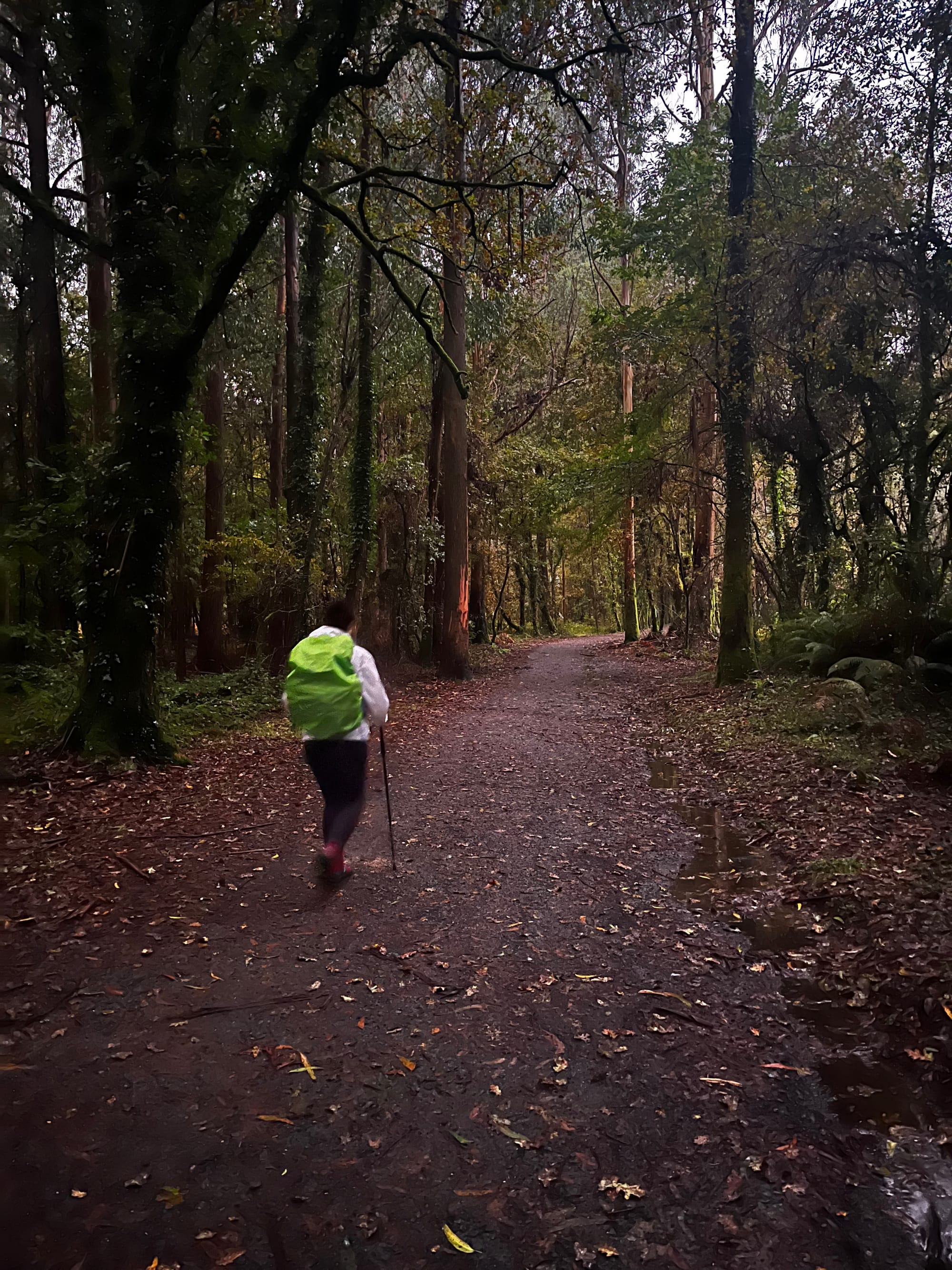
Abby and I bundled up in rain gear and walking through the forests of Galicia
One day we stopped in a public albergue in a tiny town with two albergues and one bar. We were sitting at the bar drinking a beer when two blonde pilgrims walked in. They sat next to us at the bar and ordered a shot of something.
I leaned over and asked what they were drinking, curious. They told us it was hierbas, a local herbal liqueur. They were on kilometer 30-something that day and had 5-10 more to go so were stopping in each bar to do shots to keep their morale up.
They ordered not one, but two more rounds of shots to do with us before leaving. We exchanged numbers and learned that one of them was the star of a children’s TV show in Czechia.
We never met them again, but we did many more shots of hierbas on our way to Santiago, inspired by them.
Getting to Santiago
Throughout my walk, I would occasionally think back to my friend Maria from the first day and wonder how her Camino was going. Because she was intentionally taking a slower pace at the start, we hadn’t seen each other in weeks.
Even with the hundreds of people walking and all of the decision points along the way, I always had this feeling that we would bump into each other again before the end. But we were getting closer and closer to Santiago and still no sign of Maria.
Two days before we get into Santiago, Abby and I stop at a small bar to dry off and get a drink with our friend Karen, a sweet Dutch woman. Just as we’re about to start walking again, I hear a Spanish accent call out, “Andrew!”
Sure enough, there’s Maria. Camino magic at work.
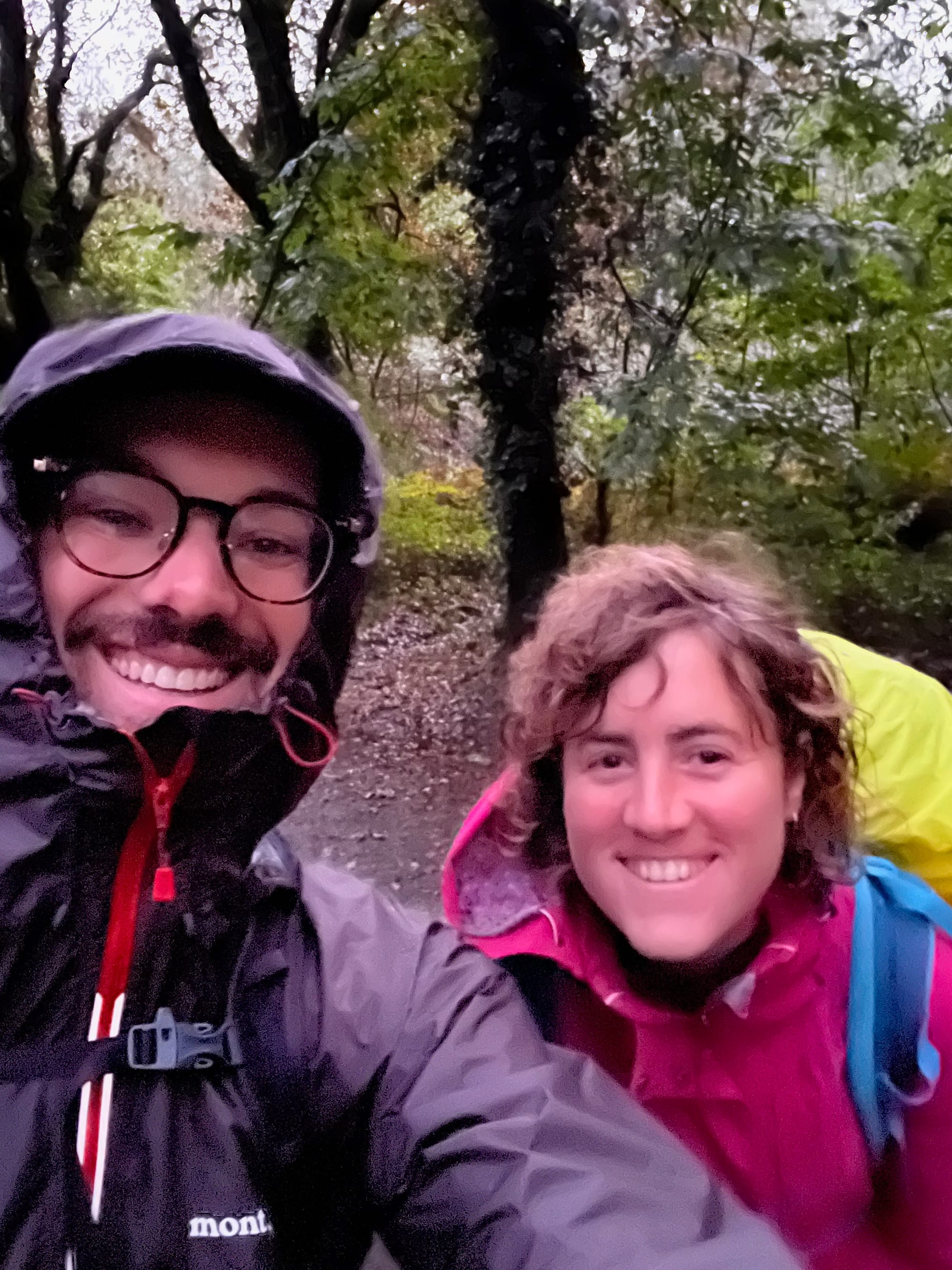
Maria joins our band along with Alex, a software engineer from San Francisco walking the Camino with his mom. The next day we all venture out for Santiago together.
The day is nasty. Cold and windy, with intermittent heavy rain and loud claps of thunder. I swear out loud that if I get struck by lightning and die this close to the end, I’m going to haunt the Camino for eternity.
The rain intensifies as we near Santiago, but we aren’t stopping now. Soaked, we try to follow decreasingly helpful signs. The signage on the Camino is incredible UNTIL Santiago for some perplexing reason.
We’re winding through the city, wondering how much farther we have to go until we finally round a corner and run into Sarah, Luis, and Maik! We’ve made it!
We rush through an archway, back out into the rain, and there it is - the cathedral of St. James. I scream at the top of my lungs, we all laugh and cry, and Maik takes a picture. The wind is whipping and it’s raining harder than before. But who cares, we’ve made it, we’re here!
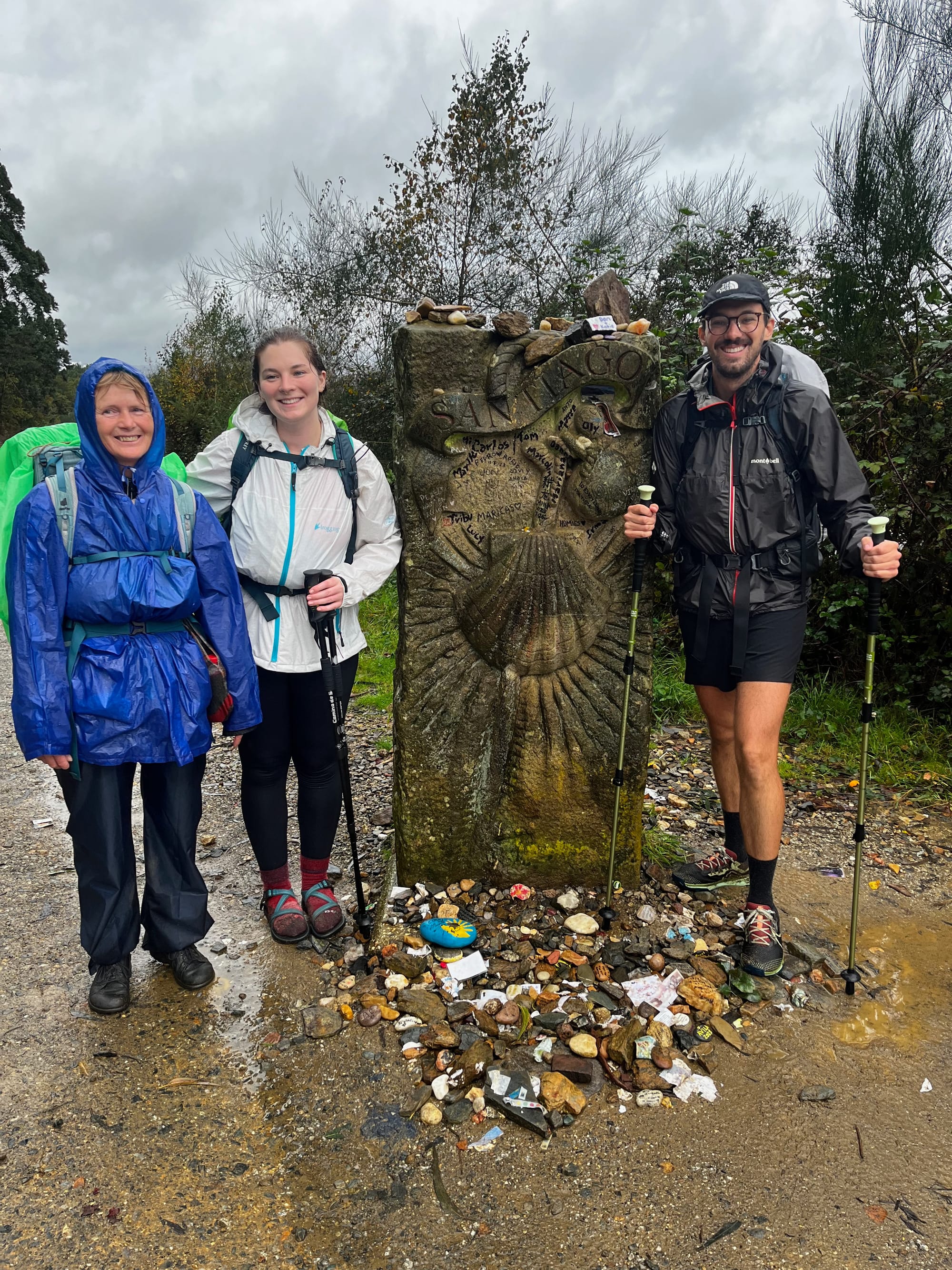
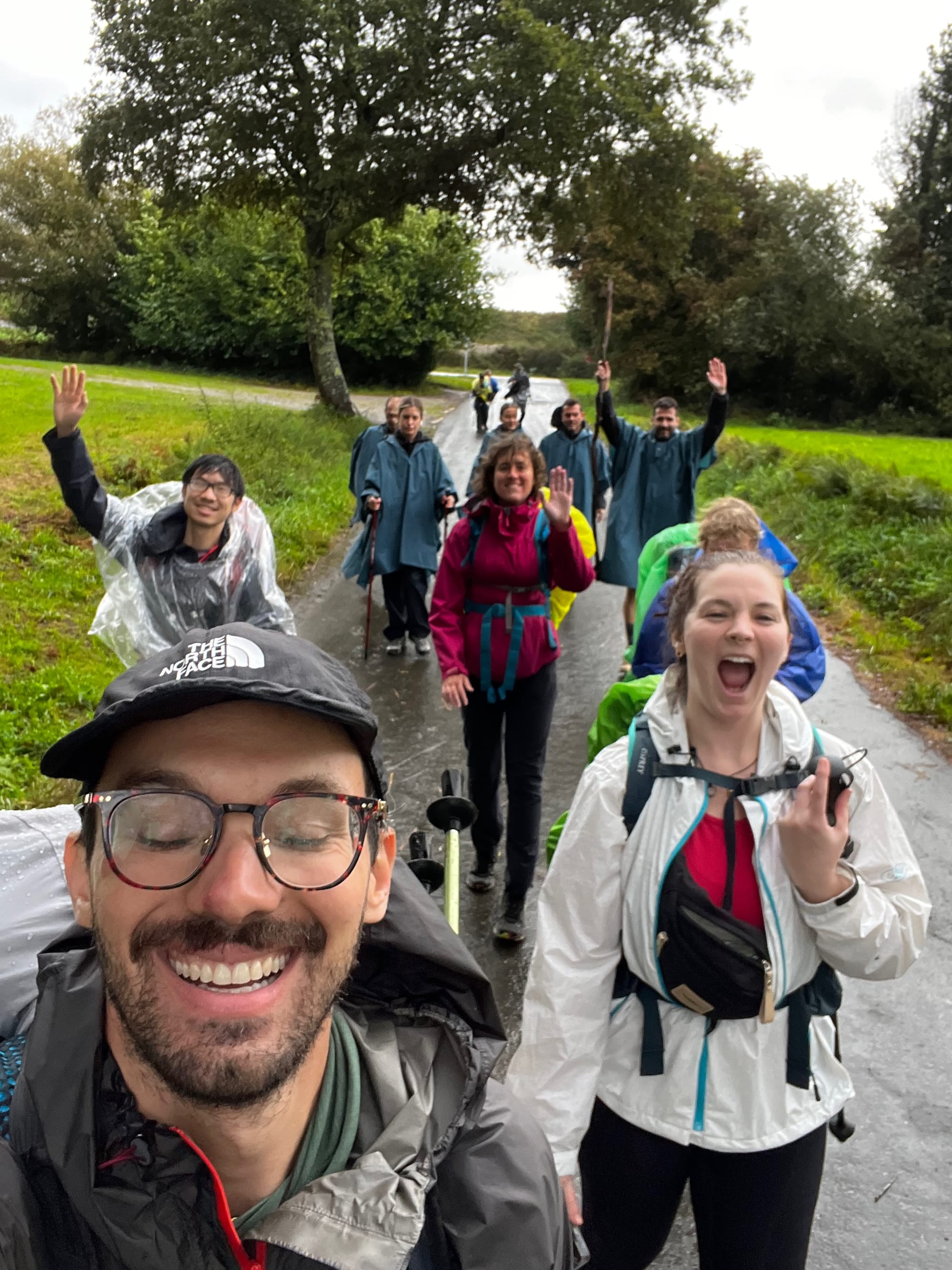
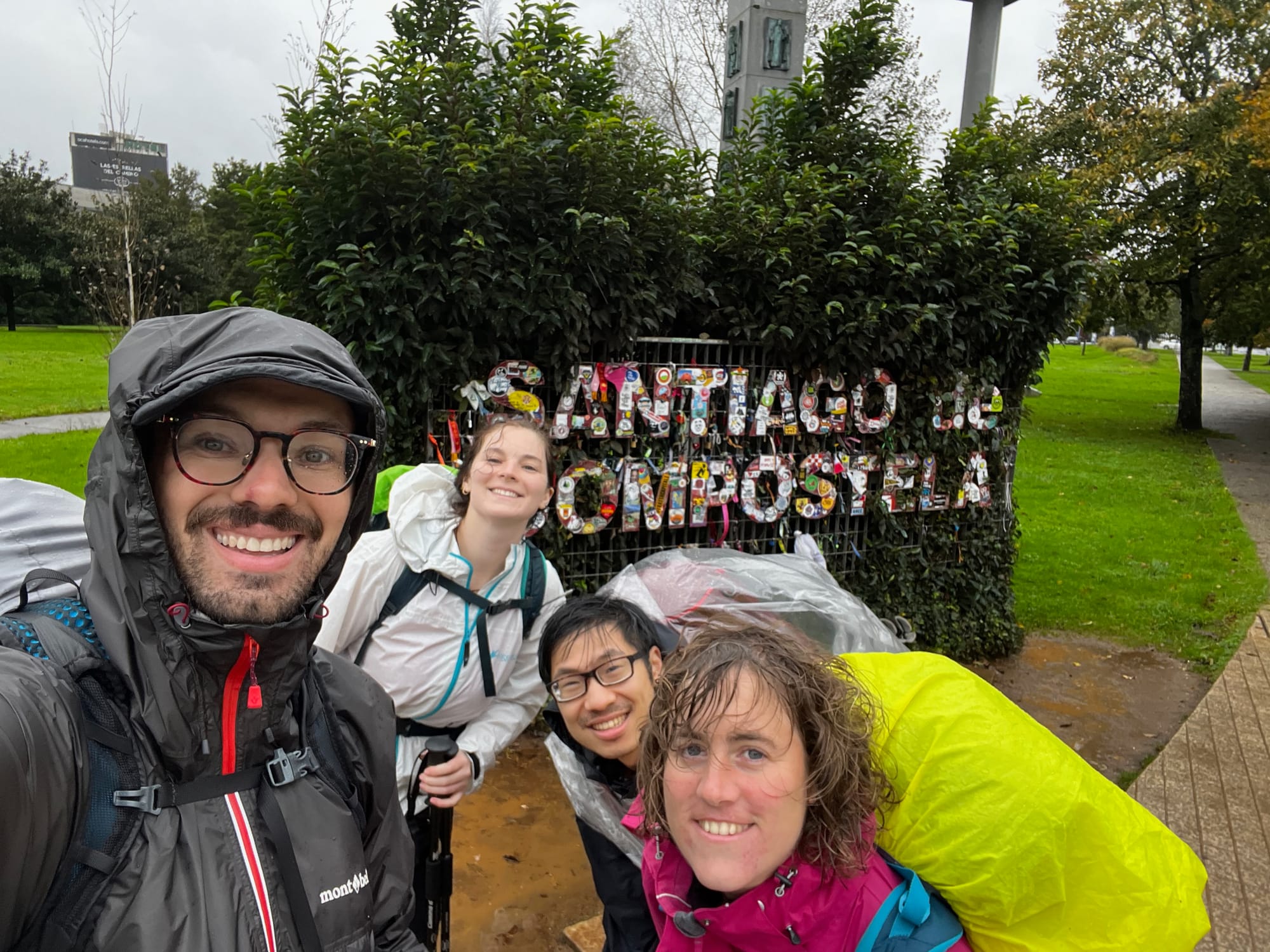
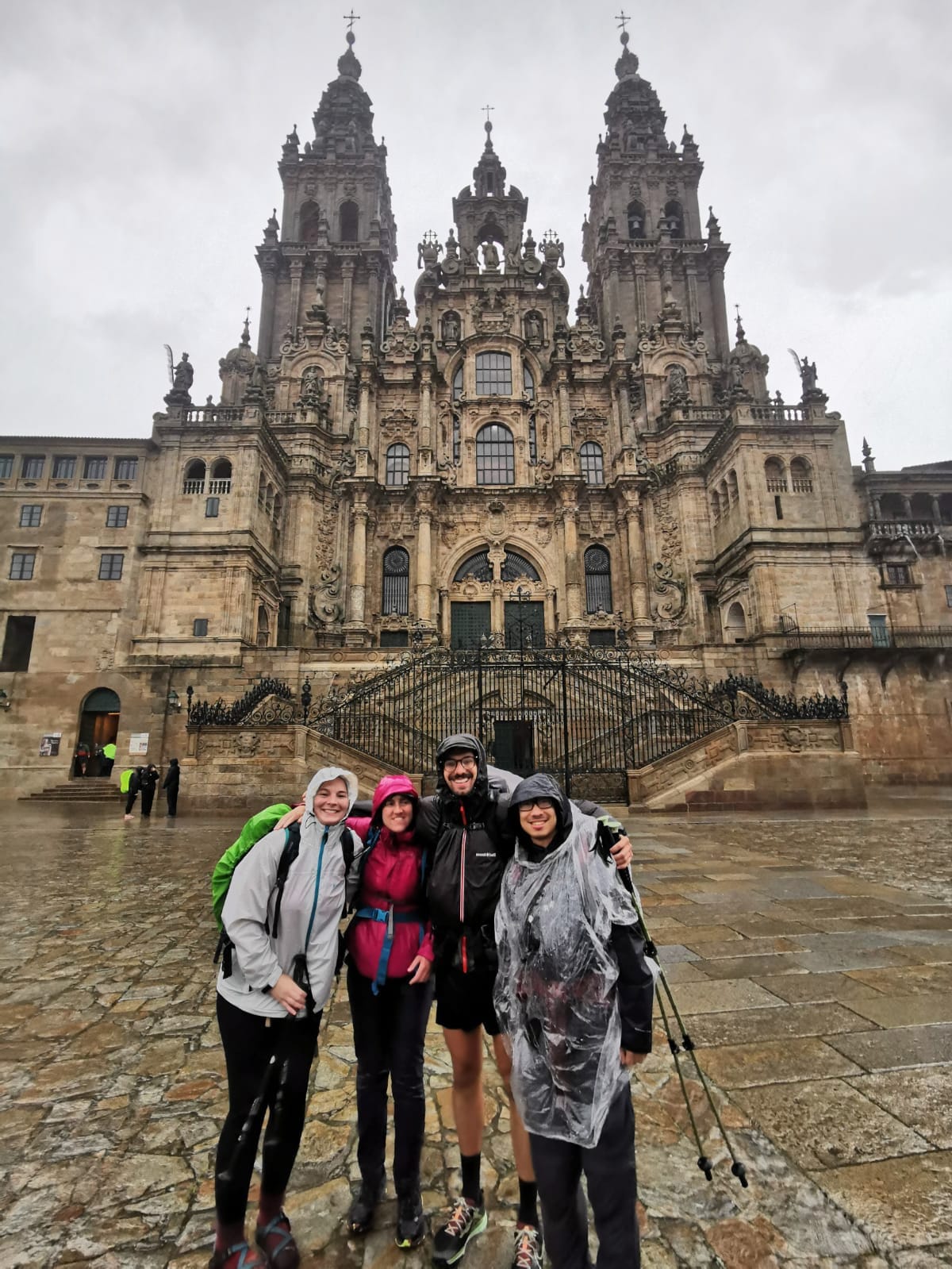
Trudging our way through the rain on the last day into Santiago de Compostela
After soaking it in, we stumble into a bar with our friends. It’s raining so hard that the bar across the street is using a bucket to get water out of their entryway. We order shots and food, and catch up with everybody. The tables and chairs are soaked, but who cares, we’ve made it.
We spend the next two days in Santiago enjoying the city and our friends. That afternoon, Olga, Kuba, Arianna, and an American named Kyle get off a bus from the coast, and shortly after my girlfriend Maddy lands on a plane from the US. We all eat dinner together, making introductions for those who don’t know each other, and then go find the only karaoke bar in Santiago. We stay up until 3am singing our asses off and reveling in being back together.
Exploring Galicia
After Santiago, the plan was for Maddy, Abby, and I to continue 90km to Finisterre. Finisterre, roughly translated as the end of the world, is the westernmost tip of Galicia. Pilgrims would traditionally walk on past Santiago until they reached the coast, and burn their clothes on the beach.
We made it one day into the trip. The roads were muddy, the forecast called for nothing but wind and rain, my sister’s feet were swollen to twice their normal size, and I came down with a stomach bug. We decided we had done enough.
It was a tough decision for me. I had this idea that I needed to walk all the way to the coast. I didn’t want to say, “I walked across Spain,*” with the asterisk that I had walked most of the way across the country and then quit.
I initially told myself I was quitting for Abby. But the truth was I was done. I had walked my Camino.
The bed bugs and the stomach ache had worn me down. I was at my end.
While it took a while to get through my thick head, the people are what matter, not some arbitrary accomplishment. I realized I wanted to spend the week with my sister and Maddy much more than I wanted to check off some arbitrary box.
We called a taxi back to Santiago, rented an apartment on the coast for the rest of the week and a bright red Fiat. Then, we spent three days exploring Finisterre (where the wind blew my glasses off my face and nearly took them over the cliff), A Coruña, and more of Santiago.
On the last day, we capped it off with Camino tattoos. I got the traditional scallop shell, my sister got a salamander to remind her of all the squished salamanders we saw on the road, and Maddy got a small bouquet of flowers.
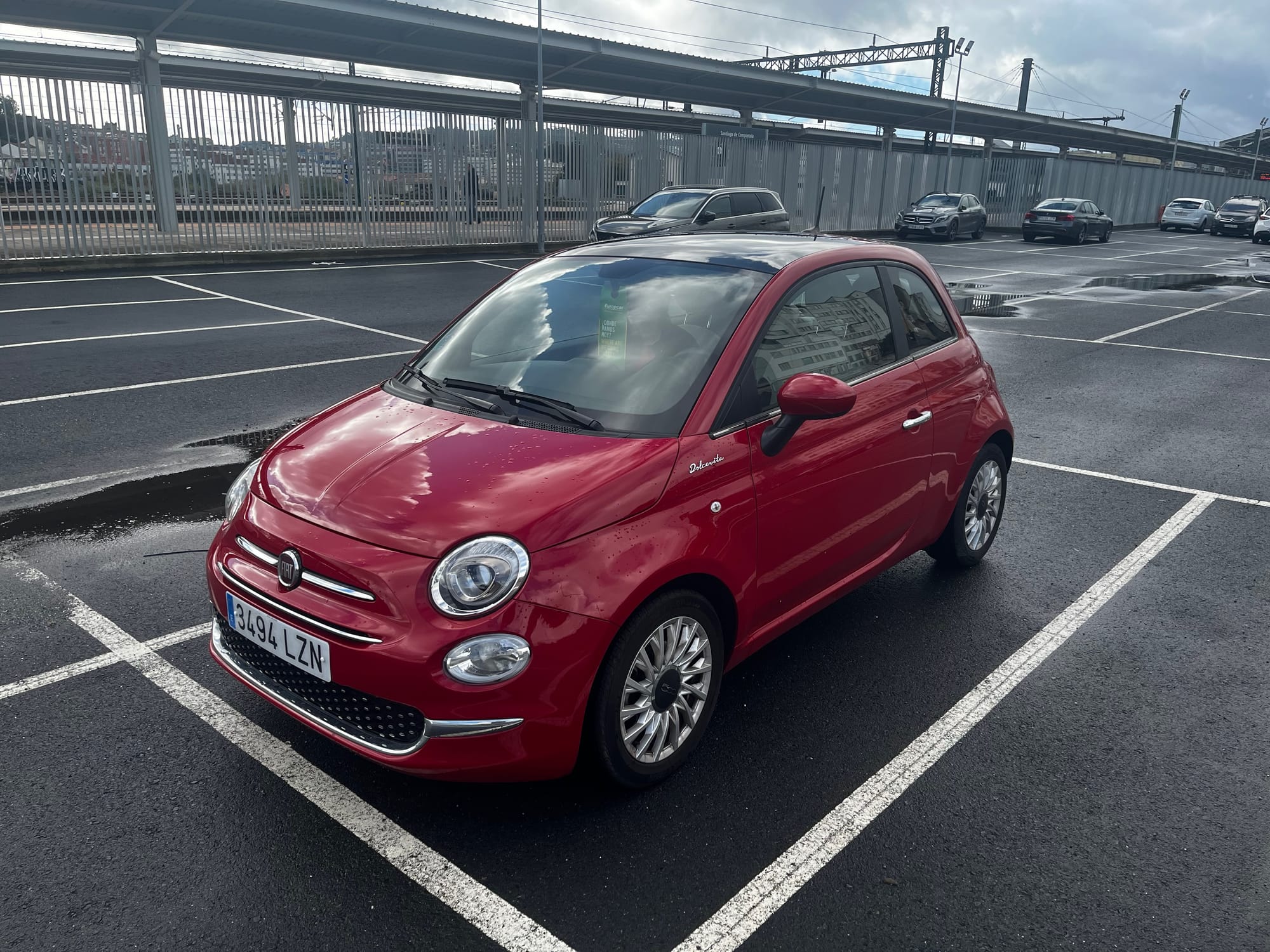
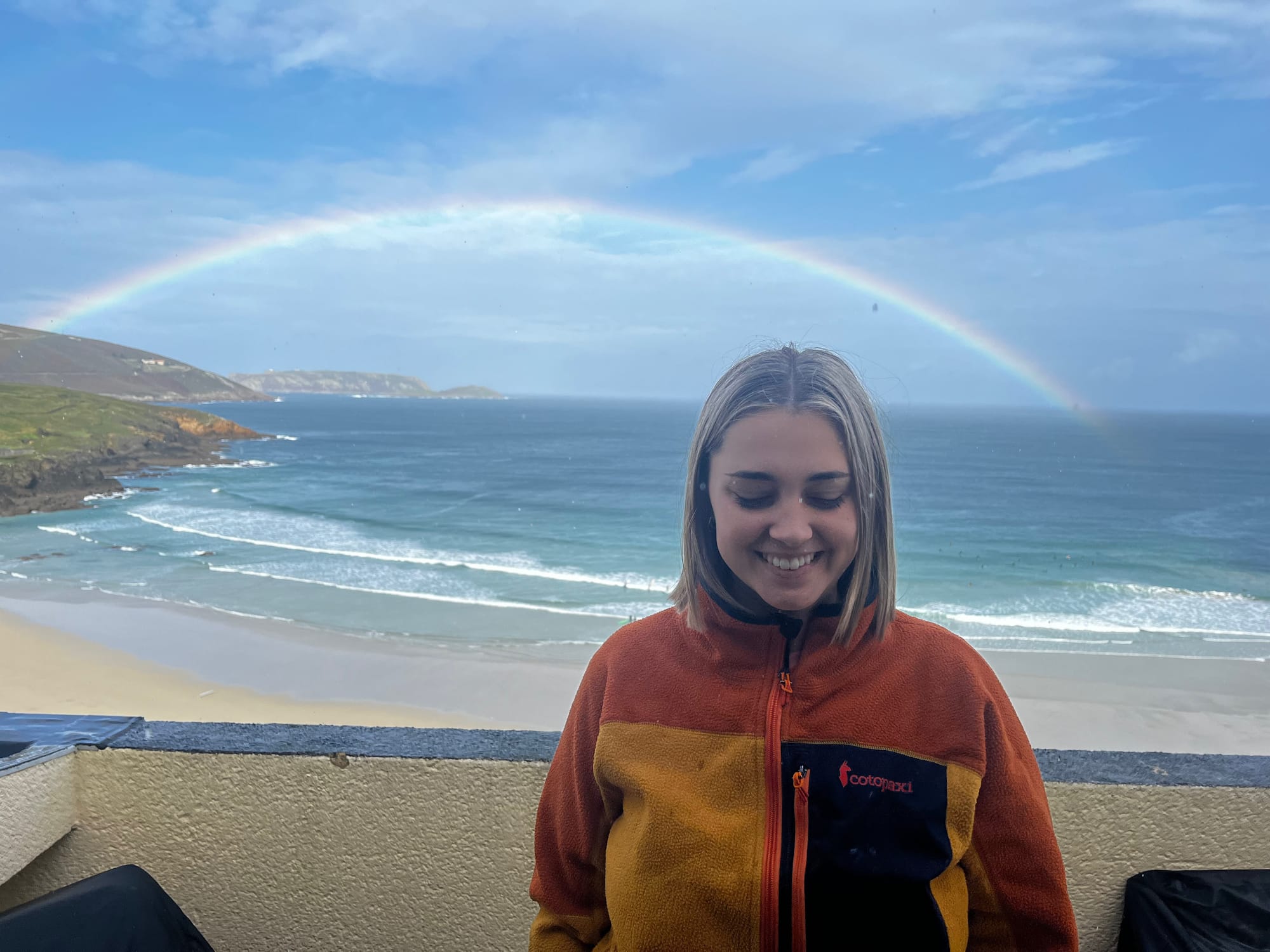
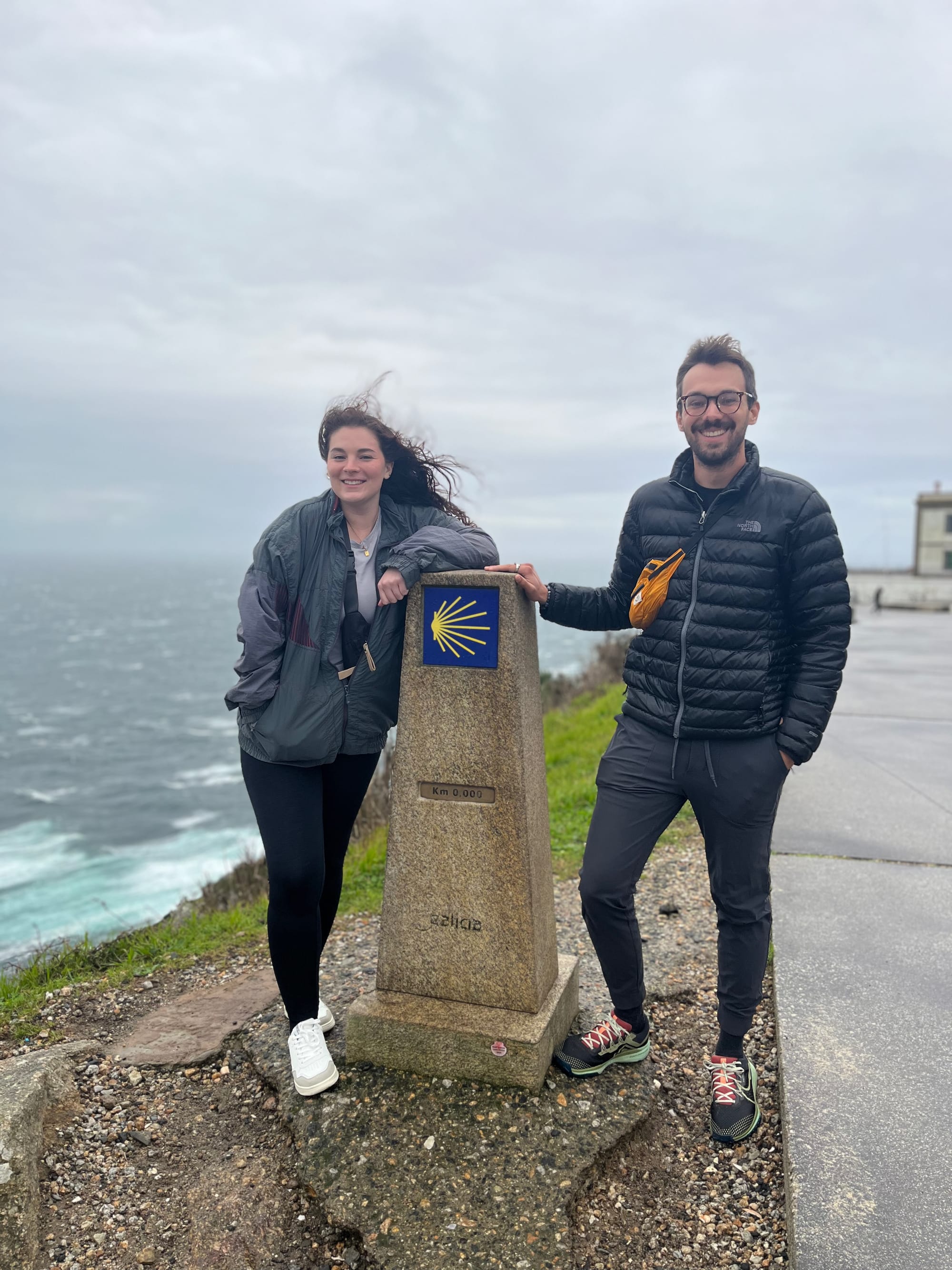
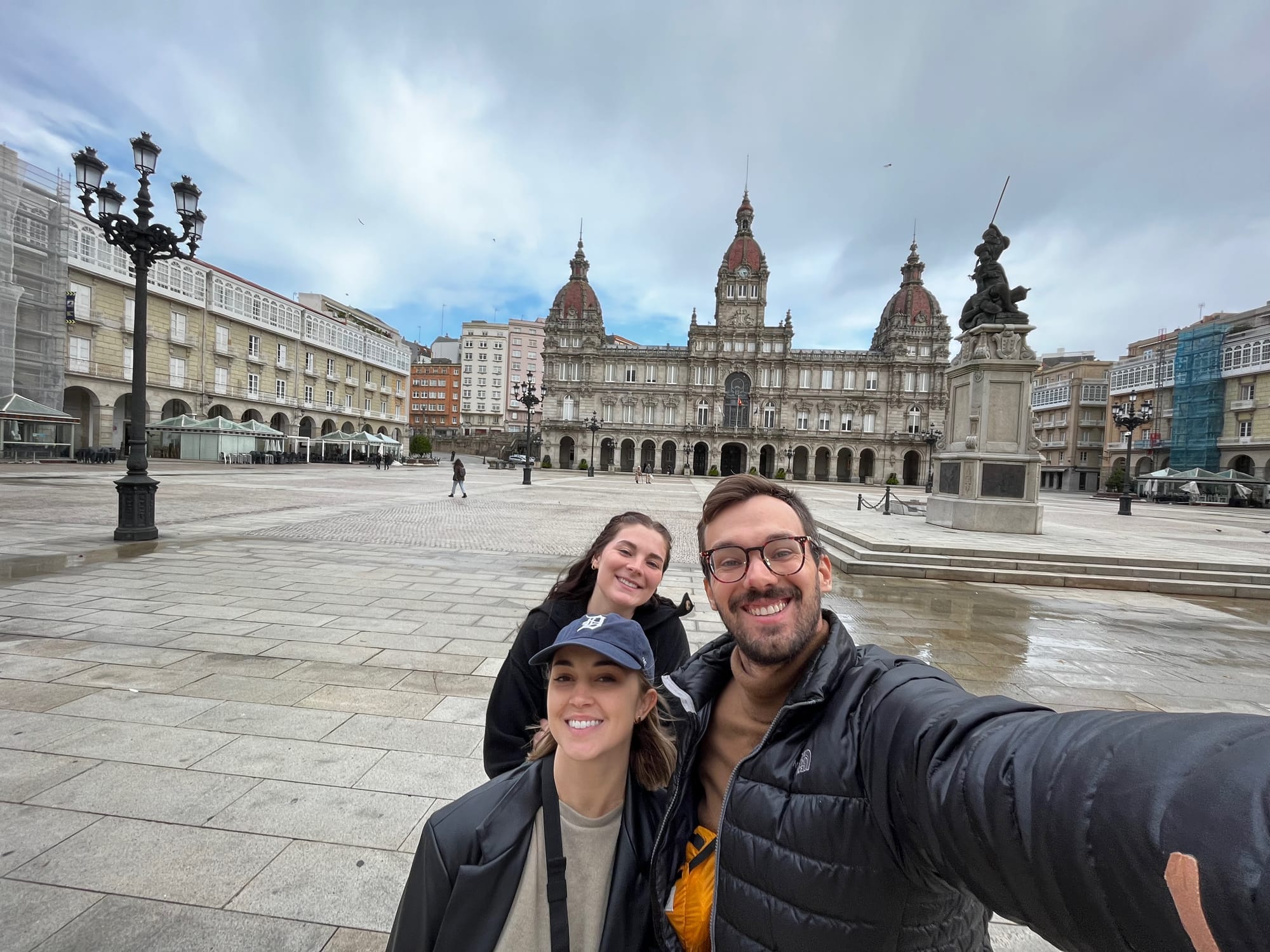
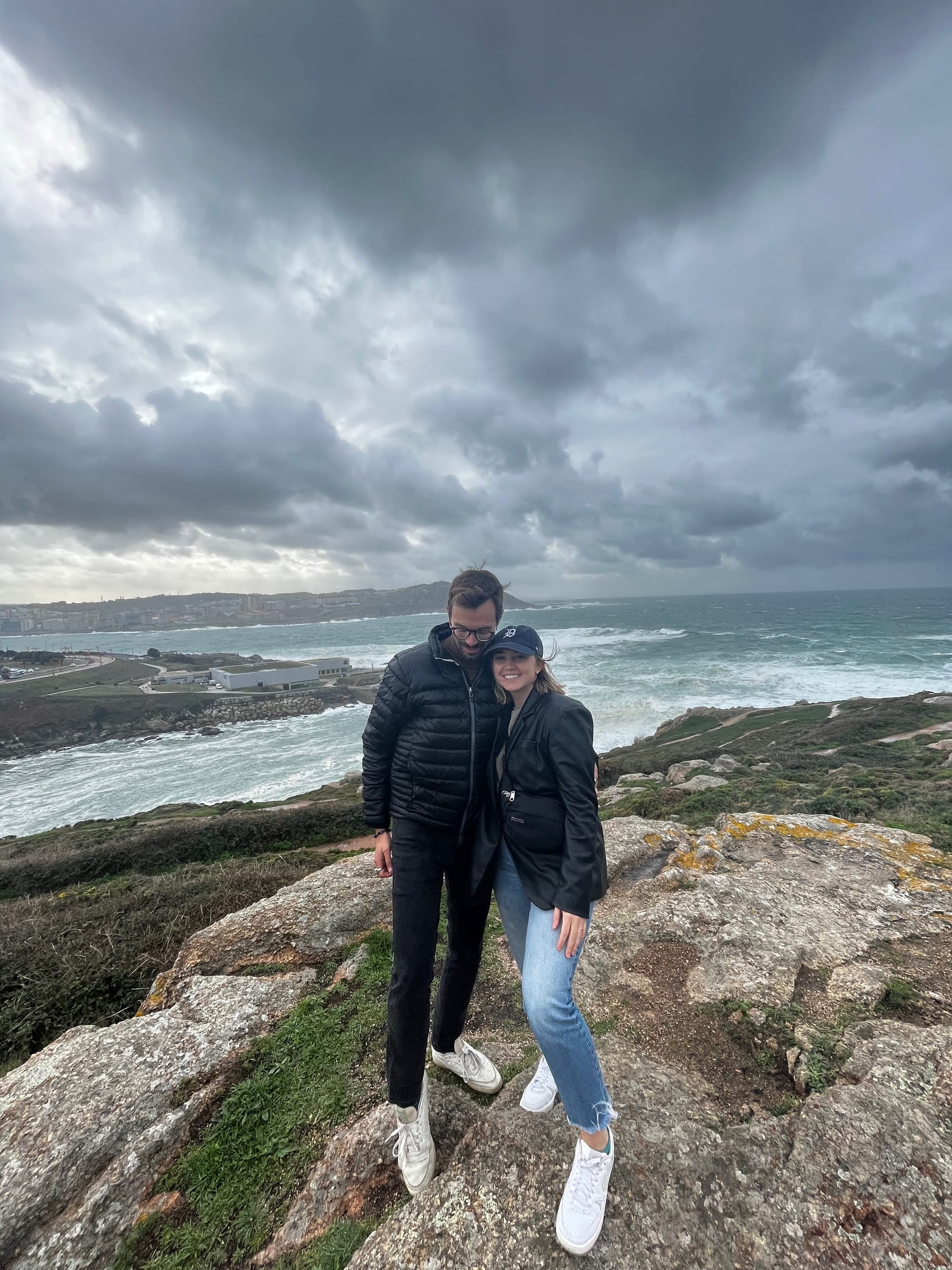
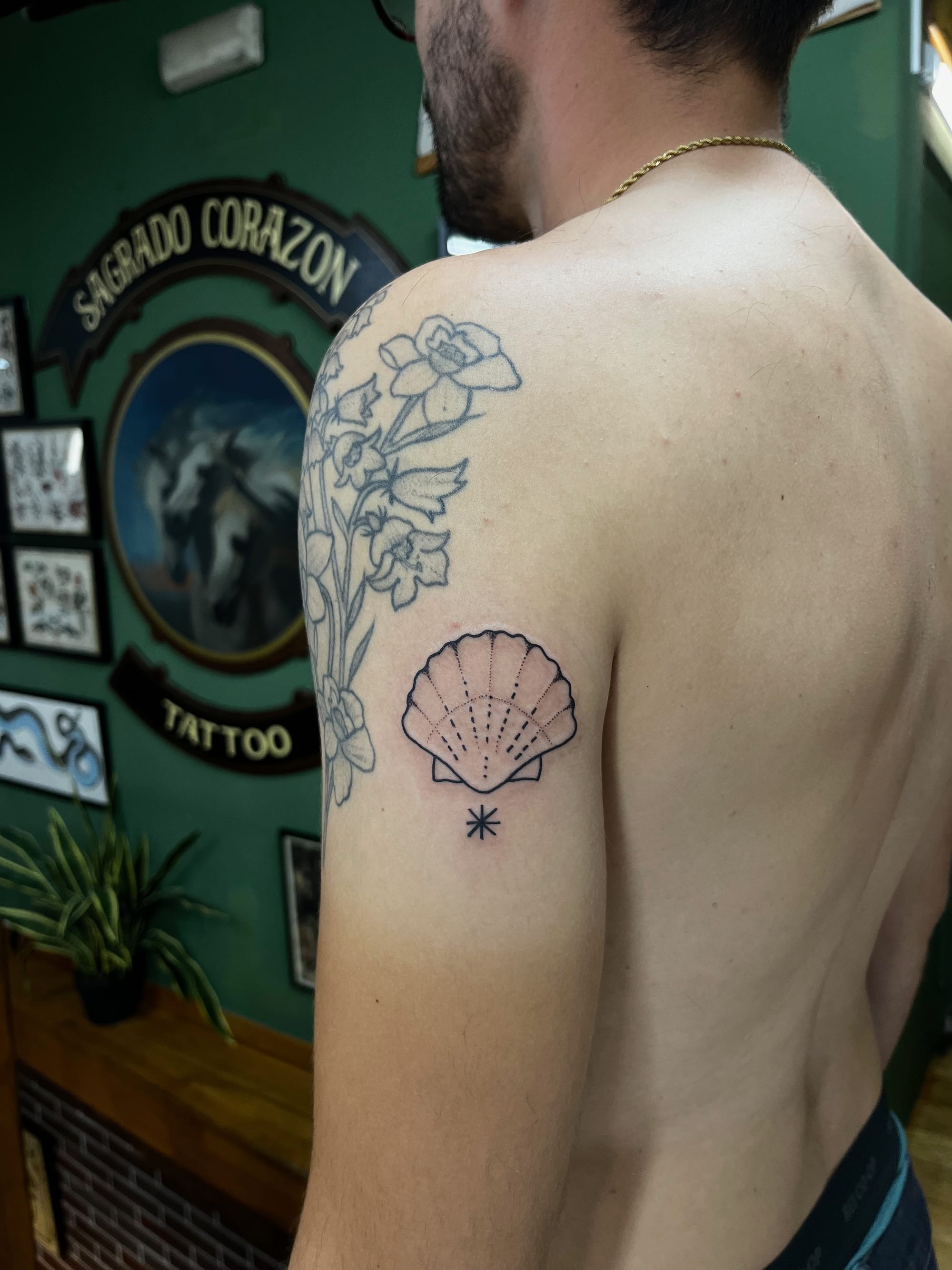
Clockwise: our red Fiat, Maddy on our seaside terrace, Abby and I at the 0km marker in Finisterre, my tattoo, Maddy and I in A Coruña, Maddy, Abby, and I in the center of A Coruña
Advice for anyone doing the Camino
Before I share my advice for other pilgrims, I want to emphasize that there is no right or wrong way to walk the Camino. The important thing is to do what feels right for you.
For some that might mean walking from St. Jean to Santiago, for others it might mean starting in Sarria or walking the Camino gradually. Some might prefer hotels while others choose hostels.
My advice is based on my experiences, but if it doesn’t feel right to you, trust your gut.
Just do it
The most important advice I can give you for your Camino is to go.
If you’ve ever thought about walking the Camino de Santiago, or any other big adventure like it, do it.
The experience exceeded my expectations. It's one of my proudest accomplishments.
If you can’t take off two months to do the entire thing in one go, that's okay. I met people who were walking one or two sections, and many had been walking a section every year until they could complete the entire trek.
Do it solo if you can
Walking the Camino solo is scary, but worth it. And it’s a lot easier than it seems. It’s easier to make friends on the Camino than it is to find time to yourself.
It’s ironic, but I do believe the Camino is a time to be selfish. It’s a time to walk your own walk.
Going by yourself pushes you to provide for yourself or ask for help from strangers. It pushes you to make friends when you might otherwise lean on your existing relationships. It means you get to choose how to walk, where to walk, when to walk - the experience is exactly what you want or need.
I loved having first my friend Ramy, and then my sister and Maddy join me on my Camino. It was incredible to share the experience with them. But matching our paces and goals was hard at times.
Even with my Camino family, there were times where I felt like I was modifying my walk to stay with them. I decided it was a worthwhile tradeoff, and I don’t regret it. But there was tension.
So I encourage you to walk at least part of the Camino solo.
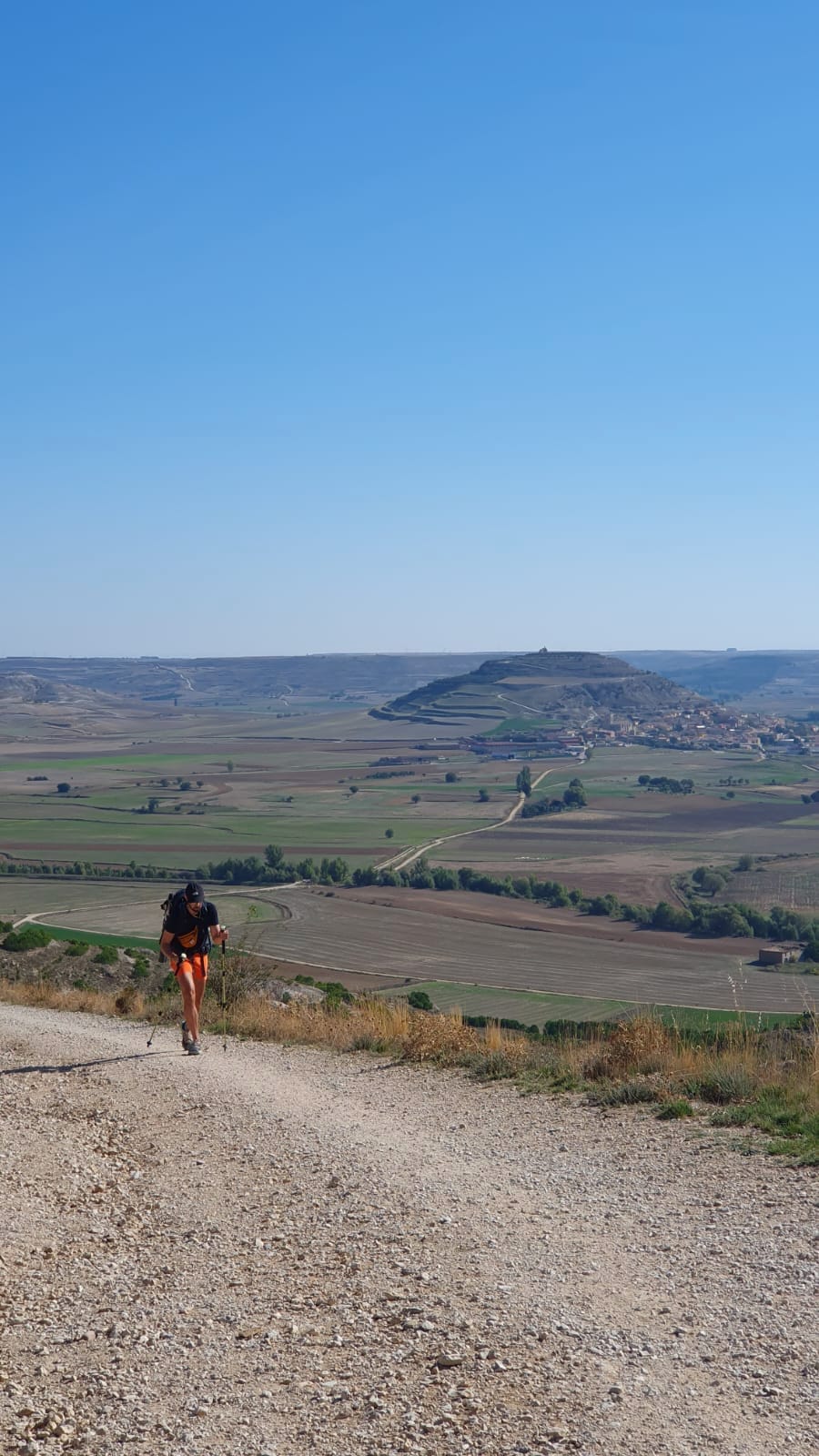
I acknowledge that this advice is easier as a man. I met many women walking their Camino solo. And the vast majority didn’t have any negative experiences being alone. But I did have friends who had run-ins with men on the trail that made them uncomfortable. I believe the Camino is largely safe, but it isn’t without its risks, and those risks are unfortunately amplified for women.
Take less than you think you need
If you're not slightly uncomfortable with how little you packed, you've packed too much. A few extra pounds on your back can make a big difference.
I only brought 2 shirts and never felt the need for more (see my entire packing list). Some of my friends with heavier packs struggled with shoulder and hip pain, while I hardly noticed my pack weight. And I still took things I barely used.
Something hard to grasp before you go is how accessible things are on the trail. Unlike the Appalachian Trail, where resupply opportunities are days apart, the Camino has many shops along the way to buy things you need.
I started with 2 pairs of Darn Tough socks and one pair of Injinji toe socks. I quickly found out the Injinji socks worked better for me to prevent blisters, so I bought another pair from a shop a few days in.
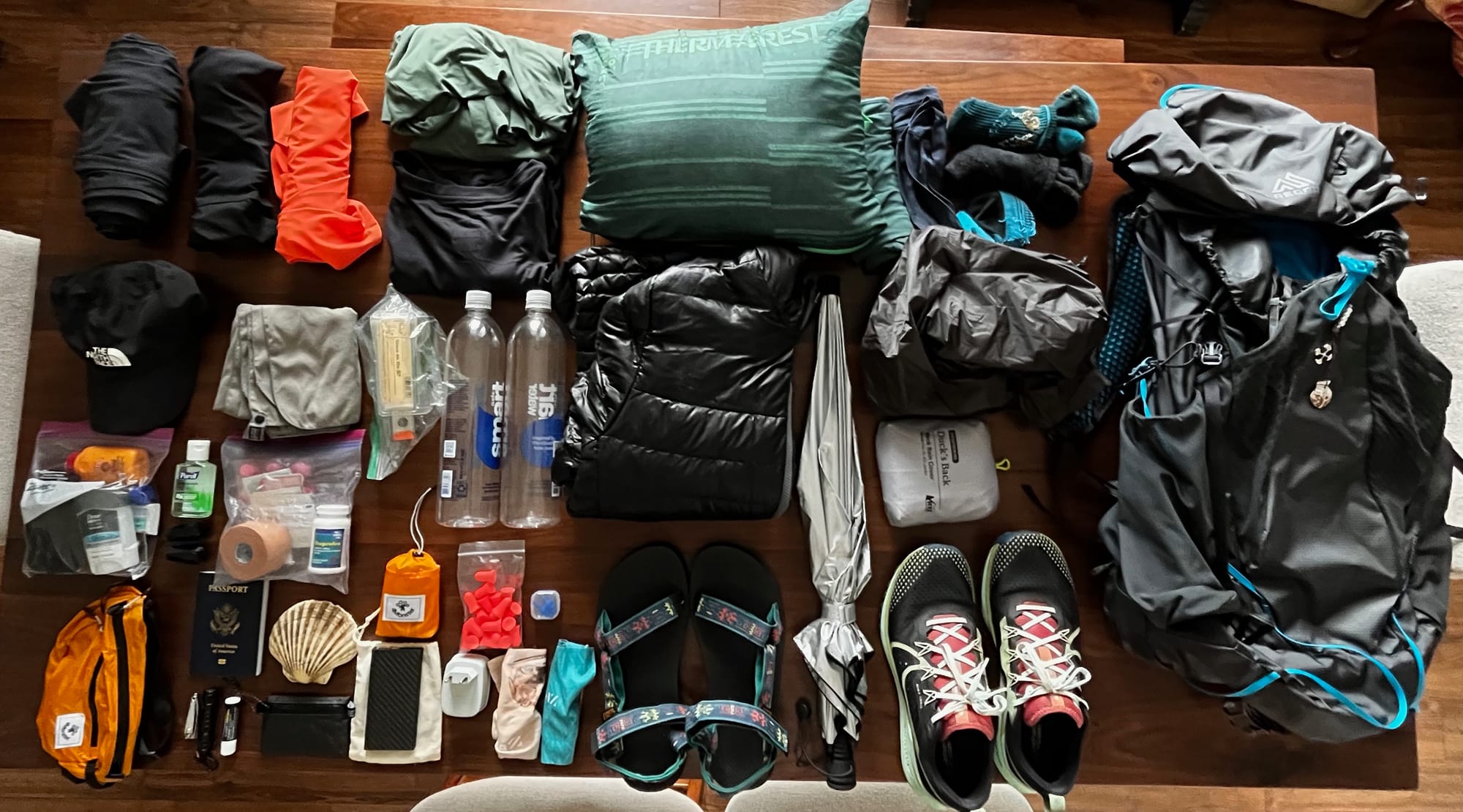
Do bring a comfy pair of town shoes and a deck of cards
One thing worth the weight is a pair of light, comfortable town shoes. Some people wear them in the showers. I didn’t because I didn’t like walking around in wet shoes after.
After a day of walking in trail runners, flip flops or sandals give your feet a chance to breathe and loosen up. And almost every albergue will require you to take off your trail shoes before you enter. So without town shoes you’ll be walking around barefoot.
I left my foam-soled Tevas at a friend's house before starting my Camino. I went a couple of days without town shoes, and it was not fun. Then I bought cheap plastic flip flops, which were better. My friend eventually (kindly) mailed me my Tevas, and those were an even bigger upgrade. The extra cushioning was lifesaving for my throbbing feet at the end of the day.
My sister brought an old pair of Chacos for her town shoes. When her hiking shoes gave her horrible blisters, she hiked in her Chacos instead. A bunch of people (like my friend Sarah) did the same.
A luxury item that I also think is worth it, especially if you’re nervous about making friends, is a deck of cards. Jay had two card games, a chess board, and a tent AND somehow the smallest bag out of all of us. We played cards in the albergue every night for the first few weeks and it was an incredible way to meet people. People would stop and ask what we were playing and we’d invite them to join in.
Go for training hikes with your gear before you leave
The best way to prepare your body for the Camino and vet your gear is to put your pack on and start walking. I went on 4 shakedown trips - 3 backpacking, one car camping with long day hikes. On each, I learned things about my gear and setup that helped me feel more prepared. With each trip I could feel my body adjusting to walking long distances again after years away from hiking.
While some friends managed without preparation, I noticed a difference in the physical toll the Camino took on most people who hadn’t done any training hikes versus those who had done some.
Learn enough Spanish to order a beer
You don’t need to know Spanish to walk the Camino. English is actually more useful among pilgrims. I met more fluent English speakers than pilgrims who knew even conversational Spanish.
But I was surprised how few people in the towns spoke English comfortably. Most know enough for basic communication, and helpful pilgrims are willing to translate. Knowing enough for essentials like ordering a beer, checking in, asking for directions, will make things easier. Learning enough for simple conversations will enhance your experience.
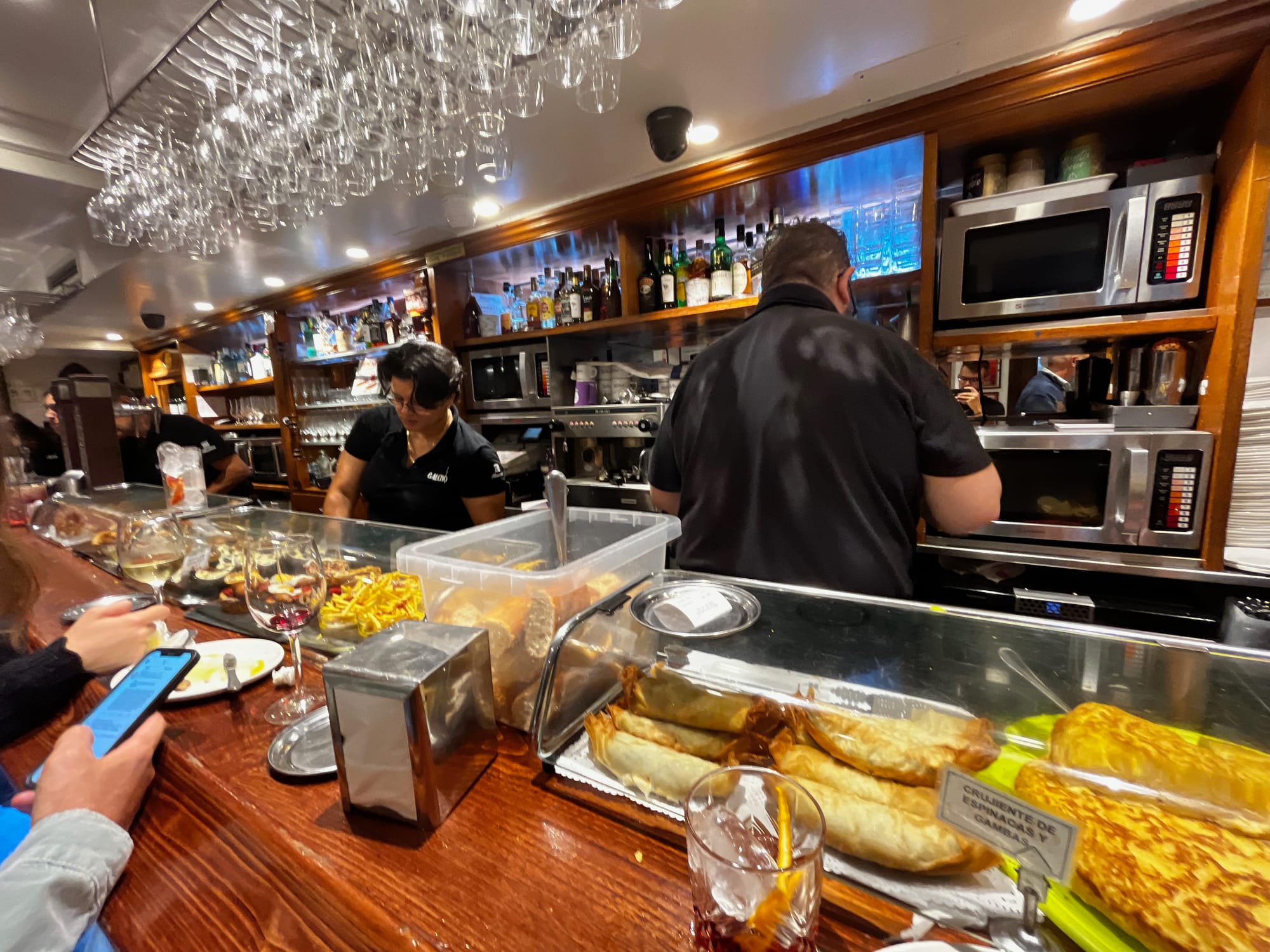
Treat blisters as soon as they show up
A final bit of small, tactical advice. Treat your damn blisters as soon as you feel them.
I had friends who ignored their blisters, waiting until the end of the day to check their feet. The result: massive, hard-to-treat blisters.
Meanwhile, those of us who quickly treated ours had few problems.
If you feel a hot spot forming, take your shoes off, let your feet air out, and then cover it. Leukotape is the best for this.
If you don’t catch it and you have a blister, drain it with a sterilized knife or needle, leave the skin, and then cover it. At night, let it air out, and in the morning, cover it again. The skin will harden and you’ll end up with calluses and healthy feet.
I also found that taking my shoes and socks off during breaks made a massive difference in how my feet felt throughout the long days.
Biggest takeaways from my Camino
I want to end with a few of the big thoughts or takeaways I was left with after my Camino.
The Camino is hard, that’s what makes it worth doing
At some point, the Camino will challenge you, no matter who you are.
For me, the first few days felt easy. I was having fun, walking fast, and felt great. Then it caught up to me.
First, my shins and ankles hurt so much I thought I had a stress fracture and might have to stop. Then I got sick and had my first run-in with bedbugs. I was struggling and couldn’t tell if I should stop or keep going.
Finally, there was the serious bed bug infestation. I was covered in bites and couldn’t tell if I had gotten rid of them or not. They got into my head and I couldn’t stop obsessing over them.
But throughout it all, I still felt lighter than I did at home.
The challenges will be different for you, and probably won’t be what you expect. But they’re what make the experience worth it. The Camino is a pilgrimage, it’s a chance to test and push yourself. The physical challenges force you to be in the moment, and make everything feel more intense and more valuable. At least to me.
It’s easier to make friends on the Camino than to be alone
So many people were shocked I was doing the Camino alone. I was nervous starting out. Would I make friends? How long would it take?
But I quickly found that it's easier to make friends on the Camino than to be alone. The Camino is incredibly popular, so there are people around constantly. You’ll pass them walking, then they’ll catch up while you’re stopped at the next bar.
Striking up conversation might feel awkward for the first day or two, but then it becomes natural.
“Hi, how are you?”
“Where are you from?”
“Where did you start? Where are you walking to?”
Friends come and go as you walk at different paces, but there are constantly new people just around the corner.
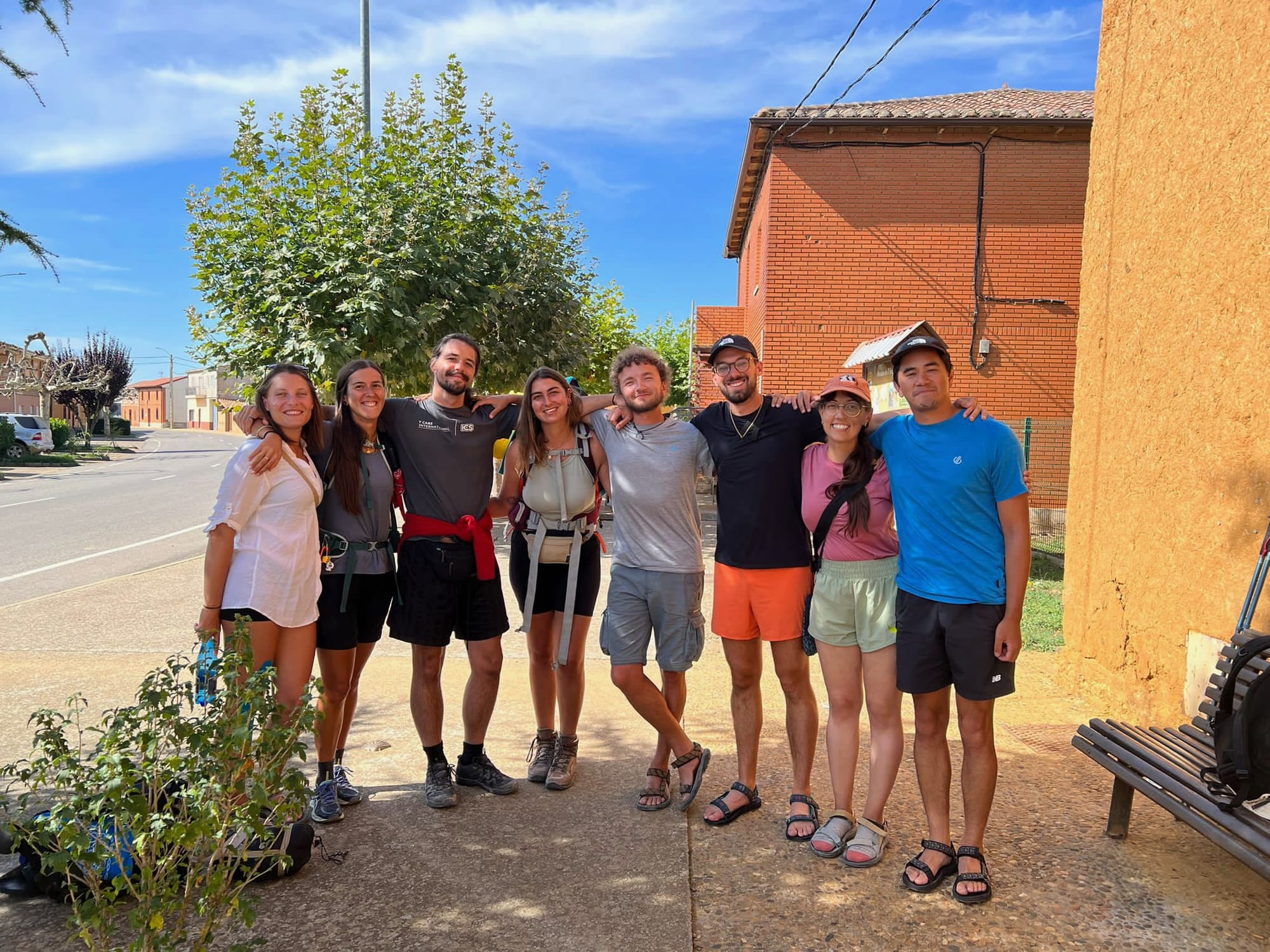
The people are the best part
Building on the takeaway above, the people were the best part of my Camino.
While there were people who rubbed me the wrong way, the vast majority I met were friendly, kind, open-minded, generous, and thoughtful. I had interesting conversations and met people from so many different walks of life. From Japanese sailors to Alaskan fishermen, Danish caretakers, and German teachers.
I was nervous the Camino would feel too crowded, but for me that couldn’t have been further from the truth. I loved being surrounded by people from all over the world.
Part of me has always wanted to hike the Appalachian Trail in America, but I have stayed away in part because of how crowded it’s become (and because it’s a massive 6-month commitment).
After the Camino, my number one goal is to hike the Appalachian Trail in the near future. Though I am going to take a break for this year at least.
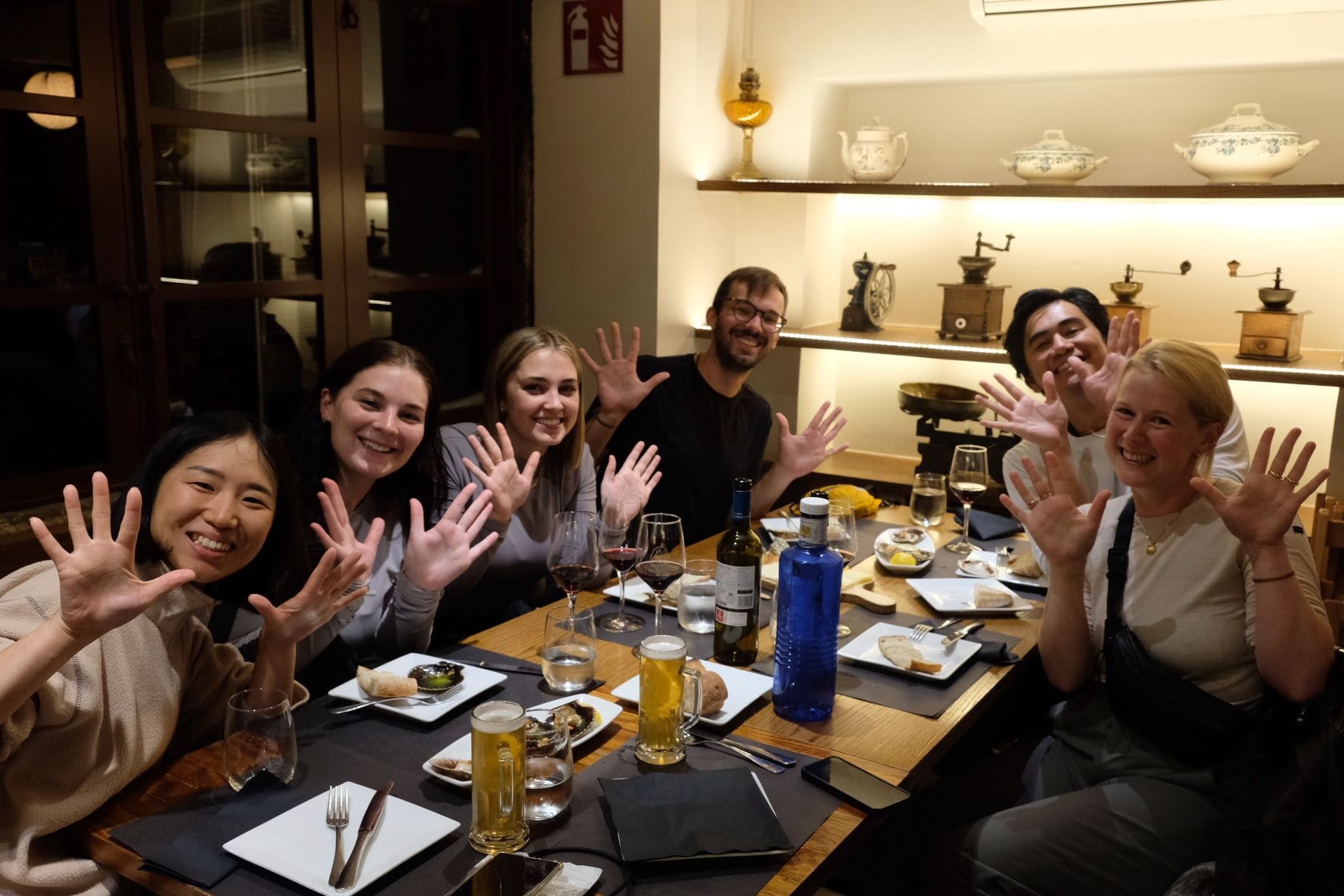
Being multilingual is a superpower
Before the Camino, I spent several months taking Spanish lessons so that when I got there I could at least get by.
While I could communicate, my multilingual friends could build relationships.
I was in awe of people who could easily switch between Spanish, Dutch, French, Korean, English. It opened up so many opportunities and friendships.
Speaking someone's native language earns instant appreciation and respect.
So another goal I’m bringing away from the Camino is to finally become fluent in Spanish.
Although it was sometimes equally as cool to see how much you could communicate with someone when you didn’t speak the same language. My good friend Akari spoke a little English and almost no Spanish. Sometimes we would communicate by passing a phone back and forth.
It’s amazing how happy you can be with so little
I started my walk staying mostly in smaller, private albergues. I was afraid of the stories about noise, smells, and dirty, crowded bathrooms in the big, cheap, municipal albergues. But after making friends with Jay, I spent the night in one and never looked back.
There were trade-offs: sometimes you had loud snoring, crowded rooms, and long shower lines. But they were absolutely worth the community and belonging I felt in those public albergues. And some of the best, most comfortable places I stayed on my entire walk were public or even donation-based.
It quickly hit me how happy I was, and how little money I was spending. I had so few things with me, I was staying in the cheapest possible lodgings, I was eating simply, and my mind felt lighter and clearer than it had in years.
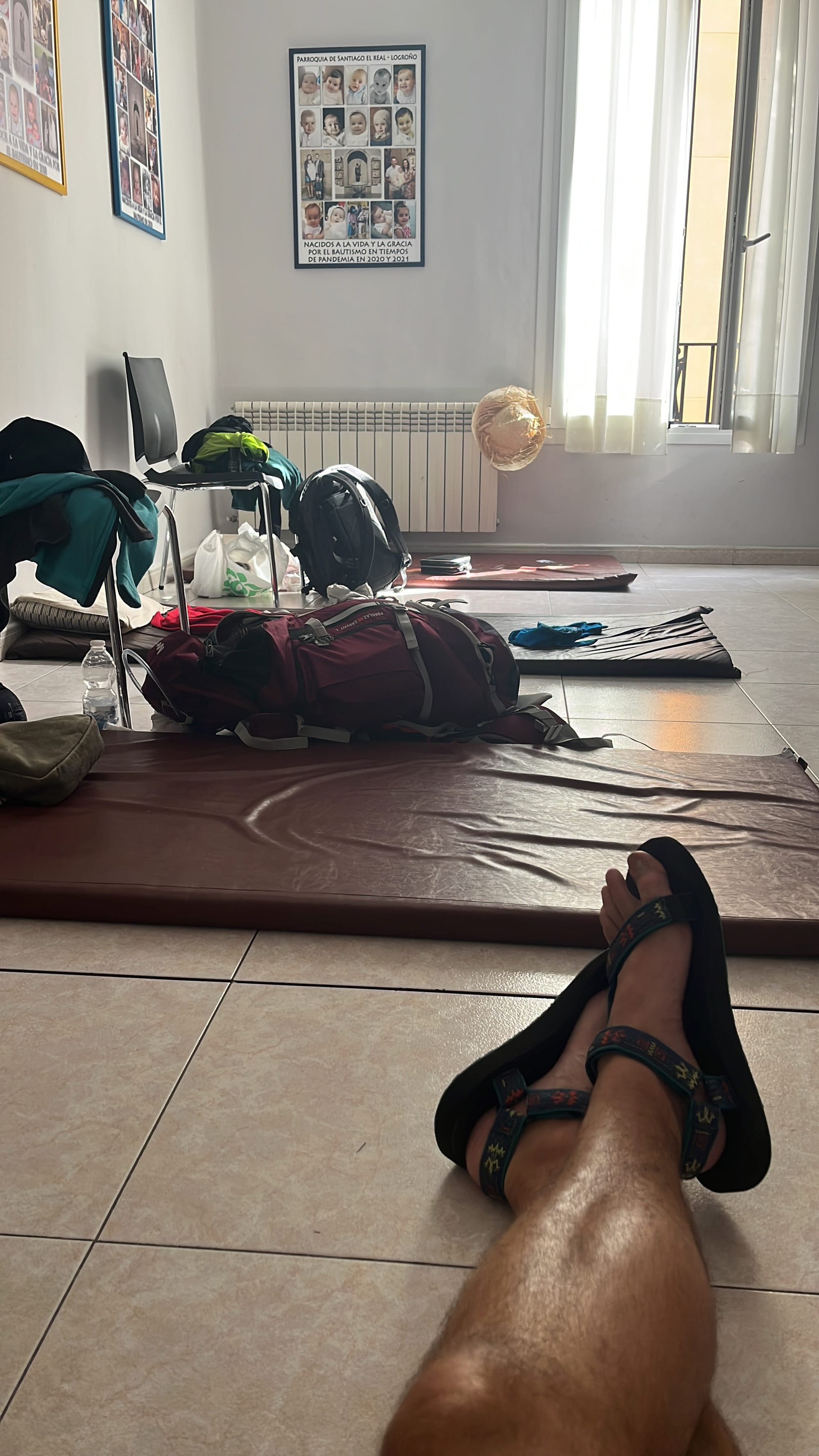
I don’t intend to become a hermit or a monk and forsake all worldly possessions. I’ve enjoyed being home and having my cozy office, my kitchen and my bar, my closet with more than two shirts. But I think a lifestyle-reset type of experience like the Camino every few years could be a powerful thing. And I hope to hold on to the reminder that when I gave it all up and stayed in the cheapest possible places, I was really happy, at least for a while.
Find your Camino
If you’ve made it this far, thank you for reading. I hope this post was interesting, and that it inspires you to walk the Camino someday, or to find your own Camino.
When my friends met my sister, they would ask her, “So are you going to come back and walk the Camino yourself?” She would laugh and say, “No, this is is really his thing.”
Find your thing. It might just be the best thing you ever do.
